

Table of SynGAP1 Isoform α2 (UniProt Q96PV0-1) Missense Variants.
| c.dna | Variant | SGM Consensus | Domain | ClinVar | gnomAD | ESM1b | AlphaMissense | REVEL | FoldX | Rosetta | Foldetta | PremPS | PROVEAN | PolyPhen-2 HumDiv | PolyPhen-2 HumVar | FATHMM | SIFT | PAM | Physical | SASA | Normalized B-factor backbone | Normalized B-factor sidechain | SynGAP Structural Annotation | DOI | |||||||||||||||||||||||||||||||||
|---|---|---|---|---|---|---|---|---|---|---|---|---|---|---|---|---|---|---|---|---|---|---|---|---|---|---|---|---|---|---|---|---|---|---|---|---|---|---|---|---|---|---|---|---|---|---|---|---|---|---|---|---|---|---|---|---|---|
| Clinical Status | Review | Subm. | ID | Allele count | Allele freq. | LLR score | Prediction | Pathogenicity | Class | Optimized | Score | Prediction | Average ΔΔG | Prediction | StdDev | ΔΔG | Prediction | ΔΔG | Prediction | ΔΔG | Prediction | Score | Prediction | pph2_prob | Prediction | pph2_prob | Prediction | Nervous System Score | Prediction | Prediction | Status | Conservation | Sequences | PAM250 | PAM120 | Hydropathy Δ | MW Δ | Average | Δ | Δ | StdDev | Δ | StdDev | Secondary | Tertiary bonds | Inside out | GAP-Ras interface | At membrane | No effect | MD Alert | Verdict | Description | |||||
| c.3520G>A | E1174K 2D 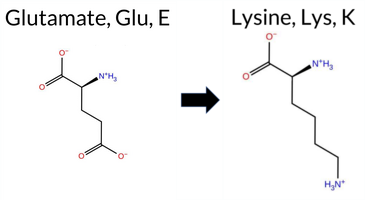 AIThe SynGAP1 missense variant E1174K is listed in ClinVar with an uncertain significance (ClinVar ID 1905754.0) and is present in gnomAD (variant ID 6‑33444555‑G‑A). Functional prediction tools that agree on a benign effect include REVEL, PROVEAN, polyPhen‑2 HumVar, ESM1b, and FATHMM, while those that predict a pathogenic outcome are polyPhen‑2 HumDiv, SIFT, and AlphaMissense‑Default. The high‑accuracy consensus from SGM (majority vote of AlphaMissense‑Default, ESM1b, FATHMM, and PROVEAN) yields a “Likely Benign” classification, matching the reported SGM‑Consensus result. AlphaMissense‑Optimized is uncertain, and no Foldetta stability assessment is available. Taken together, the majority of evidence points to a benign effect, and this conclusion does not contradict the ClinVar uncertain status. Disclaimer: This summary was generated using AI and should be interpreted alongside expert review. | Likely Benign | Coiled-coil | Uncertain | 1 | 6-33444555-G-A | 2 | 1.24e-6 | -4.345 | Likely Benign | 0.898 | Likely Pathogenic | Ambiguous | 0.442 | Likely Benign | -1.59 | Neutral | 0.962 | Probably Damaging | 0.367 | Benign | 5.52 | Benign | 0.03 | Affected | 4.32 | 2 | 0 | 1 | -0.4 | -0.94 | ||||||||||||||||||||||||||
| c.3529G>A | E1177K 2D  AISynGAP1 missense variant E1177K is listed in ClinVar with an Uncertain significance status and is not reported in gnomAD. Functional prediction tools show a split: benign calls come from PROVEAN, SIFT, ESM1b, and FATHMM, while pathogenic calls come from REVEL, polyPhen‑2 HumDiv, polyPhen‑2 HumVar, and AlphaMissense‑Default. High‑accuracy assessments give AlphaMissense‑Optimized as Uncertain, SGM‑Consensus (majority vote of AlphaMissense‑Default, ESM1b, FATHMM, PROVEAN) as Likely Benign, and Foldetta stability analysis is unavailable. Overall, the balance of evidence leans toward a benign effect, which does not contradict the ClinVar designation of Uncertain. Disclaimer: This summary was generated using AI and should be interpreted alongside expert review. | Likely Benign | Coiled-coil | Uncertain | 1 | -3.413 | Likely Benign | 0.944 | Likely Pathogenic | Ambiguous | 0.560 | Likely Pathogenic | -1.75 | Neutral | 0.905 | Possibly Damaging | 0.637 | Possibly Damaging | 5.44 | Benign | 0.11 | Tolerated | 4.32 | 2 | 0 | 1 | -0.4 | -0.94 | |||||||||||||||||||||||||||||
| c.3557C>T | S1186L 2D 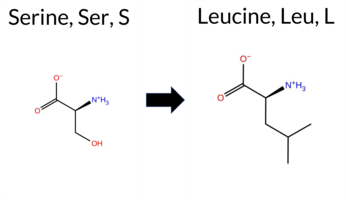 AIThe SynGAP1 missense variant S1186L (ClinVar ID 930096.0) is listed as Uncertain in ClinVar and is present in gnomAD (ID 6‑33444592‑C‑T). Prediction tools that agree on a benign effect include REVEL, ESM1b, and FATHMM, whereas those that predict a pathogenic effect are PROVEAN, polyPhen‑2 HumDiv, polyPhen‑2 HumVar, SIFT, and AlphaMissense‑Default. AlphaMissense‑Optimized reports an uncertain outcome. The high‑accuracy consensus (SGM Consensus) derived from AlphaMissense‑Default, ESM1b, FATHMM, and PROVEAN yields a tie, leaving the result inconclusive. Foldetta, which integrates FoldX‑MD and Rosetta stability calculations, has no available output for this variant. Overall, the majority of evidence points toward a pathogenic impact, and this assessment does not contradict the ClinVar Uncertain classification. Disclaimer: This summary was generated using AI and should be interpreted alongside expert review. | Coiled-coil | Uncertain | 1 | 6-33444592-C-T | -4.829 | Likely Benign | 0.923 | Likely Pathogenic | Ambiguous | 0.177 | Likely Benign | -2.58 | Deleterious | 0.998 | Probably Damaging | 0.992 | Probably Damaging | 2.65 | Benign | 0.04 | Affected | 3.82 | 4 | -3 | -2 | 4.6 | 26.08 | |||||||||||||||||||||||||||||
| c.3567G>C | E1189D 2D  AIThe SynGAP1 missense variant E1189D (gnomAD ID 6-33444602‑G‑C) is listed in ClinVar as Benign (ClinVar ID 833989.0). In silico predictors that agree on a benign effect include REVEL, PROVEAN, SIFT, ESM1b, FATHMM, AlphaMissense‑Optimized, and the SGM‑Consensus score (Likely Benign). Predictors that indicate a pathogenic effect are PolyPhen‑2 HumDiv and PolyPhen‑2 HumVar. The high‑accuracy AlphaMissense‑Optimized tool classifies the variant as benign, and the SGM‑Consensus, derived from a majority vote of AlphaMissense‑Default, ESM1b, FATHMM, and PROVEAN, also favors a benign outcome. No Foldetta stability assessment is available for this residue. Overall, the majority of evidence points to a benign impact, and this conclusion aligns with the ClinVar designation, showing no contradiction. Disclaimer: This summary was generated using AI and should be interpreted alongside expert review. | Likely Benign | Coiled-coil | Likely Benign | 1 | 6-33444602-G-C | 3 | 1.86e-6 | -3.582 | Likely Benign | 0.461 | Ambiguous | Likely Benign | 0.359 | Likely Benign | -1.42 | Neutral | 0.992 | Probably Damaging | 0.989 | Probably Damaging | 5.30 | Benign | 0.25 | Tolerated | 3.82 | 4 | 3 | 2 | 0.0 | -14.03 | ||||||||||||||||||||||||||
| c.3572G>A | R1191Q 2D  AIThe SynGAP1 missense variant R1191Q is listed in ClinVar with an “Uncertain” status and is present in gnomAD (variant ID 6‑33444607‑G‑A). Prediction tools that agree on a benign effect include REVEL, PROVEAN, SIFT, ESM1b, and FATHMM, while polyPhen‑2 (HumDiv and HumVar) and AlphaMissense‑Default predict a pathogenic outcome. The SGM‑Consensus, which aggregates AlphaMissense‑Default, ESM1b, FATHMM, and PROVEAN, reports a “Likely Benign” classification. High‑accuracy assessments show AlphaMissense‑Optimized as “Uncertain”; the SGM‑Consensus (majority vote) remains “Likely Benign”; and Foldetta (a protein‑folding stability method combining FoldX‑MD and Rosetta) has no available result for this variant. Overall, the majority of evidence points to a benign effect, and this is not contradictory to the ClinVar “Uncertain” designation. Disclaimer: This summary was generated using AI and should be interpreted alongside expert review. | Likely Benign | Coiled-coil | Uncertain | 2 | 6-33444607-G-A | 9 | 5.58e-6 | -1.069 | Likely Benign | 0.943 | Likely Pathogenic | Ambiguous | 0.343 | Likely Benign | -1.41 | Neutral | 0.998 | Probably Damaging | 0.992 | Probably Damaging | 2.68 | Benign | 0.08 | Tolerated | 3.82 | 4 | 1 | 1 | 1.0 | -28.06 | ||||||||||||||||||||||||||
| c.3574C>G | L1192V 2D 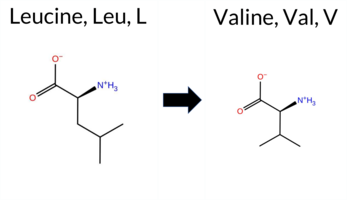 AIThe SynGAP1 missense variant L1192V is listed in ClinVar with an “Uncertain” status and is not reported in gnomAD. Functional prediction tools that agree on a benign effect include REVEL, PROVEAN, SIFT, ESM1b, FATHMM, AlphaMissense‑Optimized, and the SGM‑Consensus (majority vote from AlphaMissense‑Default, ESM1b, FATHMM, PROVEAN). In contrast, polyPhen‑2 (both HumDiv and HumVar models) predict a pathogenic impact. The high‑accuracy AlphaMissense‑Optimized score is benign, and the SGM‑Consensus also indicates a likely benign outcome; Foldetta results are unavailable. Overall, the majority of evidence points to a benign effect, and this is consistent with the ClinVar “Uncertain” classification rather than contradicting it. Thus, based on current predictions, the variant is most likely benign. Disclaimer: This summary was generated using AI and should be interpreted alongside expert review. | Likely Benign | Coiled-coil | Uncertain | 1 | -4.132 | Likely Benign | 0.471 | Ambiguous | Likely Benign | 0.041 | Likely Benign | -0.89 | Neutral | 0.779 | Possibly Damaging | 0.527 | Possibly Damaging | 2.69 | Benign | 0.16 | Tolerated | 2 | 1 | 0.4 | -14.03 | |||||||||||||||||||||||||||||||
| c.3595G>A | E1199K 2D  AIThe SynGAP1 missense variant E1199K (ClinVar ID 1026146.0) is listed as Uncertain in ClinVar and is present in gnomAD (ID 6‑33446587‑G‑A). Prediction tools that agree on a benign effect include REVEL, PROVEAN, and FATHMM, whereas tools that agree on a pathogenic effect are polyPhen‑2 HumDiv, polyPhen‑2 HumVar, SIFT, ESM1b, and AlphaMissense‑Default. The high‑accuracy AlphaMissense‑Optimized score is uncertain, and the SGM Consensus (majority vote from AlphaMissense‑Default, ESM1b, FATHMM, PROVEAN) is inconclusive due to a 2‑to‑2 split; Foldetta results are not available. Overall, the majority of evidence points toward a pathogenic impact, which does not contradict the ClinVar Uncertain classification. Disclaimer: This summary was generated using AI and should be interpreted alongside expert review. | Coiled-coil | Uncertain | 1 | 6-33446587-G-A | 1 | 6.20e-7 | -10.853 | Likely Pathogenic | 0.954 | Likely Pathogenic | Ambiguous | 0.171 | Likely Benign | -2.26 | Neutral | 1.000 | Probably Damaging | 0.995 | Probably Damaging | 2.52 | Benign | 0.00 | Affected | 3.77 | 5 | 0 | 1 | -0.4 | -0.94 | |||||||||||||||||||||||||||
| c.3607C>G | H1203D 2D 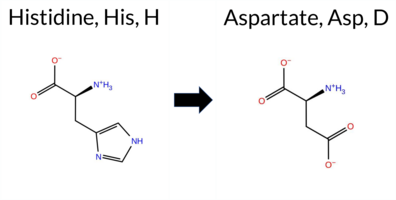 AIThe SynGAP1 missense variant H1203D is listed in ClinVar with an “Uncertain” status and is not reported in gnomAD. Functional prediction tools that agree on a benign effect include REVEL, PROVEAN, polyPhen‑2 HumVar, SIFT, ESM1b, FATHMM, AlphaMissense‑Optimized, and the SGM‑Consensus (majority vote from AlphaMissense‑Default, ESM1b, FATHMM, PROVEAN). Only polyPhen‑2 HumDiv predicts a pathogenic outcome, while AlphaMissense‑Default remains uncertain. High‑accuracy assessments show AlphaMissense‑Optimized as benign and the SGM‑Consensus as “Likely Benign”; a Foldetta stability analysis is unavailable. Overall, the majority of evidence points to a benign impact. This conclusion does not contradict the ClinVar designation, which remains uncertain. Disclaimer: This summary was generated using AI and should be interpreted alongside expert review. | Likely Benign | Coiled-coil | Uncertain | 1 | -6.729 | Likely Benign | 0.525 | Ambiguous | Likely Benign | 0.403 | Likely Benign | -1.89 | Neutral | 0.473 | Possibly Damaging | 0.265 | Benign | 5.51 | Benign | 0.24 | Tolerated | 3.77 | 5 | 1 | -1 | -0.3 | -22.05 | |||||||||||||||||||||||||||||
| c.3607C>T | H1203Y 2D 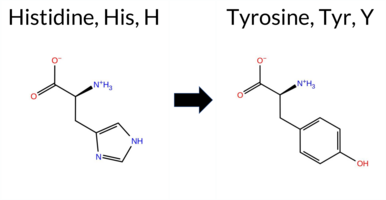 AIThe SynGAP1 missense variant H1203Y is listed in ClinVar with an “Uncertain” status and is present in the gnomAD database (ID 6‑33446599‑C‑T). Functional prediction tools uniformly indicate a benign effect: REVEL, PROVEAN, polyPhen‑2 (HumDiv and HumVar), SIFT, ESM1b, FATHMM, AlphaMissense‑Default, and AlphaMissense‑Optimized all score the variant as benign. No tool predicts pathogenicity. High‑accuracy assessments corroborate this: AlphaMissense‑Optimized is benign; the SGM Consensus (majority vote from AlphaMissense‑Default, ESM1b, FATHMM, and PROVEAN) also yields a benign prediction. Foldetta results are unavailable. Overall, the evidence strongly supports a benign impact for H1203Y, and this conclusion does not contradict the ClinVar “Uncertain” classification. Disclaimer: This summary was generated using AI and should be interpreted alongside expert review. | Likely Benign | Coiled-coil | Uncertain | 1 | 6-33446599-C-T | 2 | 1.24e-6 | -6.834 | Likely Benign | 0.149 | Likely Benign | Likely Benign | 0.233 | Likely Benign | -1.52 | Neutral | 0.006 | Benign | 0.011 | Benign | 5.55 | Benign | 0.10 | Tolerated | 3.77 | 5 | 2 | 0 | 1.9 | 26.03 | ||||||||||||||||||||||||||
| c.3614T>C | L1205P 2D 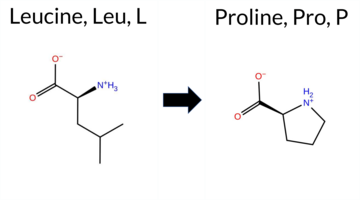 AIThe SynGAP1 missense variant L1205P is listed in ClinVar with an “Uncertain” status and is not reported in gnomAD. All available in silico predictors classify the change as pathogenic: REVEL, PROVEAN, polyPhen‑2 (HumDiv and HumVar), SIFT, ESM1b, FATHMM, AlphaMissense‑Default, and AlphaMissense‑Optimized. No tool predicts a benign effect. High‑accuracy assessments further support a deleterious impact: AlphaMissense‑Optimized is pathogenic, and the SGM Consensus (majority vote of AlphaMissense‑Default, ESM1b, FATHMM, and PROVEAN) is “Likely Pathogenic.” Foldetta, a protein‑folding stability method combining FoldX‑MD and Rosetta outputs, has no available result for this variant. Overall, the computational evidence strongly indicates that the variant is pathogenic, which contradicts the current ClinVar designation of uncertainty. Disclaimer: This summary was generated using AI and should be interpreted alongside expert review. | Likely Pathogenic | Coiled-coil | Uncertain | 1 | -16.878 | Likely Pathogenic | 1.000 | Likely Pathogenic | Likely Pathogenic | 0.536 | Likely Pathogenic | -5.91 | Deleterious | 1.000 | Probably Damaging | 0.999 | Probably Damaging | 1.45 | Pathogenic | 0.00 | Affected | -3 | -3 | -5.4 | -16.04 | |||||||||||||||||||||||||||||||
| c.3631A>G | M1211V 2D 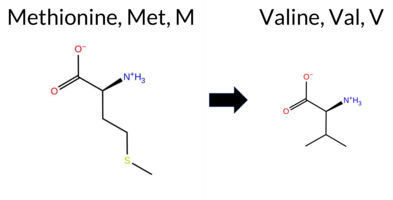 AIThe SynGAP1 missense variant M1211V is listed in ClinVar as Benign (ClinVar ID 3674914.0) and is present in gnomAD (ID 6‑33446623‑A‑G). Prediction tools that agree on a benign effect include REVEL, PROVEAN, SIFT, ESM1b, FATHMM, AlphaMissense‑Default, AlphaMissense‑Optimized, and the SGM‑Consensus (Likely Benign). Tools that predict a pathogenic effect are polyPhen‑2 HumDiv and polyPhen‑2 HumVar. High‑accuracy assessments show AlphaMissense‑Optimized as benign, the SGM‑Consensus as Likely Benign, and Foldetta results are unavailable. Overall, the majority of evidence points to a benign impact, aligning with the ClinVar classification and not contradicting it. Disclaimer: This summary was generated using AI and should be interpreted alongside expert review. | Likely Benign | Coiled-coil | Benign | 1 | 6-33446623-A-G | 3 | 1.86e-6 | -2.101 | Likely Benign | 0.258 | Likely Benign | Likely Benign | 0.412 | Likely Benign | -0.29 | Neutral | 0.932 | Possibly Damaging | 0.949 | Probably Damaging | 5.43 | Benign | 0.72 | Tolerated | 3.77 | 5 | 1 | 2 | 2.3 | -32.06 | ||||||||||||||||||||||||||
| c.3632T>A | M1211K 2D 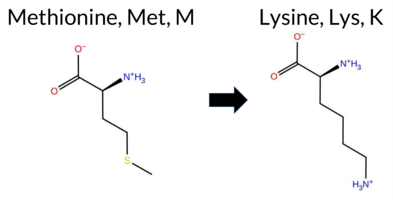 AIThe SynGAP1 missense variant M1211K is listed in ClinVar (ID 834052.0) as benign and is not reported in gnomAD. Functional prediction tools cluster into two groups: benign predictions come from FATHMM and AlphaMissense‑Optimized, while the remaining seven tools—REVEL, PROVEAN, polyPhen‑2 (HumDiv and HumVar), SIFT, ESM1b, and AlphaMissense‑Default—classify the change as pathogenic. High‑accuracy assessments further clarify the picture: AlphaMissense‑Optimized predicts a benign effect, whereas the SGM Consensus (a majority vote of AlphaMissense‑Default, ESM1b, FATHMM, and PROVEAN) indicates a likely pathogenic outcome; Foldetta data are unavailable. Overall, the preponderance of evidence from standard predictors and the SGM Consensus supports a pathogenic interpretation, which contradicts the benign classification reported in ClinVar. Disclaimer: This summary was generated using AI and should be interpreted alongside expert review. | Likely Pathogenic | Coiled-coil | Likely Benign | 1 | -9.013 | Likely Pathogenic | 0.662 | Likely Pathogenic | Likely Benign | 0.595 | Likely Pathogenic | -2.95 | Deleterious | 0.987 | Probably Damaging | 0.979 | Probably Damaging | 5.59 | Benign | 0.01 | Affected | 3.77 | 5 | 0 | -1 | -5.8 | -3.02 | |||||||||||||||||||||||||||||
| c.3633G>A | M1211I 2D 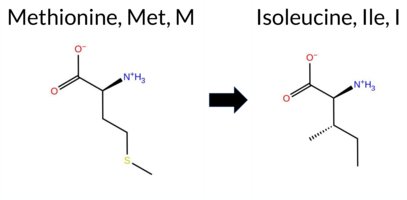 AIThe SynGAP1 missense variant M1211I is listed in ClinVar with an “Uncertain” status and is present in gnomAD (variant ID 6-33446625-G-A). Prediction tools that agree on a benign effect include REVEL, PROVEAN, SIFT, ESM1b, FATHMM, and AlphaMissense‑Optimized. Tools that predict a pathogenic effect are AlphaMissense‑Default, polyPhen‑2 HumDiv, and polyPhen‑2 HumVar. The SGM‑Consensus, derived from a majority vote of AlphaMissense‑Default, ESM1b, FATHMM, and PROVEAN, reports a “Likely Benign” classification. Foldetta, a protein‑folding stability method combining FoldX‑MD and Rosetta outputs, has no available result for this variant. High‑accuracy predictions therefore point to a benign outcome: AlphaMissense‑Optimized is benign, and the SGM‑Consensus also indicates benign. Based on the aggregate predictions, the variant is most likely benign, which does not contradict the ClinVar “Uncertain” status. Disclaimer: This summary was generated using AI and should be interpreted alongside expert review. | Likely Benign | Coiled-coil | Uncertain | 1 | 6-33446625-G-A | 3 | 1.86e-6 | -1.537 | Likely Benign | 0.764 | Likely Pathogenic | Likely Benign | 0.298 | Likely Benign | -0.42 | Neutral | 0.969 | Probably Damaging | 0.968 | Probably Damaging | 5.40 | Benign | 1.00 | Tolerated | 3.77 | 5 | 1 | 2 | 2.6 | -18.03 | ||||||||||||||||||||||||||
| c.3635C>T | S1212F 2D 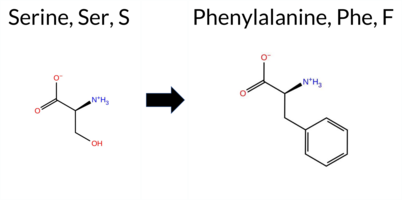 AIThe SynGAP1 missense variant S1212F is listed in ClinVar with an “Uncertain” status and is not reported in gnomAD. Prediction tools that indicate a benign effect include only REVEL, whereas the remaining tools—PROVEAN, polyPhen‑2 (HumDiv and HumVar), SIFT, ESM1b, FATHMM, AlphaMissense‑Default, AlphaMissense‑Optimized, and the SGM‑Consensus (majority vote) score—predict a pathogenic impact. High‑accuracy assessments further support a deleterious outcome: AlphaMissense‑Optimized classifies the variant as pathogenic, and the SGM‑Consensus (derived from AlphaMissense‑Default, ESM1b, FATHMM, and PROVEAN) also reports it as likely pathogenic. No Foldetta stability prediction is available for this variant. Overall, the preponderance of evidence from multiple independent predictors indicates that the variant is most likely pathogenic, which is consistent with its ClinVar “Uncertain” classification rather than contradicting it. Disclaimer: This summary was generated using AI and should be interpreted alongside expert review. | Likely Pathogenic | Coiled-coil | Conflicting | 2 | -14.445 | Likely Pathogenic | 0.997 | Likely Pathogenic | Likely Pathogenic | 0.271 | Likely Benign | -4.52 | Deleterious | 0.999 | Probably Damaging | 0.998 | Probably Damaging | 2.03 | Pathogenic | 0.00 | Affected | 3.77 | 5 | -3 | -2 | 3.6 | 60.10 | |||||||||||||||||||||||||||||
| c.3638A>C | N1213T 2D 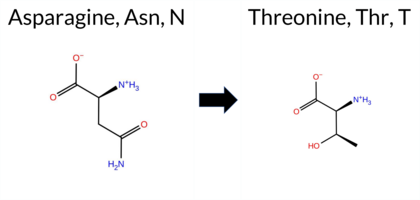 AIThe SynGAP1 missense variant N1213T is listed in ClinVar with an “Uncertain” status and is present in gnomAD (ID 6‑33446630‑A‑C). Prediction tools that agree on a benign effect include REVEL, PROVEAN, SIFT, ESM1b, FATHMM, AlphaMissense‑Default, and AlphaMissense‑Optimized. In contrast, polyPhen‑2 (HumDiv and HumVar) predict a pathogenic outcome. The SGM‑Consensus, derived from a majority vote of AlphaMissense‑Default, ESM1b, FATHMM, and PROVEAN, reports a “Likely Benign” classification. High‑accuracy assessments further support benignity: AlphaMissense‑Optimized is benign, SGM‑Consensus is likely benign, while Foldetta results are unavailable. Overall, the majority of evidence points to a benign effect, and this conclusion does not contradict the ClinVar “Uncertain” designation. Disclaimer: This summary was generated using AI and should be interpreted alongside expert review. | Likely Benign | Coiled-coil | Conflicting | 2 | 6-33446630-A-C | 46 | 2.85e-5 | -5.428 | Likely Benign | 0.266 | Likely Benign | Likely Benign | 0.097 | Likely Benign | -1.08 | Neutral | 0.959 | Probably Damaging | 0.721 | Possibly Damaging | 2.74 | Benign | 1.00 | Tolerated | 3.77 | 5 | 0 | 0 | 2.8 | -13.00 | ||||||||||||||||||||||||||
| c.3638A>G | N1213S 2D 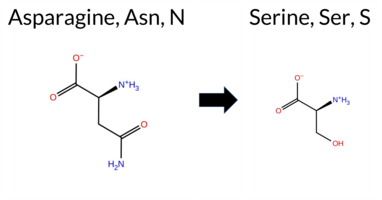 AIThe SynGAP1 missense variant N1213S is listed in ClinVar as Benign (ClinVar ID 708250.0) and is present in the gnomAD database (gnomAD ID 6‑33446630‑A‑G). Functional prediction tools that agree on a benign effect include REVEL, PROVEAN, SIFT, ESM1b, FATHMM, AlphaMissense‑Default, AlphaMissense‑Optimized, and the SGM‑Consensus (majority vote from AlphaMissense‑Default, ESM1b, FATHMM, and PROVEAN). In contrast, PolyPhen‑2 (HumDiv and HumVar) predict a pathogenic outcome. High‑accuracy assessments show AlphaMissense‑Optimized as benign and the SGM‑Consensus also as benign; the Foldetta protein‑folding stability analysis is unavailable. Overall, the majority of evidence points to a benign impact, aligning with the ClinVar classification and indicating no contradiction. Disclaimer: This summary was generated using AI and should be interpreted alongside expert review. | Likely Benign | Coiled-coil | Benign | 1 | 6-33446630-A-G | 13 | 8.05e-6 | -4.086 | Likely Benign | 0.081 | Likely Benign | Likely Benign | 0.094 | Likely Benign | -0.56 | Neutral | 0.906 | Possibly Damaging | 0.551 | Possibly Damaging | 2.82 | Benign | 0.68 | Tolerated | 3.77 | 5 | 1 | 1 | 2.7 | -27.03 | 10.1016/j.ajhg.2020.11.011 | |||||||||||||||||||||||||
| c.3640C>T | R1214W 2D 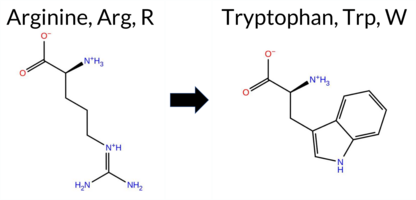 AIThe SynGAP1 missense variant R1214W is listed in ClinVar with an uncertain significance (ClinVar ID 1476244.0) and is present in the gnomAD database (gnomAD ID 6‑33446632‑C‑T). Functional prediction tools cluster into two groups: benign predictions come from REVEL and AlphaMissense‑Optimized, while pathogenic predictions are made by PROVEAN, polyPhen‑2 (HumDiv and HumVar), SIFT, ESM1b, FATHMM, and AlphaMissense‑Default. High‑accuracy assessments further refine the picture: AlphaMissense‑Optimized indicates a benign effect, whereas the SGM Consensus—derived from a majority vote of AlphaMissense‑Default, ESM1b, FATHMM, and PROVEAN—labels the variant as likely pathogenic. No Foldetta stability analysis is available for this residue. Overall, the majority of evidence points toward a pathogenic impact, and this conclusion does not conflict with the ClinVar designation of uncertain significance. Disclaimer: This summary was generated using AI and should be interpreted alongside expert review. | Likely Pathogenic | Coiled-coil | Uncertain | 1 | 6-33446632-C-T | 2 | 1.24e-6 | -8.799 | Likely Pathogenic | 0.710 | Likely Pathogenic | Likely Benign | 0.143 | Likely Benign | -4.95 | Deleterious | 1.000 | Probably Damaging | 0.983 | Probably Damaging | 2.45 | Pathogenic | 0.00 | Affected | 3.77 | 5 | 2 | -3 | 3.6 | 30.03 | ||||||||||||||||||||||||||
| c.3653A>T | E1218V 2D 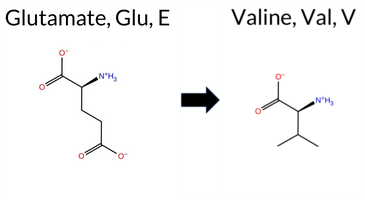 AISynGAP1 missense variant E1218V is listed in ClinVar with an uncertain significance (ClinVar ID 1015602.0) and is not reported in gnomAD. Functional prediction tools show a split opinion: benign predictions come from REVEL and ESM1b, whereas pathogenic predictions are made by PROVEAN, polyPhen‑2 (HumDiv and HumVar), SIFT, FATHMM, and AlphaMissense‑Default. When the high‑accuracy consensus is considered, AlphaMissense‑Optimized is uncertain, but the SGM‑Consensus—derived from a majority vote of AlphaMissense‑Default, ESM1b, FATHMM, and PROVEAN—labels the variant as likely pathogenic. Foldetta, a protein‑folding stability method that integrates FoldX‑MD and Rosetta outputs, has no available result for this change. Overall, the majority of evidence points toward a pathogenic effect, which is consistent with the ClinVar designation of uncertain significance rather than a benign classification. Disclaimer: This summary was generated using AI and should be interpreted alongside expert review. | Likely Pathogenic | Coiled-coil | Uncertain | 2 | -5.647 | Likely Benign | 0.936 | Likely Pathogenic | Ambiguous | 0.418 | Likely Benign | -5.68 | Deleterious | 1.000 | Probably Damaging | 0.998 | Probably Damaging | 2.21 | Pathogenic | 0.00 | Affected | 3.77 | 5 | -2 | -2 | 7.7 | -29.98 | |||||||||||||||||||||||||||||
| c.3655T>C | Y1219H 2D 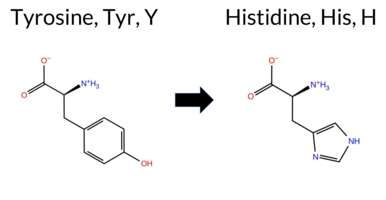 AIThe SynGAP1 missense variant Y1219H is listed in ClinVar with an “Uncertain” status and is not reported in gnomAD. Prediction tools that indicate a benign effect include only REVEL, whereas the remaining tools—PROVEAN, polyPhen‑2 (HumDiv and HumVar), SIFT, ESM1b, FATHMM, AlphaMissense‑Default, AlphaMissense‑Optimized, and the SGM‑Consensus (Likely Pathogenic)—all predict a pathogenic impact. High‑accuracy assessments further support a deleterious outcome: AlphaMissense‑Optimized classifies the variant as pathogenic, and the SGM‑Consensus (majority vote from AlphaMissense‑Default, ESM1b, FATHMM, and PROVEAN) also reports it as Likely Pathogenic. No Foldetta stability prediction is available for this variant. Overall, the preponderance of evidence from both general and high‑accuracy tools indicates that the variant is most likely pathogenic, which does not contradict its current ClinVar “Uncertain” classification. Disclaimer: This summary was generated using AI and should be interpreted alongside expert review. | Likely Pathogenic | Coiled-coil | Uncertain | 1 | -9.511 | Likely Pathogenic | 0.997 | Likely Pathogenic | Likely Pathogenic | 0.363 | Likely Benign | -3.62 | Deleterious | 1.000 | Probably Damaging | 0.999 | Probably Damaging | 2.15 | Pathogenic | 0.00 | Affected | 3.77 | 5 | 0 | 2 | -1.9 | -26.03 | |||||||||||||||||||||||||||||
| c.3661C>T | R1221W 2D  AIThe SynGAP1 missense variant R1221W is listed in ClinVar with an uncertain significance (ClinVar ID 1050818.0) and is present in the gnomAD database (gnomAD ID 6‑33446653‑C‑T). Functional prediction tools show a split assessment: benign predictions come from REVEL and FATHMM, whereas pathogenic predictions are reported by PROVEAN, polyPhen‑2 (HumDiv and HumVar), SIFT, ESM1b, and AlphaMissense‑Default. High‑accuracy analyses further refine the picture: AlphaMissense‑Optimized classifies the variant as benign, whereas the SGM Consensus—derived from a majority vote of AlphaMissense‑Default, ESM1b, FATHMM, and PROVEAN—deems it likely pathogenic. No Foldetta stability assessment is available for this residue. Overall, the majority of computational evidence points toward a pathogenic effect, which is consistent with the ClinVar designation of uncertain significance rather than a definitive benign classification. Disclaimer: This summary was generated using AI and should be interpreted alongside expert review. | Likely Pathogenic | Coiled-coil | Conflicting | 3 | 6-33446653-C-T | 1 | 6.20e-7 | -10.938 | Likely Pathogenic | 0.651 | Likely Pathogenic | Likely Benign | 0.174 | Likely Benign | -4.57 | Deleterious | 1.000 | Probably Damaging | 0.987 | Probably Damaging | 2.50 | Benign | 0.01 | Affected | 3.77 | 5 | 2 | -3 | 3.6 | 30.03 | ||||||||||||||||||||||||||
| c.3662G>A | R1221Q 2D  AIThe SynGAP1 missense variant R1221Q is listed in ClinVar with an “Uncertain” status and is present in the gnomAD database (ID 6‑33446654‑G‑A). Functional prediction tools largely agree on a benign effect: REVEL, PROVEAN, polyPhen‑2 HumVar, SIFT, ESM1b, FATHMM, AlphaMissense‑Default, and AlphaMissense‑Optimized all predict benign. Only polyPhen‑2 HumDiv indicates a pathogenic effect. The SGM Consensus, derived from a majority vote of AlphaMissense‑Default, ESM1b, FATHMM, and PROVEAN, reports the variant as “Likely Benign.” High‑accuracy assessments further support this: AlphaMissense‑Optimized predicts benign, SGM Consensus is likely benign, while Foldetta (a protein‑folding stability method combining FoldX‑MD and Rosetta outputs) has no available result for this variant. Overall, the preponderance of evidence points to a benign impact, which is consistent with the ClinVar “Uncertain” classification and does not contradict it. Disclaimer: This summary was generated using AI and should be interpreted alongside expert review. | Likely Benign | Coiled-coil | Conflicting | 2 | 6-33446654-G-A | 4 | 2.48e-6 | -5.491 | Likely Benign | 0.115 | Likely Benign | Likely Benign | 0.078 | Likely Benign | -1.46 | Neutral | 0.836 | Possibly Damaging | 0.153 | Benign | 2.56 | Benign | 0.12 | Tolerated | 3.77 | 5 | 1 | 1 | 1.0 | -28.06 | ||||||||||||||||||||||||||
| c.3686A>C | Q1229P 2D 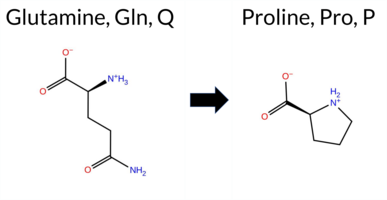 AIThe SynGAP1 missense variant Q1229P is listed in ClinVar with an “Uncertain” status and is not reported in gnomAD. Prediction tools that agree on a benign effect include REVEL and SIFT, whereas the majority of tools predict a pathogenic impact: PROVEAN, polyPhen‑2 (HumDiv and HumVar), ESM1b, FATHMM, AlphaMissense‑Default, AlphaMissense‑Optimized, and the SGM‑Consensus (which is a majority vote of AlphaMissense‑Default, ESM1b, FATHMM, and PROVEAN). High‑accuracy assessments further support pathogenicity: AlphaMissense‑Optimized is pathogenic, and the SGM‑Consensus is “Likely Pathogenic.” No Foldetta stability prediction is available for this variant. Overall, the preponderance of evidence points to a pathogenic effect, and this conclusion does not contradict the ClinVar “Uncertain” classification. Disclaimer: This summary was generated using AI and should be interpreted alongside expert review. | Likely Pathogenic | Coiled-coil | Uncertain | 1 | -10.397 | Likely Pathogenic | 0.980 | Likely Pathogenic | Likely Pathogenic | 0.422 | Likely Benign | -3.69 | Deleterious | 0.998 | Probably Damaging | 0.995 | Probably Damaging | 1.75 | Pathogenic | 0.12 | Tolerated | 3.77 | 5 | 0 | -1 | 1.9 | -31.01 | |||||||||||||||||||||||||||||
| c.36C>G | S12R 2D 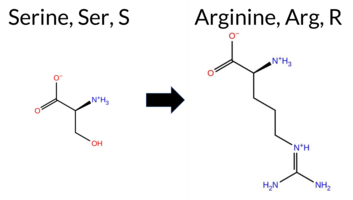 AIThe SynGAP1 missense variant S12R is listed in ClinVar with an “Uncertain” status and is present in gnomAD (ID 6‑33420300‑C‑G). Prediction tools that agree on a benign effect include REVEL, PROVEAN, polyPhen‑2 HumDiv, polyPhen‑2 HumVar, ESM1b, FATHMM, AlphaMissense‑Optimized, and the SGM‑Consensus (majority vote). Only SIFT predicts a pathogenic outcome, while AlphaMissense‑Default remains uncertain. High‑accuracy assessments show AlphaMissense‑Optimized as benign and the SGM‑Consensus (derived from AlphaMissense‑Default, ESM1b, FATHMM, and PROVEAN) also favors a benign classification; Foldetta’s protein‑folding stability analysis is unavailable. Overall, the majority of evidence points to a benign effect, and this does not contradict the ClinVar “Uncertain” designation. Disclaimer: This summary was generated using AI and should be interpreted alongside expert review. | Likely Benign | Uncertain | 1 | 6-33420300-C-G | 4 | 2.59e-6 | -4.033 | Likely Benign | 0.500 | Ambiguous | Likely Benign | 0.097 | Likely Benign | -0.30 | Neutral | 0.000 | Benign | 0.000 | Benign | 4.09 | Benign | 0.00 | Affected | 4.32 | 1 | 0 | -1 | -3.7 | 69.11 | |||||||||||||||||||||||||||
| c.3705G>A | M1235I 2D  AIThe SynGAP1 missense variant M1235I is listed in ClinVar with an “Uncertain” status and is not reported in gnomAD. Prediction tools that classify the variant as benign include REVEL, PROVEAN, polyPhen‑2 (HumDiv and HumVar), ESM1b, FATHMM, AlphaMissense‑Default, AlphaMissense‑Optimized, and the SGM‑Consensus (which aggregates AlphaMissense‑Default, ESM1b, FATHMM, and PROVEAN). Only SIFT predicts a pathogenic effect. High‑accuracy assessments show AlphaMissense‑Optimized as benign and the SGM‑Consensus as “Likely Benign”; Foldetta results are unavailable. Overall, the majority of evidence points to a benign impact, and this conclusion does not contradict the ClinVar “Uncertain” designation. Disclaimer: This summary was generated using AI and should be interpreted alongside expert review. | Likely Benign | Coiled-coil | Uncertain | 1 | -4.312 | Likely Benign | 0.310 | Likely Benign | Likely Benign | 0.027 | Likely Benign | -1.44 | Neutral | 0.139 | Benign | 0.056 | Benign | 2.69 | Benign | 0.04 | Affected | 3.77 | 5 | 1 | 2 | 2.6 | -18.03 | |||||||||||||||||||||||||||||
| c.371C>T | A124V 2D 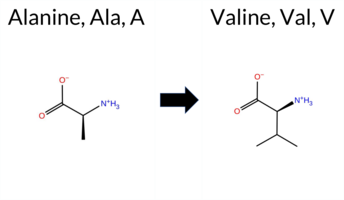 AIThe SynGAP1 A124V missense variant is listed in ClinVar (ID 1040523.0) with an “Uncertain” status and is present in gnomAD (variant ID 6‑33432236‑C‑T). Prediction tools that agree on a benign effect include REVEL, PROVEAN, polyPhen‑2 (HumDiv and HumVar), ESM1b, FATHMM, AlphaMissense‑Default, and AlphaMissense‑Optimized. Only SIFT predicts a pathogenic outcome. The SGM‑Consensus, derived from a majority vote of AlphaMissense‑Default, ESM1b, FATHMM, and PROVEAN, reports a “Likely Benign” classification. High‑accuracy assessments show AlphaMissense‑Optimized as benign and the SGM‑Consensus as likely benign; Foldetta results are not available. Overall, the majority of computational evidence indicates a benign effect, and this consensus does not contradict the ClinVar “Uncertain” designation. Thus, the variant is most likely benign based on current predictions. Disclaimer: This summary was generated using AI and should be interpreted alongside expert review. | Likely Benign | Conflicting | 2 | 6-33432236-C-T | 9 | 5.58e-6 | -4.259 | Likely Benign | 0.138 | Likely Benign | Likely Benign | 0.073 | Likely Benign | -1.52 | Neutral | 0.173 | Benign | 0.009 | Benign | 4.07 | Benign | 0.03 | Affected | 3.61 | 5 | 0 | 0 | 2.4 | 28.05 | |||||||||||||||||||||||||||
| c.3721C>A | L1241M 2D 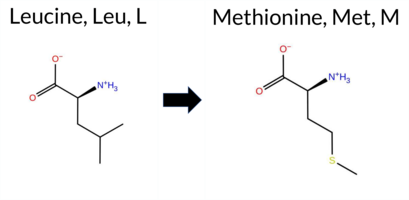 AISynGAP1 missense variant L1241M is listed in ClinVar with an Uncertain significance and is not reported in gnomAD. Functional prediction tools show a split verdict: benign calls come from REVEL, PROVEAN, ESM1b, and AlphaMissense‑Optimized, whereas pathogenic calls are made by polyPhen‑2 (HumDiv and HumVar), SIFT, FATHMM, and AlphaMissense‑Default. The SGM Consensus, which aggregates AlphaMissense‑Default, ESM1b, FATHMM, and PROVEAN, is unresolved (2 benign vs. 2 pathogenic). Foldetta, a protein‑folding stability predictor that combines FoldX‑MD and Rosetta outputs, has no available result for this variant. Consequently, the high‑accuracy tools do not converge on a single interpretation. Overall, the predictions are balanced between benign and pathogenic, leaving the variant’s effect uncertain, which aligns with its ClinVar designation of Uncertain significance. Disclaimer: This summary was generated using AI and should be interpreted alongside expert review. | Coiled-coil | Uncertain | 1 | -5.881 | Likely Benign | 0.782 | Likely Pathogenic | Likely Benign | 0.167 | Likely Benign | -1.43 | Neutral | 1.000 | Probably Damaging | 0.999 | Probably Damaging | 1.65 | Pathogenic | 0.00 | Affected | 4 | 2 | -1.9 | 18.03 | ||||||||||||||||||||||||||||||||
| c.3731G>A | S1244N 2D 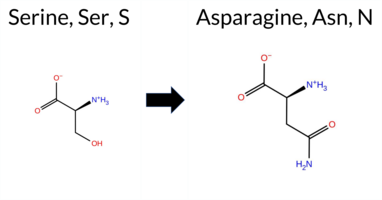 AIThe SynGAP1 missense variant S1244N is listed in ClinVar with an “Uncertain” status (ClinVar ID 931075.0) and is not reported in gnomAD. Prediction tools that agree on a benign effect include REVEL, PROVEAN, SIFT, and AlphaMissense‑Optimized, whereas PolyPhen‑2 (HumDiv and HumVar), ESM1b, FATHMM, and AlphaMissense‑Default all predict a pathogenic outcome. High‑accuracy assessments show AlphaMissense‑Optimized as benign, while the SGM‑Consensus—derived from a majority vote of AlphaMissense‑Default, ESM1b, FATHMM, and PROVEAN—indicates pathogenicity. Foldetta, a protein‑folding stability method combining FoldX‑MD and Rosetta outputs, has no available result for this variant. Overall, the balance of evidence leans toward a pathogenic effect, which does not contradict the ClinVar designation of uncertainty. Disclaimer: This summary was generated using AI and should be interpreted alongside expert review. | Likely Pathogenic | Coiled-coil | Uncertain | 1 | -9.008 | Likely Pathogenic | 0.751 | Likely Pathogenic | Likely Benign | 0.154 | Likely Benign | -1.87 | Neutral | 0.997 | Probably Damaging | 0.992 | Probably Damaging | 2.10 | Pathogenic | 0.15 | Tolerated | 3.77 | 5 | 1 | 1 | -2.7 | 27.03 | |||||||||||||||||||||||||||||
| c.373C>T | P125S 2D 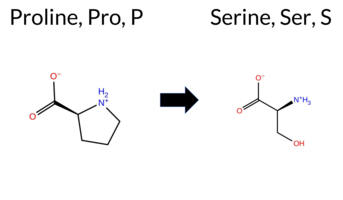 AIThe SynGAP1 missense variant P125S is listed in ClinVar (ID 837156.0) with an “Uncertain” status and is not reported in gnomAD. Functional prediction tools that agree on a benign effect include REVEL, polyPhen‑2 HumVar, ESM1b, FATHMM, AlphaMissense‑Default, and AlphaMissense‑Optimized, while pathogenic predictions come from PROVEAN, polyPhen‑2 HumDiv, and SIFT. The SGM‑Consensus, derived from a majority vote of AlphaMissense‑Default, ESM1b, FATHMM, and PROVEAN, classifies the variant as “Likely Benign.” High‑accuracy assessments show AlphaMissense‑Optimized as benign and the SGM‑Consensus as likely benign; the Foldetta protein‑folding stability analysis is unavailable. Overall, the preponderance of evidence points to a benign impact, and this conclusion does not contradict the ClinVar designation, which remains uncertain. Disclaimer: This summary was generated using AI and should be interpreted alongside expert review. | Likely Benign | Uncertain | 1 | -3.769 | Likely Benign | 0.238 | Likely Benign | Likely Benign | 0.121 | Likely Benign | -3.57 | Deleterious | 0.580 | Possibly Damaging | 0.140 | Benign | 2.86 | Benign | 0.02 | Affected | 3.61 | 5 | 1 | -1 | 0.8 | -10.04 | ||||||||||||||||||||||||||||||
| c.3773A>G | Q1258R 2D 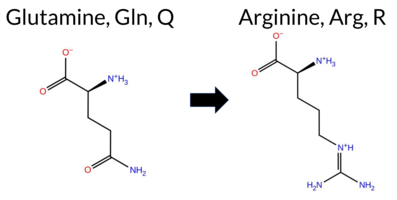 AIThe SynGAP1 missense variant Q1258R is listed in ClinVar with an uncertain significance (ClinVar ID 3359527.0) and is not observed in gnomAD. Functional prediction tools largely agree on a deleterious effect: pathogenic predictions come from PROVEAN, polyPhen‑2 (HumDiv and HumVar), SIFT, ESM1b, FATHMM, and AlphaMissense‑Default, while only REVEL predicts a benign outcome. The high‑accuracy predictors give the following results: AlphaMissense‑Optimized is uncertain; the SGM Consensus, derived from a majority vote of AlphaMissense‑Default, ESM1b, FATHMM, and PROVEAN, reports a likely pathogenic classification; Foldetta, which integrates FoldX‑MD and Rosetta stability calculations, has no available output for this variant. Based on the preponderance of pathogenic predictions and the SGM Consensus, the variant is most likely pathogenic, which is consistent with its ClinVar uncertain status rather than contradicting it. Disclaimer: This summary was generated using AI and should be interpreted alongside expert review. | Likely Pathogenic | Coiled-coil | Uncertain | 1 | -10.971 | Likely Pathogenic | 0.931 | Likely Pathogenic | Ambiguous | 0.316 | Likely Benign | -3.19 | Deleterious | 0.994 | Probably Damaging | 0.988 | Probably Damaging | 2.00 | Pathogenic | 0.00 | Affected | 1 | 1 | -1.0 | 28.06 | |||||||||||||||||||||||||||||||
| c.3788T>C | I1263T 2D  AIThe SynGAP1 missense variant I1263T is listed in ClinVar with an “Uncertain” status and is present in the gnomAD database (ID 6‑33446780‑T‑C). Functional prediction tools largely agree on a deleterious effect: REVEL, PROVEAN, polyPhen‑2 (HumDiv and HumVar), SIFT, FATHMM, AlphaMissense‑Default, and AlphaMissense‑Optimized all report pathogenicity, while only ESM1b predicts a benign outcome. High‑accuracy assessments reinforce this view: AlphaMissense‑Optimized predicts pathogenic, and the SGM‑Consensus (majority vote of AlphaMissense‑Default, ESM1b, FATHMM, and PROVEAN) indicates a likely pathogenic classification. Foldetta, a protein‑folding stability method combining FoldX‑MD and Rosetta outputs, has no available result for this variant. Overall, the consensus of the majority of prediction tools and the high‑accuracy methods points to a pathogenic effect, which aligns with the ClinVar designation of uncertainty but does not contradict it. Disclaimer: This summary was generated using AI and should be interpreted alongside expert review. | Likely Pathogenic | Coiled-coil | Uncertain | 1 | 6-33446780-T-C | 2 | 1.24e-6 | -6.564 | Likely Benign | 0.962 | Likely Pathogenic | Likely Pathogenic | 0.529 | Likely Pathogenic | -4.15 | Deleterious | 0.946 | Possibly Damaging | 0.673 | Possibly Damaging | 1.81 | Pathogenic | 0.00 | Affected | 3.77 | 5 | 0 | -1 | -5.2 | -12.05 | ||||||||||||||||||||||||||
| c.3794G>C | R1265T 2D 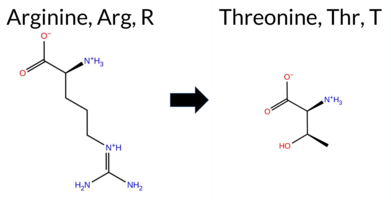 AIThe SynGAP1 missense variant R1265T is reported in ClinVar as Pathogenic (ClinVar ID 522047.0) and is not found in gnomAD. Functional prediction tools uniformly indicate a deleterious effect: REVEL, PROVEAN, PolyPhen‑2 (HumDiv and HumVar), SIFT, ESM1b, FATHMM, AlphaMissense‑Default, and AlphaMissense‑Optimized all classify the variant as pathogenic. No tool in the dataset predicts a benign outcome. High‑accuracy assessments corroborate this: AlphaMissense‑Optimized predicts pathogenicity, and the SGM Consensus (majority vote from AlphaMissense‑Default, ESM1b, FATHMM, and PROVEAN) yields a Likely Pathogenic verdict. Foldetta, a protein‑folding stability method combining FoldX‑MD and Rosetta outputs, has no available result for this variant. Overall, the consensus of all available predictions supports a pathogenic classification, which is consistent with the ClinVar status. Disclaimer: This summary was generated using AI and should be interpreted alongside expert review. | Likely Pathogenic | Coiled-coil | Likely Pathogenic | 1 | -10.129 | Likely Pathogenic | 0.997 | Likely Pathogenic | Likely Pathogenic | 0.529 | Likely Pathogenic | -4.97 | Deleterious | 0.997 | Probably Damaging | 0.994 | Probably Damaging | 2.29 | Pathogenic | 0.00 | Affected | 3.77 | 5 | -1 | -1 | 3.8 | -55.08 | |||||||||||||||||||||||||||||
| c.379C>T | R127W 2D  AISynGAP1 missense variant R127W is listed in ClinVar with an Uncertain significance status and is not reported in gnomAD. Functional prediction tools show a split: benign calls come from REVEL, polyPhen‑2 HumVar, ESM1b, and FATHMM, while pathogenic calls come from PROVEAN, polyPhen‑2 HumDiv, SIFT, and AlphaMissense‑Default. The high‑accuracy AlphaMissense‑Optimized score is Uncertain, the SGM Consensus (majority vote of AlphaMissense‑Default, ESM1b, FATHMM, PROVEAN) is inconclusive, and Foldetta stability analysis is unavailable. Consequently, the evidence does not favor a clear benign or pathogenic outcome; the predictions are balanced and align with the ClinVar designation of Uncertain significance. Disclaimer: This summary was generated using AI and should be interpreted alongside expert review. | Uncertain | 1 | -4.776 | Likely Benign | 0.806 | Likely Pathogenic | Ambiguous | 0.118 | Likely Benign | -2.98 | Deleterious | 0.989 | Probably Damaging | 0.420 | Benign | 3.88 | Benign | 0.00 | Affected | 2 | -3 | 3.6 | 30.03 | |||||||||||||||||||||||||||||||||
| c.37A>G | I13V 2D 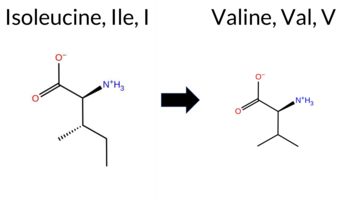 AIThe SynGAP1 I13V missense variant is listed in ClinVar (ID 3364831.0) with an “Uncertain” status and is not reported in gnomAD. Prediction tools that agree on a benign effect include REVEL, PROVEAN, polyPhen‑2 (HumDiv and HumVar), ESM1b, FATHMM, AlphaMissense‑Default, and AlphaMissense‑Optimized. Only SIFT predicts a pathogenic outcome. The SGM‑Consensus, derived from a majority vote of AlphaMissense‑Default, ESM1b, FATHMM, and PROVEAN, also indicates a likely benign effect. High‑accuracy assessments show AlphaMissense‑Optimized as benign and the SGM‑Consensus as benign; Foldetta results are unavailable. Overall, the preponderance of evidence points to a benign impact for I13V, and this conclusion does not conflict with the ClinVar “Uncertain” classification. Disclaimer: This summary was generated using AI and should be interpreted alongside expert review. | Likely Benign | Uncertain | 1 | -2.497 | Likely Benign | 0.105 | Likely Benign | Likely Benign | 0.110 | Likely Benign | 0.01 | Neutral | 0.000 | Benign | 0.000 | Benign | 4.25 | Benign | 0.00 | Affected | 4 | 3 | -0.3 | -14.03 | ||||||||||||||||||||||||||||||||
| c.3806T>A | V1269E 2D 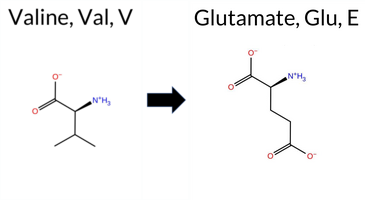 AIThe SynGAP1 missense change V1269E is listed in ClinVar with an “Uncertain” status and is not reported in gnomAD. Prediction tools that flag the variant as benign include only REVEL, whereas the remaining predictors—PROVEAN, polyPhen‑2 (HumDiv and HumVar), SIFT, ESM1b, FATHMM, AlphaMissense‑Default, and AlphaMissense‑Optimized—consistently classify it as pathogenic. The SGM‑Consensus, derived from a majority vote of AlphaMissense‑Default, ESM1b, FATHMM, and PROVEAN, also reports a “Likely Pathogenic” outcome. High‑accuracy assessments show AlphaMissense‑Optimized as pathogenic and the SGM‑Consensus as likely pathogenic; the Foldetta stability analysis is unavailable. Overall, the preponderance of evidence points to a pathogenic effect, which does not contradict the ClinVar designation of uncertainty. Disclaimer: This summary was generated using AI and should be interpreted alongside expert review. | Likely Pathogenic | Coiled-coil | Uncertain | 1 | -11.418 | Likely Pathogenic | 0.989 | Likely Pathogenic | Likely Pathogenic | 0.403 | Likely Benign | -5.05 | Deleterious | 0.999 | Probably Damaging | 0.995 | Probably Damaging | 2.09 | Pathogenic | 0.00 | Affected | 3.77 | 5 | -2 | -2 | -7.7 | 29.98 | |||||||||||||||||||||||||||||
| c.380G>A | R127Q 2D  AIThe SynGAP1 missense variant R127Q (ClinVar ID 2898917.0) is listed as ClinVar status Uncertain and is present in gnomAD (6‑33432245‑G‑A). Prediction tools that agree on a benign effect include REVEL, PROVEAN, polyPhen‑2 HumDiv, polyPhen‑2 HumVar, ESM1b, FATHMM, AlphaMissense‑Default, and AlphaMissense‑Optimized. Only SIFT predicts a pathogenic outcome. The SGM‑Consensus, derived from a majority vote of AlphaMissense‑Default, ESM1b, FATHMM, and PROVEAN, reports a Likely Benign classification. High‑accuracy assessments show AlphaMissense‑Optimized as benign and the SGM‑Consensus as Likely Benign; Foldetta stability analysis is unavailable. Overall, the majority of computational evidence supports a benign effect, which is consistent with the ClinVar Uncertain status and does not contradict it. Disclaimer: This summary was generated using AI and should be interpreted alongside expert review. | Likely Benign | Uncertain | 1 | 6-33432245-G-A | 6 | 3.72e-6 | -1.711 | Likely Benign | 0.320 | Likely Benign | Likely Benign | 0.037 | Likely Benign | -1.04 | Neutral | 0.006 | Benign | 0.001 | Benign | 4.04 | Benign | 0.02 | Affected | 3.74 | 4 | 1 | 1 | 1.0 | -28.06 | |||||||||||||||||||||||||||
| c.3820C>T | R1274C 2D 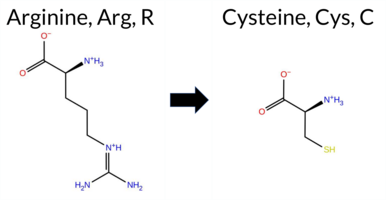 AIThe SynGAP1 missense variant R1274C is listed in ClinVar with an “Uncertain” significance and is present in gnomAD (ID 6‑33447868‑C‑T). Prediction tools that agree on benign impact include REVEL, ESM1b, and AlphaMissense‑Optimized, while those that predict pathogenicity are PROVEAN, polyPhen‑2 (HumDiv and HumVar), SIFT, FATHMM, and the SGM Consensus (majority vote from AlphaMissense‑Default, ESM1b, FATHMM, and PROVEAN). AlphaMissense‑Default remains uncertain, and Foldetta results are unavailable. High‑accuracy assessments show AlphaMissense‑Optimized as benign, the SGM Consensus as pathogenic, and no Foldetta data to weigh in. Overall, the majority of evaluated tools (seven pathogenic vs. three benign) suggest a pathogenic effect. This consensus does not contradict the ClinVar “Uncertain” status, which remains inconclusive. Disclaimer: This summary was generated using AI and should be interpreted alongside expert review. | Uncertain | 1 | 6-33447868-C-T | -6.467 | Likely Benign | 0.439 | Ambiguous | Likely Benign | 0.170 | Likely Benign | -5.22 | Deleterious | 1.000 | Probably Damaging | 0.996 | Probably Damaging | 2.46 | Pathogenic | 0.00 | Affected | 3.77 | 5 | -4 | -3 | 7.0 | -53.05 | ||||||||||||||||||||||||||||||
| c.3821G>A | R1274H 2D 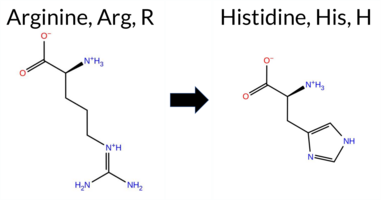 AIThe SynGAP1 missense variant R1274H (ClinVar ID 2803246.0) is classified as Benign in ClinVar and is present in gnomAD (ID 6‑33447869‑G‑A). Functional prediction tools show mixed results: benign calls come from REVEL, ESM1b, AlphaMissense‑Default, and AlphaMissense‑Optimized, while pathogenic calls are made by PROVEAN, polyPhen‑2 (HumDiv and HumVar), SIFT, and FATHMM. High‑accuracy assessments indicate that AlphaMissense‑Optimized predicts a benign effect, whereas the SGM Consensus—derived from a majority vote of AlphaMissense‑Default, ESM1b, FATHMM, and PROVEAN—yields a tie and is therefore inconclusive. No Foldetta stability prediction is available for this residue. Overall, the majority of conventional tools predict pathogenicity, and the high‑accuracy AlphaMissense‑Optimized result is benign, leaving the evidence mixed. Based on the preponderance of pathogenic predictions, the variant is most likely pathogenic, contradicting its ClinVar benign classification. Disclaimer: This summary was generated using AI and should be interpreted alongside expert review. | Likely Benign | 1 | 6-33447869-G-A | 4 | 2.58e-6 | -5.259 | Likely Benign | 0.256 | Likely Benign | Likely Benign | 0.149 | Likely Benign | -3.20 | Deleterious | 1.000 | Probably Damaging | 0.995 | Probably Damaging | 2.49 | Pathogenic | 0.01 | Affected | 3.77 | 5 | 0 | 2 | 1.3 | -19.05 | ||||||||||||||||||||||||||||
| c.3824G>A | R1275Q 2D  AIThe SynGAP1 missense variant R1275Q is listed in ClinVar with an uncertain significance (ClinVar ID 1720188.0) and is present in gnomAD (6‑33447872‑G‑A). Consensus from multiple in‑silico predictors shows a split: benign calls from REVEL, PROVEAN, polyPhen‑2 HumVar, ESM1b, FATHMM, AlphaMissense‑Default, and AlphaMissense‑Optimized, whereas pathogenic calls come from polyPhen‑2 HumDiv and SIFT. High‑accuracy tools reinforce the benign trend: AlphaMissense‑Optimized predicts benign, and the SGM Consensus (majority vote of AlphaMissense‑Default, ESM1b, FATHMM, and PROVEAN) reports likely benign. Foldetta results are unavailable. Overall, the majority of evidence points to a benign effect, and this assessment does not conflict with the ClinVar uncertain status. Disclaimer: This summary was generated using AI and should be interpreted alongside expert review. | Likely Benign | Uncertain | 1 | 6-33447872-G-A | 2 | 1.29e-6 | -4.928 | Likely Benign | 0.121 | Likely Benign | Likely Benign | 0.103 | Likely Benign | -1.72 | Neutral | 0.898 | Possibly Damaging | 0.147 | Benign | 2.59 | Benign | 0.03 | Affected | 3.77 | 5 | 1 | 1 | 1.0 | -28.06 | |||||||||||||||||||||||||||
| c.3824G>T | R1275L 2D 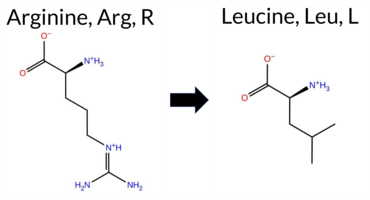 AIThe SynGAP1 missense variant R1275L is listed in ClinVar as benign and is present in gnomAD (ID 6‑33447872‑G‑T). Functional prediction tools show a split: benign calls come from REVEL, ESM1b, FATHMM, AlphaMissense‑Optimized, and polyPhen2_HumVar, while pathogenic calls come from PROVEAN, polyPhen2_HumDiv, and SIFT. Grouping by agreement, the benign‑predicted tools outnumber the pathogenic ones (5 vs 3). High‑accuracy assessments further support a benign interpretation: AlphaMissense‑Optimized predicts benign, the SGM Consensus (majority vote of AlphaMissense‑Default, ESM1b, FATHMM, PROVEAN) resolves to benign, and Foldetta results are unavailable. Overall, the computational evidence leans toward a benign effect, consistent with the ClinVar classification and showing no contradiction. Disclaimer: This summary was generated using AI and should be interpreted alongside expert review. | Likely Benign | 1 | 6-33447872-G-T | 1 | 6.45e-7 | -6.052 | Likely Benign | 0.446 | Ambiguous | Likely Benign | 0.117 | Likely Benign | -4.04 | Deleterious | 0.800 | Possibly Damaging | 0.277 | Benign | 2.55 | Benign | 0.01 | Affected | 3.77 | 5 | -3 | -2 | 8.3 | -43.03 | ||||||||||||||||||||||||||||
| c.382C>A | P128T 2D 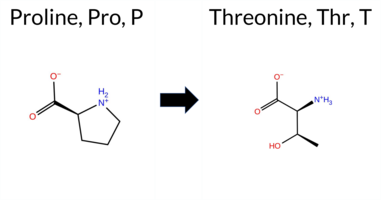 AIThe SynGAP1 missense variant P128T is listed in ClinVar with an “Uncertain” status (ClinVar ID 2801315.0) and is present in gnomAD (ID 6‑33432247‑C‑A). Prediction tools that agree on a benign effect include REVEL, PROVEAN, SIFT, ESM1b, FATHMM, AlphaMissense‑Default, AlphaMissense‑Optimized, and the SGM‑Consensus (majority vote from AlphaMissense‑Default, ESM1b, FATHMM, PROVEAN). Tools that predict a pathogenic effect are polyPhen‑2 HumDiv and polyPhen‑2 HumVar. High‑accuracy assessments show AlphaMissense‑Optimized as benign and the SGM‑Consensus (majority vote) as likely benign; Foldetta results are unavailable. Overall, the majority of evidence points to a benign impact, and this conclusion does not contradict the ClinVar “Uncertain” classification. Disclaimer: This summary was generated using AI and should be interpreted alongside expert review. | Likely Benign | Uncertain | 1 | 6-33432247-C-A | 1 | 6.20e-7 | -4.217 | Likely Benign | 0.267 | Likely Benign | Likely Benign | 0.075 | Likely Benign | -0.96 | Neutral | 0.952 | Possibly Damaging | 0.500 | Possibly Damaging | 4.19 | Benign | 0.35 | Tolerated | 3.74 | 4 | -1 | 0 | 0.9 | 3.99 | |||||||||||||||||||||||||||
| c.3835G>A | A1279T 2D 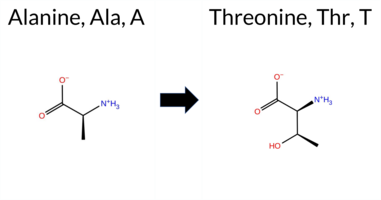 AIThe SynGAP1 missense variant A1279T is listed in ClinVar with an “Uncertain” status and is present in gnomAD (variant ID 6‑33447883‑G‑A). All available in silico predictors report a benign effect: REVEL, PROVEAN, PolyPhen‑2 (HumDiv and HumVar), SIFT, ESM1b, FATHMM, AlphaMissense‑Default, and AlphaMissense‑Optimized are benign, and the SGM‑Consensus (majority vote of AlphaMissense‑Default, ESM1b, FATHMM, and PROVEAN) is “Likely Benign.” No tool predicts pathogenicity. High‑accuracy assessments confirm this: AlphaMissense‑Optimized is benign, and the SGM‑Consensus is benign; Foldetta results are not available. Overall, the computational evidence strongly supports a benign classification, which does not contradict the ClinVar “Uncertain” designation. Disclaimer: This summary was generated using AI and should be interpreted alongside expert review. | Likely Benign | Uncertain | 2 | 6-33447883-G-A | 2 | 1.29e-6 | -4.871 | Likely Benign | 0.071 | Likely Benign | Likely Benign | 0.178 | Likely Benign | -0.30 | Neutral | 0.001 | Benign | 0.000 | Benign | 2.71 | Benign | 0.09 | Tolerated | 3.77 | 5 | 1 | 0 | -2.5 | 30.03 | |||||||||||||||||||||||||||
| c.3846G>C | E1282D 2D  AIThe SynGAP1 missense variant E1282D is listed in ClinVar with an “Uncertain” status and is present in gnomAD (variant ID 6-33447894-G-C). All available in silico predictors classify the substitution as benign: REVEL, PROVEAN, PolyPhen‑2 (HumDiv and HumVar), SIFT, ESM1b, FATHMM, AlphaMissense‑Default, and AlphaMissense‑Optimized. No tool reports a pathogenic prediction. The SGM‑Consensus, which aggregates the majority vote of AlphaMissense‑Default, ESM1b, FATHMM, and PROVEAN, also indicates a likely benign outcome. High‑accuracy assessments confirm this: AlphaMissense‑Optimized predicts benign, and the SGM‑Consensus (majority vote) is likely benign. Foldetta, a protein‑folding stability method combining FoldX‑MD and Rosetta outputs, has no reported result for this variant, so its status is unavailable. Overall, the computational evidence overwhelmingly supports a benign effect, which is consistent with the ClinVar “Uncertain” classification rather than contradicting it. Disclaimer: This summary was generated using AI and should be interpreted alongside expert review. | Likely Benign | Uncertain | 1 | 6-33447894-G-C | 1 | 6.44e-7 | -3.879 | Likely Benign | 0.074 | Likely Benign | Likely Benign | 0.104 | Likely Benign | -1.26 | Neutral | 0.112 | Benign | 0.036 | Benign | 2.70 | Benign | 0.39 | Tolerated | 3.77 | 5 | 3 | 2 | 0.0 | -14.03 | |||||||||||||||||||||||||||
| c.3848C>T | P1283L 2D 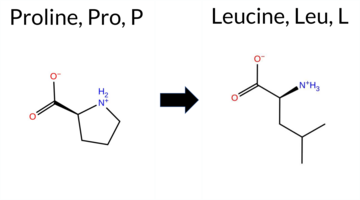 AIThe SynGAP1 missense variant P1283L is listed in ClinVar (ID 536994.0) as Benign and is present in gnomAD (gnomAD ID 6‑33447896‑C‑T). All evaluated in‑silico predictors classify the substitution as benign: REVEL, PROVEAN, polyPhen‑2 (HumDiv and HumVar), SIFT, ESM1b, FATHMM, AlphaMissense‑Default, and AlphaMissense‑Optimized. No tool reports a pathogenic prediction. High‑accuracy assessments corroborate this: AlphaMissense‑Optimized predicts Benign, and the SGM Consensus (majority vote of AlphaMissense‑Default, ESM1b, FATHMM, and PROVEAN) indicates Likely Benign. Foldetta, a protein‑folding stability method combining FoldX‑MD and Rosetta outputs, did not provide a result for this variant. Overall, the computational evidence overwhelmingly supports a benign effect, aligning with the ClinVar benign classification. Disclaimer: This summary was generated using AI and should be interpreted alongside expert review. | Likely Benign | Benign | 1 | 6-33447896-C-T | 32 | 2.06e-5 | -3.740 | Likely Benign | 0.093 | Likely Benign | Likely Benign | 0.047 | Likely Benign | -1.04 | Neutral | 0.005 | Benign | 0.003 | Benign | 2.76 | Benign | 0.06 | Tolerated | 3.77 | 5 | -3 | -3 | 5.4 | 16.04 | |||||||||||||||||||||||||||
| c.3858A>T | E1286D 2D  AIThe SynGAP1 missense variant E1286D is listed in ClinVar (ID 469159.0) with an “Uncertain” clinical significance and is present in gnomAD (variant ID 6‑33447906‑A‑T). All evaluated in‑silico predictors classify the substitution as benign: REVEL, PROVEAN, PolyPhen‑2 (HumDiv and HumVar), SIFT, ESM1b, FATHMM, AlphaMissense‑Default, and AlphaMissense‑Optimized all return benign scores. No tool in the set predicts pathogenicity. High‑accuracy assessments reinforce this view: AlphaMissense‑Optimized is benign, and the SGM Consensus (majority vote of AlphaMissense‑Default, ESM1b, FATHMM, and PROVEAN) is “Likely Benign.” Foldetta, a protein‑folding stability method combining FoldX‑MD and Rosetta outputs, did not provide a result for this variant, so its status is unavailable. Overall, the computational evidence strongly supports a benign effect, and this conclusion does not contradict the current ClinVar “Uncertain” designation. Disclaimer: This summary was generated using AI and should be interpreted alongside expert review. | Likely Benign | Conflicting | 4 | 6-33447906-A-T | 143 | 9.22e-5 | -4.010 | Likely Benign | 0.081 | Likely Benign | Likely Benign | 0.036 | Likely Benign | 1.02 | Neutral | 0.001 | Benign | 0.004 | Benign | 2.96 | Benign | 1.00 | Tolerated | 3.77 | 5 | 3 | 2 | 0.0 | -14.03 | 10.1016/j.ajhg.2020.11.011 | ||||||||||||||||||||||||||
| c.3859C>A | P1287T 2D  AIThe SynGAP1 missense variant P1287T is listed in ClinVar with an “Uncertain” status and is present in gnomAD (ID 6‑33447907‑C‑A). Prediction tools that agree on a benign effect include REVEL, PROVEAN, polyPhen‑2 (HumDiv and HumVar), ESM1b, FATHMM, AlphaMissense‑Default, AlphaMissense‑Optimized, and the SGM‑Consensus (majority vote from AlphaMissense‑Default, ESM1b, FATHMM, and PROVEAN). Only SIFT predicts a pathogenic outcome. High‑accuracy assessments show AlphaMissense‑Optimized as benign and the SGM‑Consensus as likely benign; Foldetta results are unavailable. Overall, the majority of evidence points to a benign impact, and this conclusion does not contradict the ClinVar “Uncertain” classification. Disclaimer: This summary was generated using AI and should be interpreted alongside expert review. | Likely Benign | Uncertain | 1 | 6-33447907-C-A | -3.940 | Likely Benign | 0.077 | Likely Benign | Likely Benign | 0.044 | Likely Benign | -0.22 | Neutral | 0.126 | Benign | 0.041 | Benign | 2.78 | Benign | 0.04 | Affected | 3.77 | 5 | -1 | 0 | 0.9 | 3.99 | |||||||||||||||||||||||||||||
| c.3860C>T | P1287L 2D  AIThe SynGAP1 missense variant P1287L is listed in ClinVar with an “Uncertain” status and is present in gnomAD (ID 6‑33447908‑C‑T). Prediction tools that agree on a benign effect include REVEL, PROVEAN, polyPhen‑2 (HumDiv and HumVar), ESM1b, FATHMM, AlphaMissense‑Default, and AlphaMissense‑Optimized. Only SIFT predicts a pathogenic outcome. The SGM‑Consensus, derived from a majority vote of AlphaMissense‑Default, ESM1b, FATHMM, and PROVEAN, also indicates a likely benign effect. High‑accuracy assessments show AlphaMissense‑Optimized as benign and the SGM‑Consensus as benign; Foldetta results are not available. Overall, the majority of evidence points to a benign impact, and this conclusion does not contradict the ClinVar “Uncertain” classification. Disclaimer: This summary was generated using AI and should be interpreted alongside expert review. | Likely Benign | Conflicting | 2 | 6-33447908-C-T | -2.800 | Likely Benign | 0.117 | Likely Benign | Likely Benign | 0.061 | Likely Benign | -1.66 | Neutral | 0.021 | Benign | 0.017 | Benign | 2.76 | Benign | 0.02 | Affected | 3.77 | 5 | -3 | -3 | 5.4 | 16.04 | |||||||||||||||||||||||||||||
| c.3862A>G | K1288E 2D 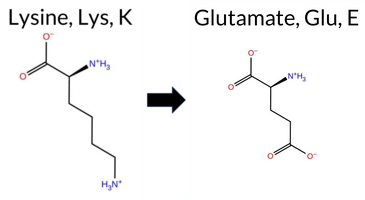 AISynGAP1 missense variant K1288E is listed in ClinVar with an uncertain significance and is present in gnomAD (ID 6‑33447910‑A‑G). Functional prediction tools cluster into two groups: benign predictions come from REVEL, ESM1b, and AlphaMissense‑Optimized, while pathogenic predictions are made by PROVEAN, polyPhen‑2 (HumDiv and HumVar), SIFT, and FATHMM. AlphaMissense‑Default remains uncertain. High‑accuracy assessments show AlphaMissense‑Optimized as benign, whereas the SGM Consensus—derived from a majority vote of AlphaMissense‑Default, ESM1b, FATHMM, and PROVEAN—labels the variant pathogenic. Foldetta, a protein‑folding stability method combining FoldX‑MD and Rosetta outputs, has no available result for this change. Overall, the preponderance of evidence points to a pathogenic effect, which is consistent with the ClinVar designation of uncertain significance rather than a clear benign classification. Thus, the variant is most likely pathogenic, and this does not contradict the ClinVar uncertain status. Disclaimer: This summary was generated using AI and should be interpreted alongside expert review. | Uncertain | 1 | 6-33447910-A-G | 5 | 3.22e-6 | -2.751 | Likely Benign | 0.407 | Ambiguous | Likely Benign | 0.185 | Likely Benign | -3.27 | Deleterious | 0.979 | Probably Damaging | 0.973 | Probably Damaging | 2.13 | Pathogenic | 0.00 | Affected | 3.77 | 5 | 1 | 0 | 0.4 | 0.94 | ||||||||||||||||||||||||||||
| c.3902C>A | P1301H 2D 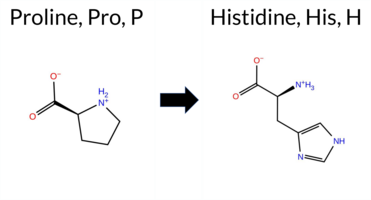 AIThe SynGAP1 missense variant P1301H is listed in ClinVar (ID 212356.0) with an “Uncertain” clinical significance and is present in gnomAD (variant ID 6‑33451776‑C‑A). Functional prediction tools that agree on a benign effect include REVEL, PROVEAN, polyPhen‑2 HumVar, ESM1b, FATHMM, AlphaMissense‑Default, and AlphaMissense‑Optimized. Tools that predict a pathogenic effect are polyPhen‑2 HumDiv and SIFT. The high‑accuracy consensus methods report a benign outcome: AlphaMissense‑Optimized predicts benign, and the SGM Consensus (majority vote of AlphaMissense‑Default, ESM1b, FATHMM, and PROVEAN) indicates “Likely Benign.” No Foldetta stability result is available. Overall, the majority of predictions, including the high‑accuracy consensus, support a benign classification, which does not contradict the ClinVar status of uncertainty. Disclaimer: This summary was generated using AI and should be interpreted alongside expert review. | Likely Benign | Conflicting | 2 | 6-33451776-C-A | 5 | 3.10e-6 | -5.756 | Likely Benign | 0.104 | Likely Benign | Likely Benign | 0.232 | Likely Benign | -1.13 | Neutral | 0.642 | Possibly Damaging | 0.378 | Benign | 2.79 | Benign | 0.04 | Affected | 3.77 | 5 | 0 | -2 | -1.6 | 40.02 | |||||||||||||||||||||||||||
| c.3902C>G | P1301R 2D 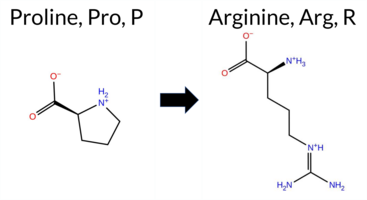 AIThe SynGAP1 missense variant P1301R is listed in ClinVar with an uncertain significance (ClinVar ID 2092739.0) and is present in gnomAD (ID 6‑33451776‑C‑G). Functional prediction tools uniformly classify the variant as benign: REVEL, PROVEAN, polyPhen‑2 (HumDiv and HumVar), SIFT, ESM1b, FATHMM, AlphaMissense‑Default, and AlphaMissense‑Optimized all report benign effects. No tool predicts pathogenicity. High‑accuracy assessments corroborate this: AlphaMissense‑Optimized is benign, and the SGM Consensus (majority vote from AlphaMissense‑Default, ESM1b, FATHMM, and PROVEAN) is “Likely Benign.” Foldetta results are unavailable. In summary, all available predictions agree on a benign impact, and this consensus does not contradict the ClinVar uncertain status. Thus, the variant is most likely benign. Disclaimer: This summary was generated using AI and should be interpreted alongside expert review. | Likely Benign | Uncertain | 1 | 6-33451776-C-G | 15 | 9.30e-6 | -4.753 | Likely Benign | 0.162 | Likely Benign | Likely Benign | 0.076 | Likely Benign | -1.13 | Neutral | 0.077 | Benign | 0.059 | Benign | 2.81 | Benign | 0.10 | Tolerated | 3.77 | 5 | 0 | -2 | -2.9 | 59.07 | |||||||||||||||||||||||||||
| c.3906G>C | L1302F 2D 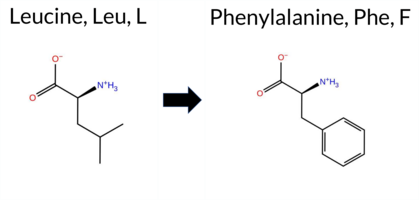 AISynGAP1 missense variant L1302F is listed in ClinVar with an uncertain significance and is not reported in gnomAD. Functional prediction tools show a split: benign calls come from REVEL, ESM1b, AlphaMissense‑Default, and AlphaMissense‑Optimized, while pathogenic calls are made by PROVEAN, polyPhen‑2 (HumDiv and HumVar), SIFT, and FATHMM. High‑accuracy assessments indicate AlphaMissense‑Optimized predicts benign, whereas the SGM consensus (derived from AlphaMissense‑Default, ESM1b, FATHMM, and PROVEAN) is inconclusive due to a 2‑to‑2 split; Foldetta stability analysis is unavailable. Overall, the majority of predictions (five pathogenic versus four benign) lean toward a pathogenic effect. Thus, the variant is most likely pathogenic, a conclusion that contrasts with its current ClinVar status of uncertain significance. Disclaimer: This summary was generated using AI and should be interpreted alongside expert review. | Uncertain | 1 | -5.674 | Likely Benign | 0.148 | Likely Benign | Likely Benign | 0.211 | Likely Benign | -2.70 | Deleterious | 0.960 | Probably Damaging | 0.657 | Possibly Damaging | 1.53 | Pathogenic | 0.00 | Affected | 2 | 0 | -1.0 | 34.02 | |||||||||||||||||||||||||||||||||
| c.3907G>A | G1303S 2D  AIThe SynGAP1 missense variant G1303S is listed in ClinVar (ID 1736068.0) with an “Uncertain” clinical significance and is not reported in gnomAD. Prediction tools that agree on a benign effect include REVEL, PROVEAN, polyPhen‑2 HumVar, SIFT, ESM1b, FATHMM, AlphaMissense‑Default, AlphaMissense‑Optimized, and the SGM‑Consensus (Likely Benign). Only polyPhen‑2 HumDiv predicts a pathogenic outcome. High‑accuracy assessments show AlphaMissense‑Optimized as benign and the SGM‑Consensus as Likely Benign; a Foldetta stability analysis is unavailable. Overall, the majority of evidence points to a benign impact, and this is consistent with the ClinVar “Uncertain” status rather than contradicting it. Disclaimer: This summary was generated using AI and should be interpreted alongside expert review. | Likely Benign | Uncertain | 1 | -2.271 | Likely Benign | 0.125 | Likely Benign | Likely Benign | 0.155 | Likely Benign | -0.19 | Neutral | 0.649 | Possibly Damaging | 0.433 | Benign | 2.84 | Benign | 0.18 | Tolerated | 1 | 0 | -0.4 | 30.03 | ||||||||||||||||||||||||||||||||
| c.3913A>G | T1305A 2D 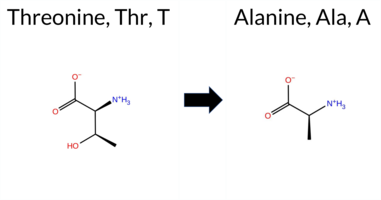 AIThe SynGAP1 missense variant T1305A is listed in ClinVar (ID 411587.0) with an “Uncertain” clinical significance and is present in the gnomAD database (variant ID 6‑33451787‑A‑G). All evaluated in‑silico predictors classify the change as benign: REVEL, PROVEAN, polyPhen‑2 (HumDiv and HumVar), SIFT, ESM1b, FATHMM, AlphaMissense‑Default, and AlphaMissense‑Optimized. No tool reports a pathogenic or likely pathogenic outcome. High‑accuracy assessments reinforce this benign prediction: AlphaMissense‑Optimized is benign, and the SGM Consensus (majority vote of AlphaMissense‑Default, ESM1b, FATHMM, and PROVEAN) is “Likely Benign.” Foldetta results are unavailable. Overall, the computational evidence overwhelmingly supports a benign effect, and this conclusion does not contradict the ClinVar “Uncertain” status. Disclaimer: This summary was generated using AI and should be interpreted alongside expert review. | Likely Benign | Conflicting | 4 | 6-33451787-A-G | 30 | 1.86e-5 | -2.692 | Likely Benign | 0.055 | Likely Benign | Likely Benign | 0.069 | Likely Benign | 1.74 | Neutral | 0.000 | Benign | 0.001 | Benign | 3.24 | Benign | 1.00 | Tolerated | 3.77 | 5 | 1 | 0 | 2.5 | -30.03 | |||||||||||||||||||||||||||
| c.391G>C | G131R 2D 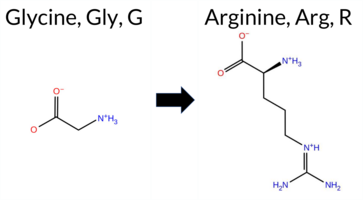 AIThe SynGAP1 missense variant G131R is listed in ClinVar with an “Uncertain” significance and is not reported in gnomAD. Functional prediction tools cluster into two groups: benign predictions come from REVEL, ESM1b, and FATHMM, while pathogenic predictions are made by PROVEAN, polyPhen‑2 (HumDiv and HumVar), SIFT, AlphaMissense‑Default, and AlphaMissense‑Optimized. The SGM Consensus, which aggregates AlphaMissense‑Default, ESM1b, FATHMM, and PROVEAN, is inconclusive due to a 2‑to‑2 split and therefore does not contribute evidence. Foldetta, a protein‑folding stability method combining FoldX‑MD and Rosetta outputs, has no available result for this variant. Overall, the majority of high‑confidence tools predict a pathogenic effect, and the variant is most likely pathogenic based on current predictions, which does not contradict the ClinVar “Uncertain” status. Disclaimer: This summary was generated using AI and should be interpreted alongside expert review. | Uncertain | 1 | -6.564 | Likely Benign | 0.983 | Likely Pathogenic | Likely Pathogenic | 0.099 | Likely Benign | -3.82 | Deleterious | 0.983 | Probably Damaging | 0.656 | Possibly Damaging | 3.92 | Benign | 0.00 | Affected | 3.61 | 5 | -2 | -3 | -4.1 | 99.14 | |||||||||||||||||||||||||||||||
| c.3920C>A | P1307Q 2D 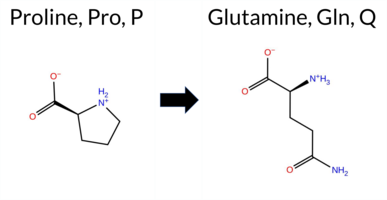 AIThe SynGAP1 missense variant P1307Q is listed in ClinVar (ID 982827.0) with an “Uncertain” clinical significance and is present in gnomAD (variant ID 6‑33451794‑C‑A). Prediction tools that agree on a benign effect include REVEL, PROVEAN, ESM1b, FATHMM, AlphaMissense‑Default, AlphaMissense‑Optimized, and the SGM‑Consensus (majority vote from AlphaMissense‑Default, ESM1b, FATHMM, PROVEAN). Tools that predict a pathogenic effect are polyPhen‑2 HumDiv, polyPhen‑2 HumVar, and SIFT. High‑accuracy assessments show AlphaMissense‑Optimized as benign and the SGM‑Consensus as likely benign; Foldetta results are unavailable. Overall, the majority of evidence points to a benign impact. This conclusion does not contradict the ClinVar status, which remains uncertain. Disclaimer: This summary was generated using AI and should be interpreted alongside expert review. | Likely Benign | Uncertain | 1 | 6-33451794-C-A | -4.227 | Likely Benign | 0.114 | Likely Benign | Likely Benign | 0.192 | Likely Benign | -0.88 | Neutral | 0.988 | Probably Damaging | 0.765 | Possibly Damaging | 2.82 | Benign | 0.03 | Affected | 3.77 | 5 | 0 | -1 | -1.9 | 31.01 | |||||||||||||||||||||||||||||
| c.3920C>T | P1307L 2D  AIThe SynGAP1 missense variant P1307L is listed in ClinVar (ID 1991214.0) as benign and is present in gnomAD (variant ID 6‑33451794‑C‑T). Prediction tools that agree on a benign effect include REVEL, PROVEAN, polyPhen‑2 HumVar, ESM1b, FATHMM, AlphaMissense‑Default, and AlphaMissense‑Optimized. Tools that predict a pathogenic effect are polyPhen‑2 HumDiv and SIFT. The high‑accuracy consensus from SGM (majority vote of AlphaMissense‑Default, ESM1b, FATHMM, and PROVEAN) is “Likely Benign,” and AlphaMissense‑Optimized also predicts benign. Foldetta, a protein‑folding stability method combining FoldX‑MD and Rosetta outputs, has no available result for this variant. Overall, the majority of predictions, including the high‑accuracy consensus, indicate a benign impact. This conclusion aligns with the ClinVar benign classification and does not contradict the reported clinical status. Disclaimer: This summary was generated using AI and should be interpreted alongside expert review. | Likely Benign | Benign | 1 | 6-33451794-C-T | 11 | 6.82e-6 | -4.044 | Likely Benign | 0.144 | Likely Benign | Likely Benign | 0.292 | Likely Benign | -1.49 | Neutral | 0.779 | Possibly Damaging | 0.220 | Benign | 2.82 | Benign | 0.04 | Affected | 3.77 | 5 | -3 | -3 | 5.4 | 16.04 | |||||||||||||||||||||||||||
| c.3922C>T | R1308C 2D  AIThe SynGAP1 missense variant R1308C is listed in ClinVar with an “Uncertain” significance and is present in the gnomAD database (ID 6‑33451796‑C‑T). Prediction tools that agree on a benign effect include REVEL, ESM1b, and AlphaMissense‑Optimized. Those that predict a pathogenic effect are PROVEAN, polyPhen‑2 (HumDiv and HumVar), SIFT, and FATHMM; AlphaMissense‑Default remains uncertain. The high‑accuracy consensus (SGM Consensus) derived from AlphaMissense‑Default, ESM1b, FATHMM, and PROVEAN yields a pathogenic verdict. Foldetta, a protein‑folding stability method combining FoldX‑MD and Rosetta outputs, has no available result for this variant. Overall, the majority of evidence points to a pathogenic impact, and this assessment does not contradict the current ClinVar “Uncertain” status. Disclaimer: This summary was generated using AI and should be interpreted alongside expert review. | Conflicting | 2 | 6-33451796-C-T | 4 | 2.48e-6 | -4.994 | Likely Benign | 0.421 | Ambiguous | Likely Benign | 0.352 | Likely Benign | -4.89 | Deleterious | 0.999 | Probably Damaging | 0.993 | Probably Damaging | 2.31 | Pathogenic | 0.00 | Affected | 3.77 | 5 | -4 | -3 | 7.0 | -53.05 | ||||||||||||||||||||||||||||
| c.3923G>A | R1308H 2D  AIThe SynGAP1 missense variant R1308H (ClinVar ID 1996244.0) is listed as Uncertain in ClinVar and is present in gnomAD (ID 6‑33451797‑G‑A). Prediction tools that agree on a benign effect include REVEL, ESM1b, AlphaMissense‑Default, and AlphaMissense‑Optimized. Tools that agree on a pathogenic effect are PROVEAN, polyPhen‑2 (HumDiv and HumVar), SIFT, and FATHMM. High‑accuracy assessment shows AlphaMissense‑Optimized predicts a benign outcome; the SGM Consensus, derived from a majority vote of AlphaMissense‑Default, ESM1b, FATHMM, and PROVEAN, is inconclusive, and Foldetta results are unavailable. Consequently, the overall computational evidence leans toward a pathogenic interpretation, but the presence of a single high‑accuracy benign prediction and the inconclusive SGM Consensus leave the variant’s effect uncertain. This computational assessment does not contradict the ClinVar status, which remains Uncertain. Disclaimer: This summary was generated using AI and should be interpreted alongside expert review. | Uncertain | 1 | 6-33451797-G-A | 3 | 1.86e-6 | -3.586 | Likely Benign | 0.201 | Likely Benign | Likely Benign | 0.319 | Likely Benign | -3.12 | Deleterious | 0.998 | Probably Damaging | 0.991 | Probably Damaging | 2.33 | Pathogenic | 0.00 | Affected | 3.77 | 5 | 2 | 0 | 1.3 | -19.05 | ||||||||||||||||||||||||||||
| c.3929C>T | T1310M 2D 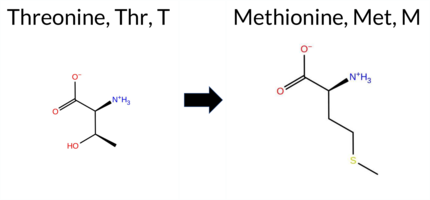 AIThe SynGAP1 missense variant T1310M is listed in ClinVar (ID 2160201.0) as Benign and is present in gnomAD (gnomAD ID 6‑33451803‑C‑T). All evaluated in‑silico predictors report a benign outcome: REVEL, PROVEAN, polyPhen‑2 (HumDiv and HumVar), SIFT, ESM1b, FATHMM, AlphaMissense‑Default, and AlphaMissense‑Optimized. No tool predicts pathogenicity. High‑accuracy assessments corroborate this: AlphaMissense‑Optimized is benign, and the SGM Consensus (majority vote of AlphaMissense‑Default, ESM1b, FATHMM, and PROVEAN) is Likely Benign. Foldetta, a protein‑folding stability method combining FoldX‑MD and Rosetta outputs, has no available result for this variant. Overall, the computational evidence overwhelmingly supports a benign classification, which aligns with the ClinVar status and does not contradict it. Disclaimer: This summary was generated using AI and should be interpreted alongside expert review. | Likely Benign | Benign | 1 | 6-33451803-C-T | 17 | 1.05e-5 | -4.822 | Likely Benign | 0.117 | Likely Benign | Likely Benign | 0.069 | Likely Benign | 2.19 | Neutral | 0.021 | Benign | 0.005 | Benign | 2.98 | Benign | 0.93 | Tolerated | 3.77 | 5 | -1 | -1 | 2.6 | 30.09 | |||||||||||||||||||||||||||
| c.3932T>C | L1311P 2D  AIThe SynGAP1 missense variant L1311P is listed in ClinVar (ID 833866.0) as Benign and is present in gnomAD (variant ID 6‑33451806‑T‑C). Prediction tools that agree on a benign effect include REVEL, PROVEAN, polyPhen‑2 HumVar, SIFT, ESM1b, FATHMM, AlphaMissense‑Default, and AlphaMissense‑Optimized. Only polyPhen‑2 HumDiv predicts a pathogenic outcome. The high‑accuracy consensus from SGM (majority vote of AlphaMissense‑Default, ESM1b, FATHMM, and PROVEAN) yields a Likely Benign classification, and AlphaMissense‑Optimized also reports Benign. Foldetta, a protein‑folding stability method combining FoldX‑MD and Rosetta outputs, is not available for this variant. Overall, the majority of computational evidence supports a benign effect, which is consistent with the ClinVar benign annotation and does not contradict the database status. Disclaimer: This summary was generated using AI and should be interpreted alongside expert review. | Likely Benign | Likely Benign | 1 | 6-33451806-T-C | 1 | 6.21e-7 | -1.831 | Likely Benign | 0.079 | Likely Benign | Likely Benign | 0.123 | Likely Benign | -0.52 | Neutral | 0.579 | Possibly Damaging | 0.335 | Benign | 2.72 | Benign | 0.18 | Tolerated | 3.77 | 5 | -3 | -3 | -5.4 | -16.04 | |||||||||||||||||||||||||||
| c.3941C>T | P1314L 2D  AIThe SynGAP1 missense variant P1314L is listed in ClinVar as a benign alteration (ClinVar ID 646689.0) and is present in the gnomAD database (gnomAD ID 6‑33451815‑C‑T). Functional prediction tools that agree on a benign effect include REVEL, PROVEAN, polyPhen‑2 (HumDiv and HumVar), ESM1b, FATHMM, AlphaMissense‑Default, AlphaMissense‑Optimized, and the SGM‑Consensus (majority vote from AlphaMissense‑Default, ESM1b, FATHMM, and PROVEAN). Only SIFT predicts a pathogenic outcome. High‑accuracy assessments show AlphaMissense‑Optimized as benign and the SGM‑Consensus as likely benign; Foldetta results are unavailable. Overall, the majority of evidence points to a benign impact, which is consistent with the ClinVar classification. Thus, the variant is most likely benign and does not contradict the ClinVar status. Disclaimer: This summary was generated using AI and should be interpreted alongside expert review. | Likely Benign | Likely Benign | 1 | 6-33451815-C-T | 2 | 1.24e-6 | -4.040 | Likely Benign | 0.118 | Likely Benign | Likely Benign | 0.049 | Likely Benign | -0.20 | Neutral | 0.421 | Benign | 0.066 | Benign | 4.19 | Benign | 0.05 | Affected | 3.77 | 5 | -3 | -3 | 5.4 | 16.04 | |||||||||||||||||||||||||||
| c.3943T>C | W1315R 2D 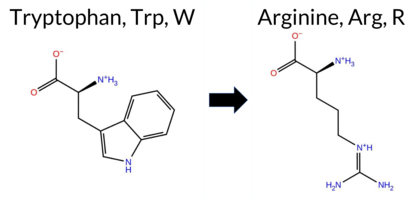 AIThe SynGAP1 missense variant W1315R is listed in ClinVar (ID 1029092.0) with an “Uncertain” clinical significance and is not reported in gnomAD. Functional prediction tools that agree on a benign effect include REVEL, PROVEAN, polyPhen‑2 (HumDiv and HumVar), SIFT, ESM1b, FATHMM, AlphaMissense‑Optimized, and the SGM‑Consensus score (which is a majority vote of AlphaMissense‑Default, ESM1b, FATHMM, and PROVEAN). Only AlphaMissense‑Default predicts a pathogenic outcome. High‑accuracy assessments show AlphaMissense‑Optimized as benign and the SGM‑Consensus as benign; Foldetta results are not available for this variant. Overall, the majority of evidence points to a benign impact, and this conclusion does not contradict the ClinVar “Uncertain” status. Disclaimer: This summary was generated using AI and should be interpreted alongside expert review. | Likely Benign | Uncertain | 1 | 0.205 | Likely Benign | 0.660 | Likely Pathogenic | Likely Benign | 0.114 | Likely Benign | 1.31 | Neutral | 0.000 | Benign | 0.001 | Benign | 4.37 | Benign | 0.91 | Tolerated | 3.77 | 5 | 2 | -3 | -3.6 | -30.03 | ||||||||||||||||||||||||||||||
| c.3949G>A | G1317S 2D  AIThe SynGAP1 missense variant G1317S is listed in ClinVar with an uncertain significance and is present in the gnomAD database. Prediction tools that agree on a benign effect include REVEL, PROVEAN, polyPhen‑2 HumDiv, polyPhen‑2 HumVar, ESM1b, FATHMM, AlphaMissense‑Default, AlphaMissense‑Optimized, and the SGM‑Consensus score (Likely Benign). Only SIFT predicts a pathogenic outcome. High‑accuracy assessments further support a benign interpretation: AlphaMissense‑Optimized returns a benign prediction, and the SGM‑Consensus (derived from the majority vote of AlphaMissense‑Default, ESM1b, FATHMM, and PROVEAN) also indicates benign. Foldetta, a protein‑folding stability method, has no available result for this variant. Overall, the computational evidence overwhelmingly points to a benign effect, which does not contradict the ClinVar uncertain status. Disclaimer: This summary was generated using AI and should be interpreted alongside expert review. | Likely Benign | Conflicting | 3 | 6-33451823-G-A | 1 | 6.26e-7 | -3.522 | Likely Benign | 0.145 | Likely Benign | Likely Benign | 0.092 | Likely Benign | -2.45 | Neutral | 0.127 | Benign | 0.045 | Benign | 4.08 | Benign | 0.00 | Affected | 3.77 | 5 | 1 | 0 | -0.4 | 30.03 | |||||||||||||||||||||||||||
| c.3956C>G | A1319G 2D 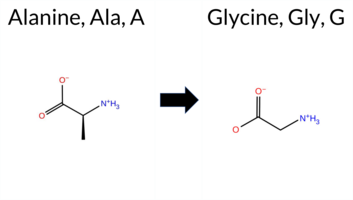 AIThe SynGAP1 missense variant A1319G is listed in ClinVar (ID 1690510.0) with an “Uncertain” clinical significance and is present in gnomAD (variant ID 6‑33451830‑C‑G). Functional prediction tools that agree on a benign effect include REVEL, PROVEAN, SIFT, ESM1b, FATHMM, AlphaMissense‑Default, and AlphaMissense‑Optimized. In contrast, polyPhen‑2 (both HumDiv and HumVar models) predict a pathogenic impact. The SGM‑Consensus, derived from a majority vote of AlphaMissense‑Default, ESM1b, FATHMM, and PROVEAN, reports a “Likely Benign” classification. High‑accuracy assessments further support a benign outcome: AlphaMissense‑Optimized is benign, and the SGM‑Consensus is likely benign; Foldetta results are unavailable. Overall, the majority of evidence points to a benign effect, and this is consistent with the ClinVar “Uncertain” status rather than contradicting it. Thus, the variant is most likely benign based on current predictions. Disclaimer: This summary was generated using AI and should be interpreted alongside expert review. | Likely Benign | Uncertain | 2 | 6-33451830-C-G | -3.927 | Likely Benign | 0.084 | Likely Benign | Likely Benign | 0.128 | Likely Benign | -0.74 | Neutral | 0.819 | Possibly Damaging | 0.581 | Possibly Damaging | 4.07 | Benign | 0.06 | Tolerated | 3.77 | 5 | 1 | 0 | -2.2 | -14.03 | |||||||||||||||||||||||||||||
| c.3958C>T | P1320S 2D  AIThe SynGAP1 missense variant P1320S is listed in ClinVar (ID 469160.0) with an “Uncertain” clinical significance and is present in gnomAD (variant ID 6‑33451832‑C‑T). Functional prediction tools that agree on a benign effect include REVEL, PROVEAN, ESM1b, FATHMM, AlphaMissense‑Default, AlphaMissense‑Optimized, and the SGM‑Consensus (majority vote from AlphaMissense‑Default, ESM1b, FATHMM, PROVEAN). In contrast, polyPhen‑2 (HumDiv and HumVar) and SIFT predict a pathogenic impact. High‑accuracy assessments show AlphaMissense‑Optimized as benign and the SGM‑Consensus as likely benign; Foldetta results are unavailable. Overall, the majority of evidence points to a benign effect, and this is not in conflict with the ClinVar “Uncertain” status. Thus, the variant is most likely benign based on current predictions. Disclaimer: This summary was generated using AI and should be interpreted alongside expert review. | Likely Benign | Uncertain | 1 | 6-33451832-C-T | 2 | 1.28e-6 | -4.928 | Likely Benign | 0.073 | Likely Benign | Likely Benign | 0.097 | Likely Benign | -0.69 | Neutral | 0.980 | Probably Damaging | 0.968 | Probably Damaging | 4.25 | Benign | 0.00 | Affected | 3.77 | 5 | 1 | -1 | 0.8 | -10.04 | |||||||||||||||||||||||||||
| c.3961C>T | P1321S 2D  AIThe SynGAP1 missense variant P1321S is listed in ClinVar (ID 1806027.0) with an “Uncertain” clinical significance and is present in the gnomAD database (gnomAD ID 6‑33451835‑C‑T). All evaluated in‑silico predictors classify the substitution as benign: REVEL, PROVEAN, PolyPhen‑2 (HumDiv and HumVar), SIFT, ESM1b, FATHMM, AlphaMissense‑Default, and AlphaMissense‑Optimized. No tool reports a pathogenic prediction. High‑accuracy assessments corroborate this benign trend: AlphaMissense‑Optimized predicts benign, and the SGM Consensus (majority vote of AlphaMissense‑Default, ESM1b, FATHMM, and PROVEAN) indicates “Likely Benign.” Foldetta, a protein‑folding stability method combining FoldX‑MD and Rosetta outputs, did not provide a result for this variant, so its status is unavailable. Overall, the computational evidence strongly supports a benign effect, which is consistent with the ClinVar “Uncertain” designation rather than contradicting it. Disclaimer: This summary was generated using AI and should be interpreted alongside expert review. | Likely Benign | Uncertain | 2 | 6-33451835-C-T | 10 | 6.46e-6 | -4.897 | Likely Benign | 0.077 | Likely Benign | Likely Benign | 0.049 | Likely Benign | 0.68 | Neutral | 0.028 | Benign | 0.004 | Benign | 4.27 | Benign | 0.71 | Tolerated | 3.77 | 5 | 1 | -1 | 0.8 | -10.04 | 10.1016/j.ajhg.2020.11.011 | ||||||||||||||||||||||||||
| c.3962C>A | P1321Q 2D  AIThe SynGAP1 missense variant P1321Q is listed in ClinVar (ID 833687.0) as benign and is present in gnomAD (variant ID 6‑33451836‑C‑A). Prediction tools that agree on a benign effect include REVEL, PROVEAN, polyPhen‑2 HumVar, SIFT, ESM1b, FATHMM, AlphaMissense‑Default, and AlphaMissense‑Optimized. Only polyPhen‑2 HumDiv predicts a pathogenic outcome. The high‑accuracy consensus from SGM (majority vote of AlphaMissense‑Default, ESM1b, FATHMM, and PROVEAN) yields a “Likely Benign” classification, and AlphaMissense‑Optimized also reports benign. Foldetta, a protein‑folding stability method combining FoldX‑MD and Rosetta outputs, has no available result for this variant. Overall, the majority of evidence—including the high‑confidence SGM consensus and AlphaMissense‑Optimized—supports a benign impact. This conclusion aligns with the ClinVar benign status, with no contradiction. Disclaimer: This summary was generated using AI and should be interpreted alongside expert review. | Likely Benign | Benign | 1 | 6-33451836-C-A | 1 | 6.58e-7 | -5.594 | Likely Benign | 0.079 | Likely Benign | Likely Benign | 0.055 | Likely Benign | -0.74 | Neutral | 0.659 | Possibly Damaging | 0.034 | Benign | 4.24 | Benign | 0.09 | Tolerated | 3.77 | 5 | 0 | -1 | -1.9 | 31.01 | |||||||||||||||||||||||||||
| c.3964G>C | A1322P 2D 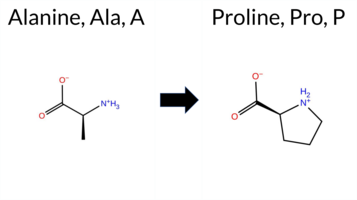 AIThe SynGAP1 missense variant A1322P is reported in ClinVar (ID 1169945.0) as benign and is present in gnomAD (variant ID 6‑33451838‑G‑C). Across the available in‑silico predictors, all tools uniformly classify the substitution as benign: REVEL, PROVEAN, polyPhen‑2 (HumDiv and HumVar), SIFT, ESM1b, FATHMM, AlphaMissense‑Default, and AlphaMissense‑Optimized all return benign predictions. No tool in the dataset indicates a pathogenic effect. High‑accuracy assessments corroborate this consensus: AlphaMissense‑Optimized predicts benign, and the SGM Consensus (majority vote of AlphaMissense‑Default, ESM1b, FATHMM, and PROVEAN) yields a “Likely Benign” verdict. The Foldetta protein‑folding stability analysis is not available for this variant. Overall, the computational evidence strongly supports a benign classification, which is consistent with the ClinVar status and does not contradict it. Disclaimer: This summary was generated using AI and should be interpreted alongside expert review. | Likely Benign | Benign | 1 | 6-33451838-G-C | -1.153 | Likely Benign | 0.063 | Likely Benign | Likely Benign | 0.090 | Likely Benign | 0.03 | Neutral | 0.000 | Benign | 0.000 | Benign | 4.15 | Benign | 0.23 | Tolerated | 3.77 | 5 | 1 | -1 | -3.4 | 26.04 | |||||||||||||||||||||||||||||
| c.3970C>T | P1324S 2D  AIThe SynGAP1 missense variant P1324S is listed in ClinVar as Benign (ClinVar ID 1137951.0) and is present in gnomAD (ID 6‑33451844‑C‑T). Prediction tools that agree on a benign effect include REVEL, PROVEAN, polyPhen‑2 HumDiv, polyPhen‑2 HumVar, ESM1b, FATHMM, AlphaMissense‑Default, AlphaMissense‑Optimized, and the SGM‑Consensus (majority vote from AlphaMissense‑Default, ESM1b, FATHMM, and PROVEAN). Only SIFT predicts a pathogenic outcome. High‑accuracy assessments show AlphaMissense‑Optimized as benign and the SGM‑Consensus (majority vote) also benign; Foldetta results are unavailable. Based on the collective predictions, the variant is most likely benign, which is consistent with its ClinVar classification. Disclaimer: This summary was generated using AI and should be interpreted alongside expert review. | Likely Benign | Likely Benign | 1 | 6-33451844-C-T | 5 | 3.26e-6 | -5.451 | Likely Benign | 0.068 | Likely Benign | Likely Benign | 0.049 | Likely Benign | 0.35 | Neutral | 0.225 | Benign | 0.092 | Benign | 4.33 | Benign | 0.00 | Affected | 4.32 | 1 | 1 | -1 | 0.8 | -10.04 | |||||||||||||||||||||||||||
| c.3974C>T | P1325L 2D  AIThe SynGAP1 missense variant P1325L is listed in ClinVar (ID 1720534.0) with an uncertain significance designation and is present in gnomAD (variant ID 6‑33451848‑C‑T). Functional prediction tools that agree on a benign effect include REVEL, PROVEAN, polyPhen‑2 (HumDiv and HumVar), ESM1b, FATHMM, AlphaMissense‑Default, and AlphaMissense‑Optimized. Only SIFT predicts a pathogenic outcome. The SGM‑Consensus, derived from a majority vote of AlphaMissense‑Default, ESM1b, FATHMM, and PROVEAN, reports a likely benign classification. High‑accuracy assessments further support a benign interpretation: AlphaMissense‑Optimized is benign, and the SGM‑Consensus is likely benign; Foldetta results are unavailable. Overall, the preponderance of evidence points to a benign effect for P1325L, which does not contradict the ClinVar uncertain status. Disclaimer: This summary was generated using AI and should be interpreted alongside expert review. | Likely Benign | Uncertain | 1 | 6-33451848-C-T | -5.256 | Likely Benign | 0.085 | Likely Benign | Likely Benign | 0.146 | Likely Benign | -1.05 | Neutral | 0.000 | Benign | 0.000 | Benign | 4.05 | Benign | 0.00 | Affected | 4.32 | 1 | -3 | -3 | 5.4 | 16.04 | |||||||||||||||||||||||||||||
| c.3977C>A | P1326Q 2D  AIThe SynGAP1 missense variant P1326Q is listed in ClinVar (ID 2806103.0) with an “Uncertain” status and is present in gnomAD (variant ID 6‑33451851‑C‑A). Prediction tools that agree on a benign effect include REVEL, PROVEAN, ESM1b, FATHMM, AlphaMissense‑Default, AlphaMissense‑Optimized, and the SGM‑Consensus (majority vote from AlphaMissense‑Default, ESM1b, FATHMM, PROVEAN). Tools that predict a pathogenic effect are polyPhen‑2 HumDiv, polyPhen‑2 HumVar, and SIFT. High‑accuracy assessments show AlphaMissense‑Optimized as benign and the SGM‑Consensus as likely benign; Foldetta results are unavailable. Overall, the majority of evidence points to a benign impact. This conclusion does not contradict the ClinVar “Uncertain” classification, which remains inconclusive. Disclaimer: This summary was generated using AI and should be interpreted alongside expert review. | Likely Benign | Uncertain | 1 | 6-33451851-C-A | 1 | 6.40e-7 | -5.422 | Likely Benign | 0.128 | Likely Benign | Likely Benign | 0.138 | Likely Benign | -0.86 | Neutral | 0.999 | Probably Damaging | 0.994 | Probably Damaging | 3.62 | Benign | 0.00 | Affected | 3.77 | 5 | -1 | 0 | -1.9 | 31.01 | |||||||||||||||||||||||||||
| c.3977C>G | P1326R 2D  AIThe SynGAP1 missense variant P1326R is listed in ClinVar (ID 2429486.0) with an “Uncertain” status and is not reported in gnomAD. Functional prediction tools that agree on a benign effect include REVEL, PROVEAN, ESM1b, FATHMM, AlphaMissense‑Default, and AlphaMissense‑Optimized. In contrast, polyPhen‑2 (HumDiv and HumVar) and SIFT all predict a pathogenic impact. The SGM‑Consensus, derived from a majority vote of AlphaMissense‑Default, ESM1b, FATHMM, and PROVEAN, is “Likely Benign.” High‑accuracy assessments show AlphaMissense‑Optimized as benign and the SGM‑Consensus (majority vote) also benign; Foldetta stability analysis is unavailable. Overall, the majority of evidence points to a benign effect, and this conclusion does not contradict the ClinVar “Uncertain” classification. Disclaimer: This summary was generated using AI and should be interpreted alongside expert review. | Likely Benign | Uncertain | 1 | -5.097 | Likely Benign | 0.240 | Likely Benign | Likely Benign | 0.133 | Likely Benign | -0.82 | Neutral | 0.999 | Probably Damaging | 0.994 | Probably Damaging | 3.62 | Benign | 0.00 | Affected | 3.77 | 5 | 0 | -2 | -2.9 | 59.07 | ||||||||||||||||||||||||||||||
| c.3977C>T | P1326L 2D  AIThe SynGAP1 missense variant P1326L is listed in ClinVar (ID 1004879.0) with an “Uncertain” clinical significance and is not reported in gnomAD. Functional prediction tools that agree on a benign effect include REVEL, PROVEAN, ESM1b, FATHMM, AlphaMissense‑Default, and AlphaMissense‑Optimized. In contrast, polyPhen‑2 (HumDiv and HumVar) and SIFT predict a pathogenic impact. The high‑accuracy consensus from SGM (majority vote of AlphaMissense‑Default, ESM1b, FATHMM, and PROVEAN) classifies the variant as “Likely Benign,” and AlphaMissense‑Optimized also predicts benign. No Foldetta (FoldX‑MD/ Rosetta) stability result is available for this variant. Overall, the majority of evidence—including the high‑confidence SGM consensus and AlphaMissense‑Optimized prediction—supports a benign classification, which does not contradict the current ClinVar status of uncertainty. Disclaimer: This summary was generated using AI and should be interpreted alongside expert review. | Likely Benign | Uncertain | 1 | -5.541 | Likely Benign | 0.115 | Likely Benign | Likely Benign | 0.117 | Likely Benign | -1.06 | Neutral | 0.999 | Probably Damaging | 0.994 | Probably Damaging | 3.62 | Benign | 0.00 | Affected | 3.77 | 5 | -3 | -3 | 5.4 | 16.04 | ||||||||||||||||||||||||||||||
| c.3979C>T | P1327S 2D  AIThe SynGAP1 missense variant P1327S is listed in ClinVar with an “Uncertain” status and is present in gnomAD (ID 6‑33451853‑C‑T). Functional prediction tools that agree on a benign effect include REVEL, PROVEAN, SIFT, ESM1b, FATHMM, AlphaMissense‑Default, AlphaMissense‑Optimized, and the SGM‑Consensus (majority vote from AlphaMissense‑Default, ESM1b, FATHMM, PROVEAN). In contrast, polyPhen‑2 (both HumDiv and HumVar models) predict a pathogenic outcome. High‑accuracy assessments show AlphaMissense‑Optimized as benign and the SGM‑Consensus as likely benign; the Foldetta protein‑folding stability analysis is unavailable for this variant. Overall, the majority of evidence points to a benign effect, and this conclusion does not contradict the ClinVar “Uncertain” classification. Disclaimer: This summary was generated using AI and should be interpreted alongside expert review. | Likely Benign | Uncertain | 1 | 6-33451853-C-T | -4.744 | Likely Benign | 0.131 | Likely Benign | Likely Benign | 0.092 | Likely Benign | 0.28 | Neutral | 0.980 | Probably Damaging | 0.857 | Possibly Damaging | 4.25 | Benign | 0.71 | Tolerated | 3.77 | 5 | 1 | -1 | 0.8 | -10.04 | |||||||||||||||||||||||||||||
| c.3980C>T | P1327L 2D  AIThe SynGAP1 missense variant P1327L is listed in ClinVar with an uncertain significance and is present in gnomAD (ID 6‑33451854‑C‑T). Prediction tools that agree on a benign effect include REVEL, PROVEAN, SIFT, ESM1b, FATHMM, AlphaMissense‑Default, and AlphaMissense‑Optimized. Tools that predict a pathogenic effect are polyPhen‑2 HumDiv and polyPhen‑2 HumVar. The high‑accuracy AlphaMissense‑Optimized score is benign, and the SGM Consensus—derived from the majority vote of AlphaMissense‑Default, ESM1b, FATHMM, and PROVEAN—also indicates a benign outcome. Foldetta results are not available for this variant. Overall, the majority of computational evidence supports a benign classification, which is consistent with the ClinVar uncertain status rather than contradicting it. Disclaimer: This summary was generated using AI and should be interpreted alongside expert review. | Likely Benign | Uncertain | 1 | 6-33451854-C-T | 2 | 1.28e-6 | -5.264 | Likely Benign | 0.242 | Likely Benign | Likely Benign | 0.142 | Likely Benign | -1.24 | Neutral | 0.994 | Probably Damaging | 0.908 | Possibly Damaging | 4.12 | Benign | 0.10 | Tolerated | 3.77 | 5 | -3 | -3 | 5.4 | 16.04 | |||||||||||||||||||||||||||
| c.3983G>A | R1328Q 2D  AIThe SynGAP1 missense variant R1328Q is listed in ClinVar (ID 1805359.0) with an “Uncertain” clinical significance and is present in gnomAD (variant ID 6‑33451857‑G‑A). Prediction tools that agree on a benign effect include REVEL, PROVEAN, polyPhen‑2 HumVar, ESM1b, FATHMM, AlphaMissense‑Default, AlphaMissense‑Optimized, and the SGM‑Consensus (Likely Benign). Tools that predict a pathogenic effect are polyPhen‑2 HumDiv and SIFT. High‑accuracy assessments show AlphaMissense‑Optimized as benign and the SGM‑Consensus as Likely Benign; a Foldetta stability analysis is unavailable. Overall, the majority of evidence points to a benign impact, and this is not in conflict with the ClinVar “Uncertain” status. Disclaimer: This summary was generated using AI and should be interpreted alongside expert review. | Likely Benign | Uncertain | 3 | 6-33451857-G-A | 35 | 1.49e-4 | -2.921 | Likely Benign | 0.273 | Likely Benign | Likely Benign | 0.043 | Likely Benign | -1.02 | Neutral | 0.799 | Possibly Damaging | 0.098 | Benign | 4.12 | Benign | 0.03 | Affected | 3.77 | 5 | 1 | 1 | 1.0 | -28.06 | |||||||||||||||||||||||||||
| c.3983G>C | R1328P 2D 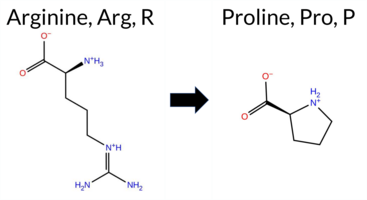 AIThe SynGAP1 missense variant R1328P (ClinVar ID 1258976.0) is classified as Benign in ClinVar and is observed in gnomAD (6‑33451857‑G‑C). Prediction tools that agree on a benign effect include REVEL, PROVEAN, ESM1b, FATHMM, AlphaMissense‑Optimized, and the SGM‑Consensus (majority vote from AlphaMissense‑Default, ESM1b, FATHMM, PROVEAN). Tools that predict a pathogenic effect are polyPhen‑2 HumDiv, polyPhen‑2 HumVar, and SIFT. AlphaMissense‑Default is uncertain, and Foldetta results are unavailable. High‑accuracy assessments show AlphaMissense‑Optimized as benign and the SGM‑Consensus also indicates a likely benign outcome; no Foldetta stability data are reported. Overall, the majority of evidence points to a benign impact, aligning with the ClinVar designation and not contradicting it. Disclaimer: This summary was generated using AI and should be interpreted alongside expert review. | Likely Benign | Benign | 1 | 6-33451857-G-C | -1.220 | Likely Benign | 0.466 | Ambiguous | Likely Benign | 0.060 | Likely Benign | -2.01 | Neutral | 0.927 | Possibly Damaging | 0.452 | Possibly Damaging | 4.06 | Benign | 0.01 | Affected | 3.77 | 5 | 0 | -2 | 2.9 | -59.07 | |||||||||||||||||||||||||||||
| c.3995C>T | T1332M 2D  AISynGAP1 missense variant T1332M is listed as Benign in ClinVar (ID 794425) and is present in gnomAD (6‑33451869‑C‑T). Functional prediction tools show mixed results: benign calls come from REVEL, ESM1b, and FATHMM, while pathogenic calls are made by PROVEAN, polyPhen‑2 (HumDiv and HumVar), SIFT, and AlphaMissense‑Default. High‑accuracy assessments are inconclusive: AlphaMissense‑Optimized returned an uncertain result, the SGM Consensus (majority vote of AlphaMissense‑Default, ESM1b, FATHMM, PROVEAN) is a tie, and no Foldetta stability data are available. Overall, the majority of evidence points toward a pathogenic effect, which contradicts the ClinVar benign classification. Disclaimer: This summary was generated using AI and should be interpreted alongside expert review. | Likely Benign | 1 | 6-33451869-C-T | 20 | 1.86e-5 | -4.107 | Likely Benign | 0.948 | Likely Pathogenic | Ambiguous | 0.252 | Likely Benign | -3.63 | Deleterious | 1.000 | Probably Damaging | 0.991 | Probably Damaging | 2.95 | Benign | 0.00 | Affected | 3.77 | 5 | -1 | -1 | 2.6 | 30.09 | ||||||||||||||||||||||||||||
| c.3G>A | M1I 2D  AIThe SynGAP1 missense variant M1I is listed in ClinVar (ID 833646.0) with an uncertain significance annotation and is not reported in gnomAD. Functional prediction tools largely agree on a benign effect: REVEL, PROVEAN, polyPhen‑2 HumDiv, polyPhen‑2 HumVar, ESM1b, and FATHMM all classify the substitution as benign, while SIFT uniquely predicts it to be pathogenic. The consensus score from the SGM framework, which aggregates AlphaMissense‑Default, ESM1b, FATHMM, and PROVEAN, reports a likely benign outcome. High‑accuracy predictors are incomplete: AlphaMissense‑Optimized and the Foldetta stability assessment are unavailable for this variant. Taking the collective evidence into account, the variant is most likely benign, and this assessment does not conflict with the ClinVar uncertain status. Disclaimer: This summary was generated using AI and should be interpreted alongside expert review. | Likely Benign | Conflicting | 3 | -5.397 | Likely Benign | 0.227 | Likely Benign | -0.17 | Neutral | 0.001 | Benign | 0.000 | Benign | 4.25 | Benign | 0.00 | Affected | 4.32 | 1 | 2 | 1 | 2.6 | -18.03 | |||||||||||||||||||||||||||||||||
| c.4000A>G | N1334D 2D 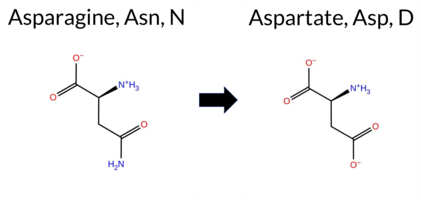 AIThe SynGAP1 missense variant N1334D (ClinVar ID 3653769.0) is listed as Uncertain in ClinVar and is present in gnomAD (ID 6‑33451874‑A‑G). Functional prediction tools show a split: benign calls come from REVEL, ESM1b, FATHMM, and AlphaMissense‑Optimized, while pathogenic calls come from PROVEAN, polyPhen‑2 (HumDiv and HumVar), SIFT, and AlphaMissense‑Default. High‑accuracy assessments give a benign result from AlphaMissense‑Optimized, an inconclusive SGM Consensus (a 2‑vs‑2 majority vote among AlphaMissense‑Default, ESM1b, FATHMM, and PROVEAN), and no available Foldetta stability data. Overall, the majority of predictions (5/10) indicate pathogenicity, and the high‑accuracy tools do not overturn this trend. Therefore, the variant is most likely pathogenic, which does not contradict its ClinVar status of Uncertain. Disclaimer: This summary was generated using AI and should be interpreted alongside expert review. | Uncertain | 1 | 6-33451874-A-G | -4.584 | Likely Benign | 0.674 | Likely Pathogenic | Likely Benign | 0.126 | Likely Benign | -3.06 | Deleterious | 0.886 | Possibly Damaging | 0.522 | Possibly Damaging | 3.55 | Benign | 0.00 | Affected | 3.77 | 5 | 1 | 2 | 0.0 | 0.98 | ||||||||||||||||||||||||||||||
| c.4003G>A | G1335S 2D  AIThe SynGAP1 missense variant G1335S is listed in ClinVar with an “Uncertain” status and is present in gnomAD (ID 6‑33451877‑G‑A). Prediction tools that agree on a benign effect include REVEL and ESM1b, whereas the remaining tools (PROVEAN, polyPhen‑2 HumDiv, polyPhen‑2 HumVar, SIFT, FATHMM, AlphaMissense‑Default, AlphaMissense‑Optimized) all predict a pathogenic outcome. High‑accuracy assessments further support a deleterious impact: AlphaMissense‑Optimized classifies the variant as pathogenic, and the SGM Consensus (majority vote from AlphaMissense‑Default, ESM1b, FATHMM, PROVEAN) reports it as Likely Pathogenic. No Foldetta stability prediction is available for this variant. Overall, the majority of computational evidence indicates that G1335S is most likely pathogenic, which is consistent with the ClinVar “Uncertain” classification rather than contradicting it. Disclaimer: This summary was generated using AI and should be interpreted alongside expert review. | Likely Pathogenic | Conflicting | 2 | 6-33451877-G-A | 3 | 2.37e-6 | -4.495 | Likely Benign | 0.986 | Likely Pathogenic | Likely Pathogenic | 0.362 | Likely Benign | -3.79 | Deleterious | 1.000 | Probably Damaging | 0.997 | Probably Damaging | 2.04 | Pathogenic | 0.00 | Affected | 3.77 | 5 | 1 | 0 | -0.4 | 30.03 | |||||||||||||||||||||||||||
| c.4006G>A | E1336K 2D  AISynGAP1 missense variant E1336K is listed in ClinVar as benign (ClinVar ID 984837.0) and is present in gnomAD (6‑33451880‑G‑A). Prediction tools that agree on a benign effect include REVEL, PROVEAN, polyPhen‑2 HumVar, ESM1b, and FATHMM. Tools that predict a pathogenic effect are polyPhen‑2 HumDiv, SIFT, AlphaMissense‑Default, and AlphaMissense‑Optimized. The SGM‑Consensus, which aggregates AlphaMissense‑Default, ESM1b, FATHMM, and PROVEAN, reports a likely benign classification. High‑accuracy assessments show AlphaMissense‑Optimized as pathogenic, while the SGM‑Consensus remains benign; Foldetta stability analysis is unavailable. Overall, the majority of predictions lean toward a benign impact, aligning with the ClinVar designation, though a single high‑accuracy tool suggests pathogenicity. Thus, the variant is most likely benign, and this conclusion does not contradict its ClinVar status. Disclaimer: This summary was generated using AI and should be interpreted alongside expert review. | Likely Benign | Benign | 2 | 6-33451880-G-A | 6 | 4.20e-6 | -4.697 | Likely Benign | 0.977 | Likely Pathogenic | Likely Pathogenic | 0.272 | Likely Benign | -2.44 | Neutral | 0.748 | Possibly Damaging | 0.079 | Benign | 3.23 | Benign | 0.00 | Affected | 3.77 | 5 | 0 | 1 | -0.4 | -0.94 | |||||||||||||||||||||||||||
| c.4008G>C | E1336D 2D  AIThe SynGAP1 missense variant E1336D is listed in ClinVar (ID 3323942.0) as benign and is not reported in gnomAD. Prediction tools that agree on a benign effect include REVEL, PROVEAN, polyPhen‑2 (HumDiv and HumVar), ESM1b, FATHMM, AlphaMissense‑Optimized, and the SGM‑Consensus score (Likely Benign). Tools that predict a pathogenic effect are SIFT and AlphaMissense‑Default. The SGM‑Consensus result is a majority vote from AlphaMissense‑Default, ESM1b, FATHMM, and PROVEAN, yielding a benign classification. High‑accuracy assessments show AlphaMissense‑Optimized as benign and the SGM‑Consensus as likely benign; Foldetta results are unavailable. Overall, the majority of evidence points to a benign impact, consistent with the ClinVar benign designation. Thus, the variant is most likely benign and does not contradict ClinVar status. Disclaimer: This summary was generated using AI and should be interpreted alongside expert review. | Likely Benign | Likely Benign | 1 | -3.344 | Likely Benign | 0.596 | Likely Pathogenic | Likely Benign | 0.062 | Likely Benign | -1.92 | Neutral | 0.001 | Benign | 0.003 | Benign | 3.30 | Benign | 0.00 | Affected | 3.77 | 5 | 2 | 3 | 0.0 | -14.03 | ||||||||||||||||||||||||||||||
| c.4013G>A | R1338Q 2D  AIThe SynGAP1 missense variant R1338Q is listed in ClinVar (ID 450879.0) with an “Uncertain” clinical significance and is present in gnomAD (variant ID 6‑33451887‑G‑A). Functional prediction tools that agree on a benign effect include REVEL, PROVEAN, polyPhen‑2 HumVar, ESM1b, FATHMM, AlphaMissense‑Default, AlphaMissense‑Optimized, and the SGM‑Consensus (majority vote) which reports it as “Likely Benign.” In contrast, polyPhen‑2 HumDiv and SIFT predict a pathogenic impact. High‑accuracy assessments show AlphaMissense‑Optimized as benign and the SGM‑Consensus as likely benign; a Foldetta stability analysis is not available. Overall, the majority of evidence points to a benign effect, and this conclusion does not contradict the ClinVar status, which remains uncertain. Disclaimer: This summary was generated using AI and should be interpreted alongside expert review. | Likely Benign | Conflicting | 3 | 6-33451887-G-A | 12 | 8.40e-6 | -3.494 | Likely Benign | 0.317 | Likely Benign | Likely Benign | 0.076 | Likely Benign | -1.87 | Neutral | 0.896 | Possibly Damaging | 0.194 | Benign | 3.81 | Benign | 0.02 | Affected | 3.77 | 5 | 1 | 1 | 1.0 | -28.06 | |||||||||||||||||||||||||||
| c.401G>A | S134N 2D  AIThe SynGAP1 missense variant S134N is listed in ClinVar with an “Uncertain” status (ClinVar ID 2819575.0) and is not reported in gnomAD. Prediction tools that agree on a benign effect include REVEL, PROVEAN, polyPhen‑2 (HumDiv and HumVar), ESM1b, and FATHMM. Those that predict a pathogenic effect are SIFT and AlphaMissense‑Default. The remaining tools—AlphaMissense‑Optimized and the SGM‑Consensus—are inconclusive; the consensus score is “Likely Benign” based on a majority vote of AlphaMissense‑Default, ESM1b, FATHMM, and PROVEAN. High‑accuracy assessments show AlphaMissense‑Optimized as uncertain, SGM‑Consensus as likely benign, and Foldetta (combining FoldX‑MD and Rosetta) has no available result. Overall, the balance of evidence points to a benign impact, which does not contradict the current ClinVar “Uncertain” classification. Disclaimer: This summary was generated using AI and should be interpreted alongside expert review. | Likely Benign | Uncertain | 1 | -5.534 | Likely Benign | 0.813 | Likely Pathogenic | Ambiguous | 0.075 | Likely Benign | -1.62 | Neutral | 0.001 | Benign | 0.002 | Benign | 3.90 | Benign | 0.00 | Affected | 3.61 | 5 | 1 | 1 | -2.7 | 27.03 | ||||||||||||||||||||||||||||||
| c.4021G>A | A1341T 2D  AIThe SynGAP1 missense variant A1341T is listed in ClinVar (ID 837815.0) with an “Uncertain” clinical significance and is present in gnomAD (variant ID 6‑33451895‑G‑A). Functional prediction tools largely agree on a benign effect: REVEL, PROVEAN, polyPhen‑2 (HumDiv and HumVar), ESM1b, FATHMM, AlphaMissense‑Default, and AlphaMissense‑Optimized all report benign or likely benign. Only SIFT predicts a pathogenic effect. The SGM‑Consensus, derived from a majority vote of AlphaMissense‑Default, ESM1b, FATHMM, and PROVEAN, also indicates a likely benign outcome. High‑accuracy assessments confirm this: AlphaMissense‑Optimized is benign, and the SGM‑Consensus is likely benign; Foldetta results are unavailable. Overall, the preponderance of evidence points to a benign impact for A1341T, which is consistent with the ClinVar “Uncertain” status rather than contradicting it. Disclaimer: This summary was generated using AI and should be interpreted alongside expert review. | Likely Benign | Conflicting | 3 | 6-33451895-G-A | 45 | 3.44e-5 | -3.224 | Likely Benign | 0.081 | Likely Benign | Likely Benign | 0.099 | Likely Benign | -0.58 | Neutral | 0.000 | Benign | 0.000 | Benign | 4.09 | Benign | 0.03 | Affected | 3.77 | 5 | 1 | 0 | -2.5 | 30.03 | |||||||||||||||||||||||||||
| c.4021G>T | A1341S 2D 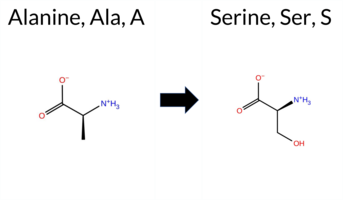 AIThe SynGAP1 missense variant A1341S is listed in ClinVar with an “Uncertain” status and is present in gnomAD (variant ID 6-33451895-G-T). All available in silico predictors agree on a benign effect: REVEL, PROVEAN, polyPhen‑2 (HumDiv and HumVar), SIFT, ESM1b, FATHMM, AlphaMissense‑Default, and AlphaMissense‑Optimized all return benign scores, and the SGM‑Consensus (majority vote of AlphaMissense‑Default, ESM1b, FATHMM, and PROVEAN) is “Likely Benign.” No tool predicts pathogenicity. High‑accuracy assessments corroborate this: AlphaMissense‑Optimized is benign, and the SGM‑Consensus is benign; Foldetta results are not available. Based on the collective predictions, the variant is most likely benign, and this conclusion does not contradict the ClinVar “Uncertain” classification. Disclaimer: This summary was generated using AI and should be interpreted alongside expert review. | Likely Benign | Uncertain | 1 | 6-33451895-G-T | -2.867 | Likely Benign | 0.078 | Likely Benign | Likely Benign | 0.099 | Likely Benign | 0.80 | Neutral | 0.000 | Benign | 0.001 | Benign | 4.40 | Benign | 1.00 | Tolerated | 3.77 | 5 | 1 | 1 | -2.6 | 16.00 | |||||||||||||||||||||||||||||
| c.404G>A | R135Q 2D  AIThe SynGAP1 missense variant R135Q is listed in ClinVar with an uncertain significance and is present in gnomAD (ID 6‑33432701‑G‑A). Functional prediction tools cluster into two groups: benign predictions include REVEL, PROVEAN, polyPhen‑2 HumDiv, polyPhen‑2 HumVar, and FATHMM; pathogenic predictions come from SIFT, ESM1b, and AlphaMissense‑Default. The remaining high‑accuracy assessments are inconclusive: AlphaMissense‑Optimized is uncertain, the SGM Consensus (majority vote of AlphaMissense‑Default, ESM1b, FATHMM, PROVEAN) is a 2‑to‑2 tie, and Foldetta stability analysis is not available. Overall, the balance of evidence favors a benign effect, and this conclusion does not conflict with the ClinVar designation of uncertain significance. Disclaimer: This summary was generated using AI and should be interpreted alongside expert review. | Uncertain | 1 | 6-33432701-G-A | 5 | 3.84e-6 | -8.011 | Likely Pathogenic | 0.853 | Likely Pathogenic | Ambiguous | 0.087 | Likely Benign | -1.94 | Neutral | 0.327 | Benign | 0.100 | Benign | 3.76 | Benign | 0.02 | Affected | 3.61 | 5 | 1 | 1 | 1.0 | -28.06 | ||||||||||||||||||||||||||||
| c.406C>T | R136W 2D  AIThe SynGAP1 missense variant R136W is listed in ClinVar (ID 1479441.0) with an “Uncertain” status and is not reported in gnomAD. Prediction tools that agree on a benign effect include REVEL, polyPhen‑2 HumVar, and FATHMM, whereas pathogenic predictions are made by PROVEAN, polyPhen‑2 HumDiv, SIFT, ESM1b, AlphaMissense‑Default, and AlphaMissense‑Optimized. The SGM‑Consensus, derived from a majority vote of AlphaMissense‑Default, ESM1b, FATHMM, and PROVEAN, classifies the variant as Likely Pathogenic. High‑accuracy assessments further support pathogenicity: AlphaMissense‑Optimized predicts a deleterious effect, and the SGM‑Consensus also indicates Likely Pathogenic. Foldetta, a protein‑folding stability method combining FoldX‑MD and Rosetta outputs, has no available result for this variant. Overall, the majority of computational evidence points to a pathogenic impact, which does not contradict the ClinVar “Uncertain” classification. Disclaimer: This summary was generated using AI and should be interpreted alongside expert review. | Likely Pathogenic | Uncertain | 2 | -10.453 | Likely Pathogenic | 0.989 | Likely Pathogenic | Likely Pathogenic | 0.237 | Likely Benign | -4.71 | Deleterious | 0.965 | Probably Damaging | 0.416 | Benign | 3.45 | Benign | 0.00 | Affected | 3.61 | 5 | 2 | -3 | 3.6 | 30.03 | ||||||||||||||||||||||||||||||
| c.407G>A | R136Q 2D  AIThe SynGAP1 R136Q variant is listed in ClinVar as benign and is present in gnomAD (6‑33432704‑G‑A). Prediction tools that agree on a benign effect include REVEL, PROVEAN, polyPhen‑2 HumVar, and FATHMM, while those that predict a pathogenic effect are polyPhen‑2 HumDiv, SIFT, ESM1b, and AlphaMissense‑Default. AlphaMissense‑Optimized returns an uncertain result. The SGM Consensus, derived from a majority vote of AlphaMissense‑Default, ESM1b, FATHMM, and PROVEAN, is inconclusive due to a 2‑vs‑2 split, and Foldetta (a protein‑folding stability method combining FoldX‑MD and Rosetta outputs) has no reported result for this variant. Based on the available predictions, the variant is most likely benign, which aligns with its ClinVar status. Disclaimer: This summary was generated using AI and should be interpreted alongside expert review. | Benign | 1 | 6-33432704-G-A | 13 | 9.17e-6 | -11.146 | Likely Pathogenic | 0.950 | Likely Pathogenic | Ambiguous | 0.190 | Likely Benign | -2.26 | Neutral | 0.957 | Probably Damaging | 0.342 | Benign | 3.52 | Benign | 0.01 | Affected | 3.61 | 5 | 1 | 1 | 1.0 | -28.06 | ||||||||||||||||||||||||||||
| c.407G>C | R136P 2D  AIThe SynGAP1 missense variant R136P is listed in ClinVar (ID 579340.0) with an “Uncertain” status and is not reported in gnomAD. Prediction tools that agree on a benign effect are REVEL and FATHMM, whereas the remaining tools—PROVEAN, polyPhen‑2 (HumDiv and HumVar), SIFT, ESM1b, AlphaMissense‑Default, AlphaMissense‑Optimized, and the SGM‑Consensus—predict a pathogenic outcome. High‑accuracy assessments further support pathogenicity: AlphaMissense‑Optimized is pathogenic, and the SGM‑Consensus (derived from a majority vote of AlphaMissense‑Default, ESM1b, FATHMM, and PROVEAN) also indicates pathogenicity. Foldetta, a protein‑folding stability method combining FoldX‑MD and Rosetta outputs, has no available result for this variant. Overall, the preponderance of evidence points to a pathogenic effect, which does not contradict the ClinVar “Uncertain” classification. Disclaimer: This summary was generated using AI and should be interpreted alongside expert review. | Likely Pathogenic | Uncertain | 1 | -11.952 | Likely Pathogenic | 0.981 | Likely Pathogenic | Likely Pathogenic | 0.277 | Likely Benign | -3.72 | Deleterious | 0.910 | Possibly Damaging | 0.578 | Possibly Damaging | 3.47 | Benign | 0.00 | Affected | 3.61 | 5 | 0 | -2 | 2.9 | -59.07 | ||||||||||||||||||||||||||||||
| c.416G>A | S139N 2D  AIThe SynGAP1 missense variant S139N is listed in ClinVar with an “Uncertain” status and is present in gnomAD (ID 6‑33432713‑G‑A). Prediction tools that agree on a benign effect include REVEL, PROVEAN, polyPhen‑2 (HumDiv and HumVar), SIFT, ESM1b, FATHMM, AlphaMissense‑Optimized, and the SGM‑Consensus (majority vote from AlphaMissense‑Default, ESM1b, FATHMM, PROVEAN). Only AlphaMissense‑Default predicts a pathogenic outcome. High‑accuracy assessments show AlphaMissense‑Optimized as benign, the SGM‑Consensus as likely benign, and Foldetta results are unavailable. Overall, the majority of evidence points to a benign impact, and this conclusion does not contradict the ClinVar “Uncertain” classification. Disclaimer: This summary was generated using AI and should be interpreted alongside expert review. | Likely Benign | Uncertain | 1 | 6-33432713-G-A | 3 | 2.22e-6 | -4.584 | Likely Benign | 0.688 | Likely Pathogenic | Likely Benign | 0.109 | Likely Benign | -0.75 | Neutral | 0.149 | Benign | 0.047 | Benign | 4.14 | Benign | 0.24 | Tolerated | 3.61 | 5 | 1 | 1 | -2.7 | 27.03 | |||||||||||||||||||||||||||
| c.431C>T | T144M 2D  AIThe SynGAP1 missense variant T144M is listed in ClinVar with an “Uncertain” status (ClinVar ID 2231966.0) and is present in the gnomAD database (gnomAD ID 6‑33432728‑C‑T). Prediction tools that agree on a benign effect include REVEL, polyPhen‑2 HumVar, and FATHMM. Those that predict a pathogenic effect comprise PROVEAN, polyPhen‑2 HumDiv, SIFT, ESM1b, and AlphaMissense‑Default. The SGM‑Consensus, which aggregates the majority vote from AlphaMissense‑Default, ESM1b, FATHMM, and PROVEAN, reports the variant as “Likely Pathogenic.” High‑accuracy assessments show AlphaMissense‑Optimized as “Uncertain,” SGM‑Consensus as “Likely Pathogenic,” and Foldetta (a protein‑folding stability method combining FoldX‑MD and Rosetta outputs) has no available result for this variant. Overall, the majority of computational predictions lean toward a pathogenic impact, and this assessment does not contradict the ClinVar designation of uncertainty. Disclaimer: This summary was generated using AI and should be interpreted alongside expert review. | Likely Pathogenic | Uncertain | 2 | 6-33432728-C-T | 2 | 1.30e-6 | -11.228 | Likely Pathogenic | 0.922 | Likely Pathogenic | Ambiguous | 0.118 | Likely Benign | -3.16 | Deleterious | 0.913 | Possibly Damaging | 0.333 | Benign | 3.73 | Benign | 0.00 | Affected | 3.61 | 5 | -1 | -1 | 2.6 | 30.09 | |||||||||||||||||||||||||||
| c.43G>A | A15T 2D  AIThe SynGAP1 missense variant A15T is listed in ClinVar (ID 1925632.0) with an “Uncertain” clinical significance and is present in gnomAD (6‑33420307‑G‑A). Prediction tools that agree on a benign effect include REVEL, PROVEAN, polyPhen‑2 HumVar, ESM1b, FATHMM, AlphaMissense‑Default, and AlphaMissense‑Optimized. Tools that predict a pathogenic effect are polyPhen‑2 HumDiv and SIFT. High‑accuracy assessments show AlphaMissense‑Optimized as benign and the SGM Consensus (majority vote from AlphaMissense‑Default, ESM1b, FATHMM, and PROVEAN) as “Likely Benign”; Foldetta results are unavailable. Overall, the majority of evidence points to a benign impact, and this conclusion does not contradict the ClinVar status, which remains uncertain. Disclaimer: This summary was generated using AI and should be interpreted alongside expert review. | Likely Benign | Uncertain | 1 | 6-33420307-G-A | 4 | 2.60e-6 | -3.720 | Likely Benign | 0.125 | Likely Benign | Likely Benign | 0.086 | Likely Benign | -0.08 | Neutral | 0.602 | Possibly Damaging | 0.017 | Benign | 4.16 | Benign | 0.00 | Affected | 4.32 | 1 | 1 | 0 | -2.5 | 30.03 | |||||||||||||||||||||||||||
| c.43G>C | A15P 2D  AIThe SynGAP1 missense variant A15P is listed in ClinVar (ID 3688743.0) with an *Uncertain* clinical significance and is not reported in gnomAD. Functional prediction tools that agree on a benign effect include REVEL, PROVEAN, polyPhen‑2 HumVar, ESM1b, FATHMM, AlphaMissense‑Default, and AlphaMissense‑Optimized. Tools that predict a pathogenic effect are polyPhen‑2 HumDiv and SIFT. The SGM‑Consensus, derived from a majority vote of AlphaMissense‑Default, ESM1b, FATHMM, and PROVEAN, reports the variant as *Likely Benign*. High‑accuracy assessments show AlphaMissense‑Optimized as benign and the SGM‑Consensus as likely benign; the Foldetta stability analysis is unavailable. Overall, the majority of evidence points to a benign impact, and this conclusion does not contradict the ClinVar status, which remains uncertain. Disclaimer: This summary was generated using AI and should be interpreted alongside expert review. | Likely Benign | Uncertain | 1 | -3.436 | Likely Benign | 0.097 | Likely Benign | Likely Benign | 0.146 | Likely Benign | -0.23 | Neutral | 0.880 | Possibly Damaging | 0.123 | Benign | 4.09 | Benign | 0.00 | Affected | 1 | -1 | -3.4 | 26.04 | ||||||||||||||||||||||||||||||||
| c.44C>T | A15V 2D  AIThe SynGAP1 missense variant A15V is listed in ClinVar (ID 1801174.0) with an “Uncertain” status and is present in gnomAD (6‑33420308‑C‑T). Prediction tools that agree on a benign effect include REVEL, PROVEAN, polyPhen‑2 HumVar, ESM1b, FATHMM, AlphaMissense‑Default, and AlphaMissense‑Optimized, while polyPhen‑2 HumDiv and SIFT predict a pathogenic outcome. The SGM‑Consensus, derived from a majority vote of AlphaMissense‑Default, ESM1b, FATHMM, and PROVEAN, reports a “Likely Benign” classification. High‑accuracy assessments show AlphaMissense‑Optimized as benign and the SGM‑Consensus as likely benign; Foldetta results are unavailable. Overall, the majority of evidence points to a benign effect, and this does not contradict the ClinVar designation, which remains uncertain. Disclaimer: This summary was generated using AI and should be interpreted alongside expert review. | Likely Benign | Uncertain | 1 | 6-33420308-C-T | 1 | 6.49e-7 | -3.560 | Likely Benign | 0.161 | Likely Benign | Likely Benign | 0.105 | Likely Benign | 0.20 | Neutral | 0.602 | Possibly Damaging | 0.015 | Benign | 4.19 | Benign | 0.00 | Affected | 4.32 | 1 | 0 | 0 | 2.4 | 28.05 | |||||||||||||||||||||||||||
| c.451G>C | D151H 2D 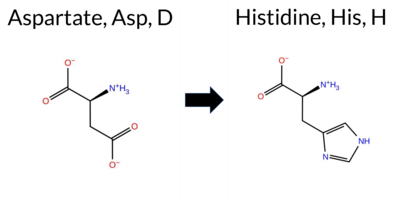 AIThe SynGAP1 missense variant D151H is listed in ClinVar with an “Uncertain” status and is present in gnomAD (variant ID 6‑33432748‑G‑C). Prediction tools that agree on a benign effect include REVEL and FATHMM, whereas the remaining tools (PROVEAN, polyPhen‑2 HumDiv, polyPhen‑2 HumVar, SIFT, ESM1b, AlphaMissense‑Default, AlphaMissense‑Optimized) all predict a pathogenic outcome. High‑accuracy assessments further support a deleterious impact: AlphaMissense‑Optimized classifies the variant as pathogenic, and the SGM Consensus (majority vote from AlphaMissense‑Default, ESM1b, FATHMM, and PROVEAN) reports it as “Likely Pathogenic.” No Foldetta stability result is available for this variant. Overall, the majority of computational evidence indicates that D151H is most likely pathogenic, which does not contradict the current ClinVar status of uncertainty. Disclaimer: This summary was generated using AI and should be interpreted alongside expert review. | Likely Pathogenic | Uncertain | 1 | 6-33432748-G-C | 2 | 1.26e-6 | -11.747 | Likely Pathogenic | 0.994 | Likely Pathogenic | Likely Pathogenic | 0.335 | Likely Benign | -3.90 | Deleterious | 0.999 | Probably Damaging | 0.995 | Probably Damaging | 3.86 | Benign | 0.00 | Affected | 3.61 | 5 | -1 | 1 | 0.3 | 22.05 | |||||||||||||||||||||||||||
| c.453C>A | D151E 2D 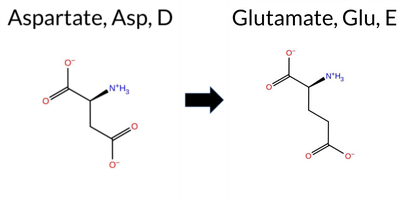 AIThe SynGAP1 D151E variant is listed in ClinVar with an “Uncertain” status and is not reported in gnomAD. Functional prediction tools that agree on a benign effect include REVEL, PROVEAN, SIFT, ESM1b, and FATHMM. Those that predict a pathogenic outcome are polyPhen‑2 HumDiv, polyPhen‑2 HumVar, and AlphaMissense‑Default. The SGM‑Consensus, which aggregates AlphaMissense‑Default, ESM1b, FATHMM, and PROVEAN, reports a “Likely Benign” classification. High‑accuracy assessments show AlphaMissense‑Optimized as “Uncertain,” SGM‑Consensus as “Likely Benign,” and Foldetta (a protein‑folding stability method combining FoldX‑MD and Rosetta) has no available result for this variant. Overall, the majority of evidence points to a benign effect, and this conclusion does not contradict the ClinVar “Uncertain” designation. Disclaimer: This summary was generated using AI and should be interpreted alongside expert review. | Likely Benign | Uncertain | 1 | -5.662 | Likely Benign | 0.886 | Likely Pathogenic | Ambiguous | 0.142 | Likely Benign | -2.02 | Neutral | 0.984 | Probably Damaging | 0.967 | Probably Damaging | 3.99 | Benign | 0.11 | Tolerated | 3.61 | 5 | 3 | 2 | 0.0 | 14.03 | ||||||||||||||||||||||||||||||
| c.455G>A | R152Q 2D  AIThe SynGAP1 missense variant R152Q is listed in ClinVar with an “Uncertain” status and is present in gnomAD (ID 6‑33432752‑G‑A). Prediction tools that agree on a benign effect include REVEL, PROVEAN, and FATHMM, whereas those that predict a pathogenic effect are polyPhen‑2 (HumDiv and HumVar), SIFT, ESM1b, AlphaMissense‑Default, and AlphaMissense‑Optimized. The SGM Consensus, derived from a majority vote of AlphaMissense‑Default, ESM1b, FATHMM, and PROVEAN, is inconclusive (two pathogenic, two benign). High‑accuracy assessments show AlphaMissense‑Optimized as pathogenic; the SGM Consensus remains unavailable, and Foldetta (combining FoldX‑MD and Rosetta outputs) has no reported result for this variant. Overall, the preponderance of evidence (seven pathogenic versus three benign predictions) indicates that the variant is most likely pathogenic, which does not contradict the current ClinVar “Uncertain” classification. Disclaimer: This summary was generated using AI and should be interpreted alongside expert review. | Uncertain | 1 | 6-33432752-G-A | 5 | 3.14e-6 | -10.336 | Likely Pathogenic | 0.989 | Likely Pathogenic | Likely Pathogenic | 0.181 | Likely Benign | -2.34 | Neutral | 0.997 | Probably Damaging | 0.968 | Probably Damaging | 3.89 | Benign | 0.00 | Affected | 3.61 | 5 | 1 | 1 | 1.0 | -28.06 | ||||||||||||||||||||||||||||
| c.458C>A | T153N 2D 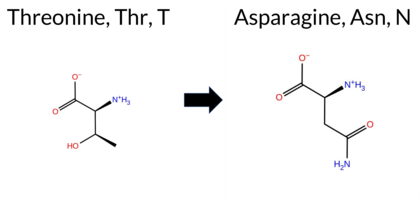 AIThe SynGAP1 missense variant T153N is listed in ClinVar (ID 984906.0) with an “Uncertain” status and is not reported in gnomAD. Functional prediction tools largely agree on a benign effect: REVEL, PROVEAN, SIFT, ESM1b, FATHMM, AlphaMissense‑Default, and AlphaMissense‑Optimized all predict benign, while the SGM‑Consensus (majority vote from AlphaMissense‑Default, ESM1b, FATHMM, and PROVEAN) also indicates a likely benign outcome. In contrast, polyPhen‑2 (HumDiv and HumVar) predict pathogenic. High‑accuracy assessments show AlphaMissense‑Optimized as benign and the SGM‑Consensus as likely benign; Foldetta results are unavailable. Overall, the majority of evidence supports a benign classification, and this is consistent with the ClinVar “Uncertain” designation rather than contradicting it. Disclaimer: This summary was generated using AI and should be interpreted alongside expert review. | Likely Benign | Conflicting | 3 | -0.739 | Likely Benign | 0.226 | Likely Benign | Likely Benign | 0.161 | Likely Benign | 0.88 | Neutral | 0.888 | Possibly Damaging | 0.537 | Possibly Damaging | 4.23 | Benign | 0.81 | Tolerated | 3.61 | 5 | 0 | 0 | -2.8 | 13.00 | ||||||||||||||||||||||||||||||
| c.467T>G | F156C 2D 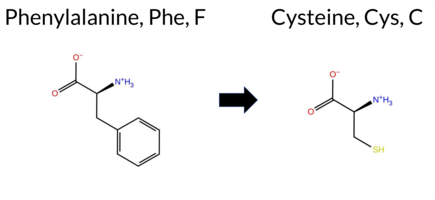 AIThe SynGAP1 missense variant F156C is listed in ClinVar with an “Uncertain” status and is not reported in gnomAD. Functional prediction tools that agree on a benign effect are REVEL and FATHMM, whereas the remaining tools—PROVEAN, polyPhen‑2 (HumDiv and HumVar), SIFT, ESM1b, AlphaMissense‑Default, AlphaMissense‑Optimized, and the SGM‑Consensus (majority vote from AlphaMissense‑Default, ESM1b, FATHMM, PROVEAN)—all predict a pathogenic or likely pathogenic outcome. High‑accuracy assessments further support a deleterious impact: AlphaMissense‑Optimized classifies the variant as pathogenic, and the SGM‑Consensus reports it as “Likely Pathogenic.” No Foldetta stability analysis is available for this variant. Overall, the majority of predictions, including the high‑accuracy tools, indicate that F156C is most likely pathogenic, which is consistent with its ClinVar “Uncertain” classification rather than contradicting it. Disclaimer: This summary was generated using AI and should be interpreted alongside expert review. | Likely Pathogenic | Uncertain | 1 | -13.658 | Likely Pathogenic | 0.988 | Likely Pathogenic | Likely Pathogenic | 0.297 | Likely Benign | -3.54 | Deleterious | 0.999 | Probably Damaging | 0.990 | Probably Damaging | 3.92 | Benign | 0.00 | Affected | -4 | -2 | -0.3 | -44.04 | ||||||||||||||||||||||||||||||||
| c.470G>A | R157H 2D  AIThe SynGAP1 missense variant R157H (ClinVar ID 2065231.0) is listed as Uncertain in ClinVar and is present in gnomAD (ID 6‑33432767‑G‑A). Prediction tools that agree on a benign effect include REVEL, PROVEAN, FATHMM, and AlphaMissense‑Optimized. Tools that predict a pathogenic effect are polyPhen‑2 (HumDiv and HumVar), SIFT, ESM1b, and AlphaMissense‑Default. High‑accuracy assessments show AlphaMissense‑Optimized classifying the variant as benign, while the SGM Consensus—derived from a majority vote of AlphaMissense‑Default, ESM1b, FATHMM, and PROVEAN—yields a tie and is therefore inconclusive. Foldetta, a protein‑folding stability method combining FoldX‑MD and Rosetta outputs, has no reported result for this variant. Overall, the balance of predictions leans toward pathogenic, but the high‑accuracy tools do not provide a definitive verdict. This assessment does not contradict the ClinVar status, which remains Uncertain. Disclaimer: This summary was generated using AI and should be interpreted alongside expert review. | Uncertain | 1 | 6-33432767-G-A | 1 | 6.20e-7 | -10.235 | Likely Pathogenic | 0.604 | Likely Pathogenic | Likely Benign | 0.254 | Likely Benign | -2.23 | Neutral | 0.999 | Probably Damaging | 0.987 | Probably Damaging | 3.80 | Benign | 0.00 | Affected | 3.74 | 4 | 2 | 0 | 1.3 | -19.05 | ||||||||||||||||||||||||||||
| c.484C>G | R162G 2D 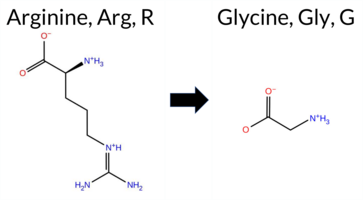 AIThe SynGAP1 missense variant R162G is listed in ClinVar (ID 2703066.0) with an uncertain significance status and is not reported in gnomAD. Functional prediction tools that agree on a benign effect include REVEL, PROVEAN, polyPhen‑2 HumVar, SIFT, ESM1b, FATHMM, and AlphaMissense‑Optimized. Tools that predict a pathogenic effect are polyPhen‑2 HumDiv and AlphaMissense‑Default. The SGM‑Consensus, which aggregates AlphaMissense‑Default, ESM1b, FATHMM, and PROVEAN, is classified as Likely Benign (three benign votes versus one pathogenic). High‑accuracy assessments show AlphaMissense‑Optimized as Benign and the SGM‑Consensus as Likely Benign; Foldetta stability analysis is unavailable. Overall, the majority of predictions support a benign impact, and this is consistent with the ClinVar uncertain status rather than contradicting it. Disclaimer: This summary was generated using AI and should be interpreted alongside expert review. | Likely Benign | Uncertain | 1 | -6.985 | Likely Benign | 0.664 | Likely Pathogenic | Likely Benign | 0.190 | Likely Benign | -0.73 | Neutral | 0.487 | Possibly Damaging | 0.272 | Benign | 4.09 | Benign | 0.78 | Tolerated | 3.74 | 4 | -2 | -3 | 4.1 | -99.14 | ||||||||||||||||||||||||||||||
| c.484C>T | R162C 2D  AIThe SynGAP1 missense variant R162C is listed in ClinVar as Pathogenic and is not reported in gnomAD. Prediction tools that agree on a benign effect include REVEL, PROVEAN, SIFT, and FATHMM, whereas tools that predict a pathogenic effect are polyPhen‑2 HumDiv, polyPhen‑2 HumVar, ESM1b, and AlphaMissense‑Default. The high‑accuracy AlphaMissense‑Optimized score is uncertain, the SGM Consensus (majority vote from AlphaMissense‑Default, ESM1b, FATHMM, and PROVEAN) is inconclusive, and Foldetta stability analysis is unavailable. Overall, the available predictions are split evenly between benign and pathogenic, with no single method providing decisive evidence. Thus, the variant’s pathogenicity remains uncertain based on computational predictions, which contradicts the ClinVar pathogenic classification. Disclaimer: This summary was generated using AI and should be interpreted alongside expert review. | Pathogenic | 2 | -8.157 | Likely Pathogenic | 0.787 | Likely Pathogenic | Ambiguous | 0.150 | Likely Benign | -2.05 | Neutral | 0.988 | Probably Damaging | 0.513 | Possibly Damaging | 4.00 | Benign | 0.11 | Tolerated | 3.74 | 4 | -4 | -3 | 7.0 | -53.05 | |||||||||||||||||||||||||||||||
| c.485G>A | R162H 2D  AIThe SynGAP1 missense variant R162H is listed in ClinVar with an uncertain significance and is present in the gnomAD database (variant ID 6‑33432782‑G‑A). Functional prediction tools cluster into two groups: benign calls are made by REVEL, PROVEAN, SIFT, FATHMM, and AlphaMissense‑Optimized, whereas pathogenic calls come from polyPhen‑2 (HumDiv and HumVar) and ESM1b; AlphaMissense‑Default remains uncertain. High‑accuracy assessments further support a benign outcome: AlphaMissense‑Optimized predicts benign, and the SGM Consensus—derived from a majority vote of AlphaMissense‑Default, ESM1b, FATHMM, and PROVEAN—also yields a benign verdict. Foldetta, a protein‑folding stability method that integrates FoldX‑MD and Rosetta outputs, did not provide a result for this variant. Overall, the preponderance of evidence points to a benign effect, which does not contradict the ClinVar uncertain classification. Disclaimer: This summary was generated using AI and should be interpreted alongside expert review. | Uncertain | 1 | 6-33432782-G-A | 2 | 1.24e-6 | -9.730 | Likely Pathogenic | 0.480 | Ambiguous | Likely Benign | 0.167 | Likely Benign | -1.13 | Neutral | 0.957 | Probably Damaging | 0.513 | Possibly Damaging | 4.03 | Benign | 0.12 | Tolerated | 3.74 | 4 | 2 | 0 | 1.3 | -19.05 | ||||||||||||||||||||||||||||
| c.48G>A | M16I 2D  AIThe SynGAP1 missense variant M16I is listed in ClinVar with an “Uncertain” status (ClinVar ID 1424213.0) and is present in gnomAD (6‑33420312‑G‑A). Prediction tools that agree on a benign effect include REVEL, PROVEAN, polyPhen‑2 HumDiv, polyPhen‑2 HumVar, ESM1b, FATHMM, and AlphaMissense‑Optimized. Tools that predict a pathogenic effect are SIFT and AlphaMissense‑Default. The SGM‑Consensus, which aggregates the majority vote from AlphaMissense‑Default, ESM1b, FATHMM, and PROVEAN, reports a “Likely Benign” classification. High‑accuracy assessments show AlphaMissense‑Optimized as benign and the SGM‑Consensus as likely benign; Foldetta results are not available. Overall, the majority of evidence points to a benign impact, and this is consistent with the ClinVar “Uncertain” designation rather than contradicting it. Disclaimer: This summary was generated using AI and should be interpreted alongside expert review. | Likely Benign | Uncertain | 1 | 6-33420312-G-A | 1 | 6.49e-7 | -2.198 | Likely Benign | 0.722 | Likely Pathogenic | Likely Benign | 0.057 | Likely Benign | -0.15 | Neutral | 0.000 | Benign | 0.000 | Benign | 4.28 | Benign | 0.00 | Affected | 4.32 | 1 | 2 | 1 | 2.6 | -18.03 | |||||||||||||||||||||||||||
| c.491G>A | R164Q 2D  AISynGAP1 missense variant R164Q is listed in ClinVar with an uncertain significance and is present in gnomAD (ID 6‑33432788‑G‑A). Functional prediction tools show mixed results: benign predictions come from REVEL, PROVEAN, polyPhen‑2 HumVar, FATHMM, and AlphaMissense‑Optimized, whereas pathogenic predictions come from polyPhen‑2 HumDiv, SIFT, ESM1b, and AlphaMissense‑Default. High‑accuracy assessments indicate that AlphaMissense‑Optimized predicts a benign effect, while the SGM Consensus (majority vote of AlphaMissense‑Default, ESM1b, FATHMM, PROVEAN) is inconclusive due to a 2‑to‑2 split; Foldetta results are not available. Overall, the balance of evidence slightly favors a benign interpretation, and this does not contradict the ClinVar uncertain status. Disclaimer: This summary was generated using AI and should be interpreted alongside expert review. | Uncertain | 1 | 6-33432788-G-A | 2 | 1.24e-6 | -11.208 | Likely Pathogenic | 0.600 | Likely Pathogenic | Likely Benign | 0.184 | Likely Benign | -1.86 | Neutral | 0.957 | Probably Damaging | 0.342 | Benign | 3.82 | Benign | 0.00 | Affected | 3.74 | 4 | 1 | 1 | 1.0 | -28.06 | ||||||||||||||||||||||||||||
| c.502C>T | H168Y 2D  AIThe SynGAP1 missense variant H168Y is listed in ClinVar (ID 956914.0) as benign and is not reported in gnomAD. Prediction tools that agree on a benign effect include REVEL, PROVEAN, polyPhen‑2 (HumDiv and HumVar), FATHMM, AlphaMissense‑Default, AlphaMissense‑Optimized, and the SGM‑Consensus (majority vote from AlphaMissense‑Default, ESM1b, FATHMM, and PROVEAN). Tools that predict a pathogenic effect are SIFT and ESM1b. High‑accuracy assessments show AlphaMissense‑Optimized as benign and the SGM‑Consensus as likely benign; the Foldetta protein‑folding stability analysis is unavailable. Overall, the majority of evidence points to a benign impact, and this conclusion is consistent with the ClinVar benign classification. Disclaimer: This summary was generated using AI and should be interpreted alongside expert review. | Likely Benign | Benign | 1 | -8.914 | Likely Pathogenic | 0.264 | Likely Benign | Likely Benign | 0.065 | Likely Benign | -1.53 | Neutral | 0.192 | Benign | 0.062 | Benign | 4.18 | Benign | 0.01 | Affected | 4.32 | 3 | 0 | 2 | 1.9 | 26.03 | ||||||||||||||||||||||||||||||
| c.505G>A | D169N 2D 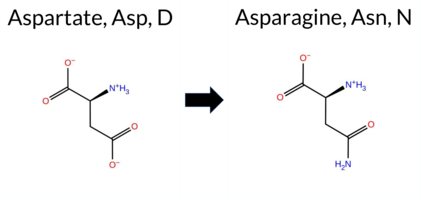 AIThe SynGAP1 missense variant D169N is listed in ClinVar with an uncertain significance and is not reported in gnomAD. Functional prediction tools show a split: six methods (REVEL, PROVEAN, polyPhen‑2 HumDiv, polyPhen‑2 HumVar, FATHMM, AlphaMissense‑Optimized) predict a benign effect, while three (SIFT, ESM1b, AlphaMissense‑Default) predict pathogenicity. High‑accuracy assessments are mixed: AlphaMissense‑Optimized indicates benign, whereas the SGM Consensus—derived from a majority vote of AlphaMissense‑Default, ESM1b, FATHMM, and PROVEAN—yields a tie and is therefore inconclusive. No Foldetta stability data are available. Overall, the balance of evidence leans toward a benign impact, which does not contradict the ClinVar uncertain status. Disclaimer: This summary was generated using AI and should be interpreted alongside expert review. | Uncertain | 1 | -10.713 | Likely Pathogenic | 0.761 | Likely Pathogenic | Likely Benign | 0.110 | Likely Benign | -2.04 | Neutral | 0.079 | Benign | 0.052 | Benign | 4.07 | Benign | 0.01 | Affected | 3.74 | 4 | 2 | 1 | 0.0 | -0.98 | |||||||||||||||||||||||||||||||
| c.508C>T | R170W 2D  AIThe SynGAP1 missense variant R170W is listed in ClinVar (ID 1310195.0) with an “Uncertain” status and is not reported in gnomAD. Prediction tools that agree on a benign effect are REVEL and FATHMM, whereas the remaining tools—PROVEAN, polyPhen‑2 (HumDiv and HumVar), SIFT, ESM1b, AlphaMissense‑Default, AlphaMissense‑Optimized, and the SGM‑Consensus (majority vote of AlphaMissense‑Default, ESM1b, FATHMM, PROVEAN)—all predict a pathogenic or likely pathogenic outcome. High‑accuracy assessments further support a deleterious impact: AlphaMissense‑Optimized classifies the variant as pathogenic, and the SGM‑Consensus indicates it is likely pathogenic; Foldetta results are unavailable. Overall, the preponderance of evidence points to a pathogenic effect, which is consistent with the ClinVar “Uncertain” classification rather than contradicting it. Disclaimer: This summary was generated using AI and should be interpreted alongside expert review. | Likely Pathogenic | Uncertain | 2 | -11.660 | Likely Pathogenic | 0.978 | Likely Pathogenic | Likely Pathogenic | 0.241 | Likely Benign | -4.28 | Deleterious | 0.999 | Probably Damaging | 0.849 | Possibly Damaging | 3.84 | Benign | 0.00 | Affected | 3.74 | 4 | 2 | -3 | 3.6 | 30.03 | ||||||||||||||||||||||||||||||
| c.509G>A | R170Q 2D  AISynGAP1 missense variant R170Q is listed in ClinVar as Pathogenic and is not reported in gnomAD. Computational predictors show a split: benign calls come from REVEL, PROVEAN, polyPhen‑2 HumVar, and FATHMM, while pathogenic calls come from polyPhen‑2 HumDiv, SIFT, ESM1b, and AlphaMissense‑Default. The high‑accuracy AlphaMissense‑Optimized score is Uncertain, and the SGM Consensus (majority vote of AlphaMissense‑Default, ESM1b, FATHMM, PROVEAN) is inconclusive; Foldetta stability analysis is unavailable. Thus, no single method or high‑accuracy consensus strongly supports pathogenicity. The variant is most likely benign according to the current computational evidence, which contradicts the ClinVar pathogenic designation. Disclaimer: This summary was generated using AI and should be interpreted alongside expert review. | Pathogenic/Likely path. | 6 | -9.021 | Likely Pathogenic | 0.798 | Likely Pathogenic | Ambiguous | 0.221 | Likely Benign | -2.31 | Neutral | 0.947 | Possibly Damaging | 0.342 | Benign | 3.91 | Benign | 0.00 | Affected | 3.74 | 4 | 1 | 1 | 1.0 | -28.06 | 10.1016/j.ajhg.2020.11.011 | ||||||||||||||||||||||||||||||
| c.50C>T | S17F 2D  AIThe SynGAP1 missense variant S17F is listed in ClinVar with an “Uncertain” status (ClinVar ID 3451958.0) and is present in gnomAD (ID 6‑33420314‑C‑T). Prediction tools that agree on a benign effect include REVEL, PROVEAN, polyPhen‑2 HumVar, ESM1b, FATHMM, and AlphaMissense‑Optimized. Tools that predict a pathogenic effect are polyPhen‑2 HumDiv, SIFT, and AlphaMissense‑Default. The SGM‑Consensus, derived from a majority vote of AlphaMissense‑Default, ESM1b, FATHMM, and PROVEAN, reports a “Likely Benign” classification. High‑accuracy assessments show AlphaMissense‑Optimized as benign and the SGM‑Consensus also as likely benign; Foldetta results are not available. Overall, the majority of evidence points to a benign impact, and this is consistent with the ClinVar “Uncertain” designation rather than contradicting it. Disclaimer: This summary was generated using AI and should be interpreted alongside expert review. | Likely Benign | Uncertain | 1 | 6-33420314-C-T | 10 | 6.49e-6 | -3.888 | Likely Benign | 0.637 | Likely Pathogenic | Likely Benign | 0.048 | Likely Benign | -0.99 | Neutral | 0.486 | Possibly Damaging | 0.032 | Benign | 3.99 | Benign | 0.00 | Affected | 4.32 | 1 | -2 | -3 | 3.6 | 60.10 | |||||||||||||||||||||||||||
| c.514C>T | R172W 2D  AIThe SynGAP1 missense variant R172W is listed in ClinVar (ID 996892.0) with an “Uncertain” status and is present in gnomAD (variant ID 6‑33435156‑C‑T). Prediction tools that agree on a benign effect include REVEL and FATHMM. Those that predict a pathogenic effect comprise PROVEAN, polyPhen‑2 (HumDiv and HumVar), SIFT, ESM1b, and AlphaMissense‑Default; the SGM‑Consensus (majority vote of AlphaMissense‑Default, ESM1b, FATHMM, PROVEAN) is “Likely Pathogenic.” AlphaMissense‑Optimized is uncertain, and Foldetta results are unavailable. High‑accuracy assessments therefore indicate a likely pathogenic outcome (SGM‑Consensus) with no definitive stabilizing‑folding evidence. Overall, the majority of computational predictions support a pathogenic classification, which does not contradict the ClinVar “Uncertain” designation. Disclaimer: This summary was generated using AI and should be interpreted alongside expert review. | Likely Pathogenic | Uncertain | 2 | 6-33435156-C-T | 9 | 5.58e-6 | -10.258 | Likely Pathogenic | 0.878 | Likely Pathogenic | Ambiguous | 0.228 | Likely Benign | -3.61 | Deleterious | 0.997 | Probably Damaging | 0.803 | Possibly Damaging | 3.95 | Benign | 0.00 | Affected | 3.61 | 5 | 2 | -3 | 3.6 | 30.03 | |||||||||||||||||||||||||||
| c.515G>A | R172Q 2D  AISynGAP1 missense variant R172Q is listed in ClinVar with an uncertain significance and is present in gnomAD (ID 6‑33435157‑G‑A). Functional prediction tools that agree on benign impact include REVEL, PROVEAN, polyPhen‑2 HumVar, FATHMM, and AlphaMissense‑Optimized. Those that predict pathogenicity are polyPhen‑2 HumDiv and SIFT, while ESM1b and AlphaMissense‑Default are inconclusive. High‑accuracy assessments show AlphaMissense‑Optimized as benign, and the SGM Consensus (majority vote from AlphaMissense‑Default, ESM1b, FATHMM, PROVEAN) also returns benign. Foldetta, a protein‑folding stability method, has no available result for this variant. Overall, the majority of evidence points to a benign effect, which does not contradict the ClinVar uncertain status. Disclaimer: This summary was generated using AI and should be interpreted alongside expert review. | Uncertain | 1 | 6-33435157-G-A | 3 | 1.86e-6 | -7.245 | In-Between | 0.465 | Ambiguous | Likely Benign | 0.135 | Likely Benign | -1.72 | Neutral | 0.804 | Possibly Damaging | 0.091 | Benign | 4.04 | Benign | 0.04 | Affected | 3.61 | 5 | 1 | 1 | 1.0 | -28.06 | ||||||||||||||||||||||||||||
| c.526A>C | S176R 2D  AIThe SynGAP1 missense variant S176R is listed in ClinVar with an uncertain significance and is not reported in gnomAD. Functional prediction tools that agree on a benign effect include REVEL, PROVEAN, polyPhen‑2 HumVar, SIFT, ESM1b, and FATHMM, whereas polyPhen‑2 HumDiv, AlphaMissense‑Default, and AlphaMissense‑Optimized predict a pathogenic outcome. The SGM‑Consensus, derived from a majority vote of AlphaMissense‑Default, ESM1b, FATHMM, and PROVEAN, reports a likely benign classification. High‑accuracy assessments show AlphaMissense‑Optimized as pathogenic, while the SGM‑Consensus remains likely benign; Foldetta results are unavailable. Overall, the balance of evidence favors a benign interpretation, and this assessment does not conflict with the ClinVar uncertain status. Disclaimer: This summary was generated using AI and should be interpreted alongside expert review. | Likely Benign | Uncertain | 1 | -6.492 | Likely Benign | 0.987 | Likely Pathogenic | Likely Pathogenic | 0.247 | Likely Benign | 0.94 | Neutral | 0.718 | Possibly Damaging | 0.168 | Benign | 4.16 | Benign | 0.87 | Tolerated | 0 | -1 | -3.7 | 69.11 | ||||||||||||||||||||||||||||||||
| c.526A>G | S176G 2D  AIThe SynGAP1 missense variant S176G is listed in ClinVar with an uncertain significance and is present in gnomAD (ID 6‑33435168‑A‑G). Consensus among most in silico predictors is benign: REVEL, PROVEAN, polyPhen‑2 (HumDiv and HumVar), SIFT, FATHMM, and AlphaMissense‑Optimized all report a benign effect. No tool predicts pathogenicity. Two predictors are inconclusive: ESM1b and AlphaMissense‑Default, which are grouped under uncertain. High‑accuracy assessments further support a benign outcome: AlphaMissense‑Optimized is benign, while the SGM Consensus (majority vote of AlphaMissense‑Default, ESM1b, FATHMM, PROVEAN) remains uncertain, and Foldetta stability analysis is unavailable. Overall, the computational evidence overwhelmingly favors a benign impact, which does not contradict the ClinVar uncertain classification. Disclaimer: This summary was generated using AI and should be interpreted alongside expert review. | Uncertain | 1 | 6-33435168-A-G | 1 | 6.20e-7 | -7.541 | In-Between | 0.360 | Ambiguous | Likely Benign | 0.066 | Likely Benign | -1.08 | Neutral | 0.131 | Benign | 0.039 | Benign | 4.08 | Benign | 0.22 | Tolerated | 3.54 | 6 | 0 | 1 | 0.4 | -30.03 | ||||||||||||||||||||||||||||
| c.53A>G | Y18C 2D 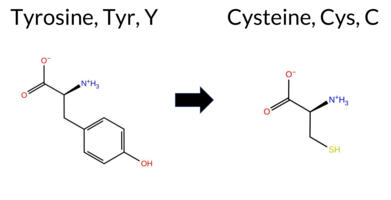 AIThe SynGAP1 missense variant Y18C is listed in ClinVar with an uncertain significance (ClinVar ID 1967233.0) and is present in gnomAD (ID 6‑33420317‑A‑G). Functional prediction tools largely agree on a benign effect: REVEL, PROVEAN, polyPhen‑2 HumVar, ESM1b, FATHMM, AlphaMissense‑Default, and AlphaMissense‑Optimized all predict benign. In contrast, polyPhen‑2 HumDiv and SIFT predict pathogenic. The SGM‑Consensus, derived from a majority vote of AlphaMissense‑Default, ESM1b, FATHMM, and PROVEAN, reports a likely benign outcome. High‑accuracy assessments confirm this: AlphaMissense‑Optimized is benign and the SGM‑Consensus is likely benign; Foldetta results are unavailable. Overall, the preponderance of evidence points to a benign impact for Y18C, which is consistent with its ClinVar uncertain status rather than contradicting it. Disclaimer: This summary was generated using AI and should be interpreted alongside expert review. | Likely Benign | Uncertain | 1 | 6-33420317-A-G | 44 | 2.88e-5 | -2.658 | Likely Benign | 0.251 | Likely Benign | Likely Benign | 0.102 | Likely Benign | -0.56 | Neutral | 0.872 | Possibly Damaging | 0.206 | Benign | 4.04 | Benign | 0.00 | Affected | 4.32 | 1 | 0 | -2 | 3.8 | -60.04 | |||||||||||||||||||||||||||
| c.558G>C | L186F 2D  AIThe SynGAP1 missense variant L186F is listed in ClinVar with an “Uncertain” status and is not reported in gnomAD. Prediction tools that agree on a benign effect include REVEL, polyPhen‑2 (HumDiv and HumVar), and FATHMM. In contrast, tools that predict a pathogenic effect are PROVEAN, SIFT, ESM1b, AlphaMissense‑Default, and AlphaMissense‑Optimized. The SGM‑Consensus, which aggregates AlphaMissense‑Default, ESM1b, FATHMM, and PROVEAN, reports the variant as “Likely Pathogenic.” High‑accuracy assessments further support a deleterious impact: AlphaMissense‑Optimized predicts pathogenicity, and the SGM‑Consensus (majority vote) also indicates likely pathogenic. Foldetta, a protein‑folding stability method combining FoldX‑MD and Rosetta outputs, has no available result for this variant. Overall, the majority of computational evidence points to a pathogenic effect, which does not contradict the ClinVar “Uncertain” classification. Disclaimer: This summary was generated using AI and should be interpreted alongside expert review. | Likely Pathogenic | Uncertain | 1 | -11.861 | Likely Pathogenic | 0.993 | Likely Pathogenic | Likely Pathogenic | 0.132 | Likely Benign | -3.03 | Deleterious | 0.009 | Benign | 0.012 | Benign | 3.50 | Benign | 0.00 | Affected | 2 | 0 | -1.0 | 34.02 | ||||||||||||||||||||||||||||||||
| c.583G>C | A195P 2D  AIThe SynGAP1 missense variant A195P is listed in ClinVar as Pathogenic (ClinVar ID 375527.0) and is not reported in gnomAD. Prediction tools that indicate a benign effect are REVEL and FATHMM, whereas the remaining tools—PROVEAN, polyPhen‑2 (HumDiv and HumVar), SIFT, ESM1b, AlphaMissense‑Default, AlphaMissense‑Optimized, and the SGM‑Consensus—predict a pathogenic outcome. The SGM‑Consensus, derived from a majority vote of AlphaMissense‑Default, ESM1b, FATHMM, and PROVEAN, is “Likely Pathogenic.” High‑accuracy assessments show AlphaMissense‑Optimized as pathogenic and the SGM‑Consensus as likely pathogenic; Foldetta results are unavailable. Overall, the preponderance of evidence supports a pathogenic classification, which aligns with the ClinVar status and does not contradict it. Disclaimer: This summary was generated using AI and should be interpreted alongside expert review. | Likely Pathogenic | Likely Pathogenic | 1 | -9.715 | Likely Pathogenic | 0.978 | Likely Pathogenic | Likely Pathogenic | 0.152 | Likely Benign | -3.03 | Deleterious | 0.997 | Probably Damaging | 0.916 | Probably Damaging | 4.00 | Benign | 0.04 | Affected | 3.54 | 6 | 1 | -1 | -3.4 | 26.04 | ||||||||||||||||||||||||||||||
| c.59C>G | P20R 2D  AIThe SynGAP1 missense variant P20R is listed in ClinVar (ID 566521.0) with an “Uncertain” status and is not reported in gnomAD. Functional prediction tools that agree on a benign effect include REVEL, PROVEAN, ESM1b, FATHMM, AlphaMissense‑Optimized, and the SGM‑Consensus (majority vote from AlphaMissense‑Default, ESM1b, FATHMM, PROVEAN). Tools that predict a pathogenic outcome are polyPhen‑2 (HumDiv and HumVar) and SIFT. AlphaMissense‑Default remains uncertain. High‑accuracy assessments show AlphaMissense‑Optimized as benign and the SGM‑Consensus as likely benign; Foldetta results are unavailable. Overall, the majority of evidence points to a benign impact, and this conclusion does not contradict the current ClinVar “Uncertain” classification. Disclaimer: This summary was generated using AI and should be interpreted alongside expert review. | Likely Benign | Uncertain | 1 | -3.548 | Likely Benign | 0.434 | Ambiguous | Likely Benign | 0.146 | Likely Benign | -0.15 | Neutral | 0.972 | Probably Damaging | 0.804 | Possibly Damaging | 4.33 | Benign | 0.00 | Affected | 4.32 | 1 | 0 | -2 | -2.9 | 59.07 | ||||||||||||||||||||||||||||||
| c.59C>T | P20L 2D  AIThe SynGAP1 missense variant P20L (ClinVar ID 1185912.0) is listed as “Uncertain” in ClinVar and is not reported in gnomAD. Prediction tools that agree on a benign effect include REVEL, PROVEAN, ESM1b, FATHMM, AlphaMissense‑Optimized, and the SGM‑Consensus (majority vote from AlphaMissense‑Default, ESM1b, FATHMM, PROVEAN). Tools that predict a pathogenic effect are polyPhen‑2 HumDiv, polyPhen‑2 HumVar, and SIFT; AlphaMissense‑Default remains uncertain. High‑accuracy assessments show AlphaMissense‑Optimized as benign, the SGM‑Consensus as likely benign, and Foldetta results are unavailable. Overall, the majority of evidence points to a benign impact, and this conclusion does not contradict the ClinVar status, which remains uncertain. Disclaimer: This summary was generated using AI and should be interpreted alongside expert review. | Likely Benign | Uncertain | 3 | -3.289 | Likely Benign | 0.464 | Ambiguous | Likely Benign | 0.100 | Likely Benign | -0.44 | Neutral | 0.909 | Possibly Damaging | 0.713 | Possibly Damaging | 4.27 | Benign | 0.00 | Affected | 4.32 | 1 | -3 | -3 | 5.4 | 16.04 | ||||||||||||||||||||||||||||||
| c.5G>A | S2N 2D  AIThe SynGAP1 missense variant S2N is listed in ClinVar with an “Uncertain” status and is present in gnomAD (ID 6‑33420269‑G‑A). Prediction tools that agree on a benign effect include REVEL, PROVEAN, polyPhen‑2 (HumDiv and HumVar), ESM1b, FATHMM, AlphaMissense‑Default, and AlphaMissense‑Optimized. Only SIFT predicts a pathogenic outcome. The SGM‑Consensus, derived from a majority vote of AlphaMissense‑Default, ESM1b, FATHMM, and PROVEAN, reports the variant as “Likely Benign.” High‑accuracy assessments show AlphaMissense‑Optimized as benign and the SGM‑Consensus as likely benign; Foldetta results are not available. Overall, the preponderance of evidence points to a benign effect, and this conclusion does not contradict the ClinVar “Uncertain” classification. Disclaimer: This summary was generated using AI and should be interpreted alongside expert review. | Likely Benign | Uncertain | 2 | 6-33420269-G-A | 3 | 1.96e-6 | -4.104 | Likely Benign | 0.207 | Likely Benign | Likely Benign | 0.092 | Likely Benign | -0.36 | Neutral | 0.000 | Benign | 0.000 | Benign | 4.06 | Benign | 0.00 | Affected | 4.32 | 1 | 1 | 1 | -2.7 | 27.03 | |||||||||||||||||||||||||||
| c.662A>G | E221G 2D 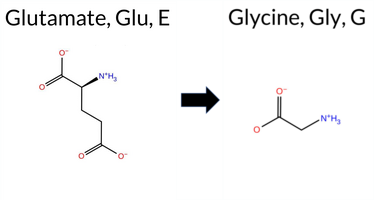 3DClick to see structure in 3D Viewer AIThe SynGAP1 E221G missense variant is listed in ClinVar with an “Uncertain” status and is not reported in gnomAD. Prediction tools that agree on a benign effect include polyPhen‑2 HumVar and FATHMM, while the majority of other in silico predictors (REVEL, PROVEAN, polyPhen‑2 HumDiv, SIFT, ESM1b, AlphaMissense‑Default, AlphaMissense‑Optimized, and the SGM‑Consensus) indicate a pathogenic impact; FoldX, Rosetta, Foldetta, and premPS are inconclusive. High‑accuracy assessments show AlphaMissense‑Optimized as pathogenic, the SGM‑Consensus (majority vote of AlphaMissense‑Default, ESM1b, FATHMM, PROVEAN) as pathogenic, and Foldetta as uncertain. Based on the collective evidence, the variant is most likely pathogenic, which does not contradict the ClinVar “Uncertain” classification. Disclaimer: This summary was generated using AI and should be interpreted alongside expert review. | Likely Pathogenic | PH | Uncertain | 1 | -12.221 | Likely Pathogenic | 0.992 | Likely Pathogenic | Likely Pathogenic | 0.863 | Likely Pathogenic | 1.40 | Ambiguous | 0.1 | 1.74 | Ambiguous | 1.57 | Ambiguous | 0.71 | Ambiguous | -5.56 | Deleterious | 0.596 | Possibly Damaging | 0.201 | Benign | 5.79 | Benign | 0.00 | Affected | 0 | -2 | 3.1 | -72.06 | ||||||||||||||||||||||
| c.68A>G | D23G 2D 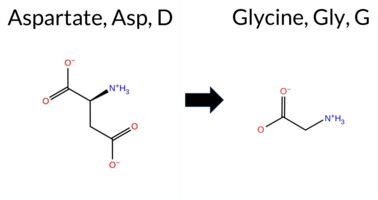 AIThe SynGAP1 missense variant D23G is listed in ClinVar (ID 3644551.0) with an “Uncertain” status and is not reported in gnomAD. Prediction tools that agree on a benign effect include REVEL, PROVEAN, ESM1b, FATHMM, and AlphaMissense‑Optimized. Tools that predict a pathogenic effect are polyPhen‑2 HumDiv, polyPhen‑2 HumVar, SIFT, and AlphaMissense‑Default. The SGM‑Consensus, derived from a majority vote of AlphaMissense‑Default, ESM1b, FATHMM, and PROVEAN, reports the variant as “Likely Benign.” High‑accuracy assessments show AlphaMissense‑Optimized as benign and the SGM‑Consensus as likely benign; the Foldetta protein‑folding stability analysis is unavailable for this variant. Overall, the majority of computational evidence points to a benign impact, which does not contradict the ClinVar “Uncertain” classification but leans toward a benign interpretation. Disclaimer: This summary was generated using AI and should be interpreted alongside expert review. | Likely Benign | Uncertain | 1 | -2.622 | Likely Benign | 0.684 | Likely Pathogenic | Likely Benign | 0.100 | Likely Benign | -2.45 | Neutral | 0.805 | Possibly Damaging | 0.539 | Possibly Damaging | 3.50 | Benign | 0.00 | Affected | 1 | -1 | 3.1 | -58.04 | ||||||||||||||||||||||||||||||||
| c.70G>A | V24I 2D 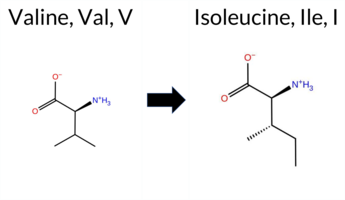 AIThe SynGAP1 missense variant V24I is listed in ClinVar with an “Uncertain” status and is present in gnomAD (variant ID 6-33423479-G-A). Prediction tools that agree on a benign effect include REVEL, PROVEAN, polyPhen‑2 (HumDiv and HumVar), ESM1b, FATHMM, AlphaMissense‑Default, AlphaMissense‑Optimized, and the SGM‑Consensus (majority vote from AlphaMissense‑Default, ESM1b, FATHMM, and PROVEAN). Only SIFT predicts a pathogenic outcome. High‑accuracy assessments show AlphaMissense‑Optimized as benign and the SGM‑Consensus as likely benign; Foldetta results are not available. Taken together, the overwhelming majority of computational evidence supports a benign impact for V24I, and this conclusion does not contradict the ClinVar designation, which remains uncertain. Disclaimer: This summary was generated using AI and should be interpreted alongside expert review. | Likely Benign | Uncertain | 1 | 6-33423479-G-A | 9 | 5.58e-6 | -3.701 | Likely Benign | 0.137 | Likely Benign | Likely Benign | 0.069 | Likely Benign | -0.25 | Neutral | 0.043 | Benign | 0.031 | Benign | 3.96 | Benign | 0.00 | Affected | 4.32 | 1 | 3 | 4 | 0.3 | 14.03 | |||||||||||||||||||||||||||
| c.718G>A | D240N 2D  AIThe SynGAP1 missense variant D240N is listed in ClinVar with an uncertain significance and is not reported in gnomAD. Benign predictions are provided by FoldX, Rosetta, Foldetta, premPS, FATHMM, and AlphaMissense‑Optimized, whereas pathogenic predictions come from REVEL, PROVEAN, polyPhen‑2 (HumDiv and HumVar), SIFT, ESM1b, AlphaMissense‑Default, and the SGM‑Consensus. High‑accuracy methods give a split: AlphaMissense‑Optimized predicts benign, SGM‑Consensus predicts pathogenic, and Foldetta predicts benign. Overall, the majority of tools favor a benign effect, and this consensus does not contradict the ClinVar uncertain status. Thus, the variant is most likely benign based on current computational predictions. Disclaimer: This summary was generated using AI and should be interpreted alongside expert review. | Likely Pathogenic | PH | Uncertain | 1 | -12.942 | Likely Pathogenic | 0.755 | Likely Pathogenic | Likely Benign | 0.701 | Likely Pathogenic | 0.22 | Likely Benign | 0.9 | 0.47 | Likely Benign | 0.35 | Likely Benign | 0.37 | Likely Benign | -4.37 | Deleterious | 0.993 | Probably Damaging | 0.984 | Probably Damaging | 5.88 | Benign | 0.01 | Affected | 2 | 1 | 0.0 | -0.98 | ||||||||||||||||||||||
| c.719A>G | D240G 2D  AIThe SynGAP1 missense variant D240G is listed in ClinVar with an uncertain significance and is not reported in gnomAD. Benign predictions are provided by premPS and FATHMM, whereas pathogenic predictions are made by REVEL, Rosetta, PROVEAN, polyPhen‑2 HumDiv, polyPhen‑2 HumVar, SIFT, ESM1b, AlphaMissense‑Default, the SGM Consensus (majority vote of AlphaMissense‑Default, ESM1b, FATHMM, PROVEAN), and Foldetta. FoldX‑MD is inconclusive, and AlphaMissense‑Optimized is uncertain. High‑accuracy methods show that AlphaMissense‑Optimized is inconclusive, SGM Consensus predicts pathogenic, and Foldetta predicts pathogenic. Overall, the majority of evidence points to a pathogenic effect, which is consistent with the ClinVar uncertain status and does not contradict it. Disclaimer: This summary was generated using AI and should be interpreted alongside expert review. | Likely Pathogenic | PH | Uncertain | 1 | -12.825 | Likely Pathogenic | 0.951 | Likely Pathogenic | Ambiguous | 0.912 | Likely Pathogenic | 1.85 | Ambiguous | 0.1 | 2.72 | Destabilizing | 2.29 | Destabilizing | 0.24 | Likely Benign | -6.19 | Deleterious | 0.993 | Probably Damaging | 0.984 | Probably Damaging | 5.79 | Benign | 0.01 | Affected | 1 | -1 | 3.1 | -58.04 | ||||||||||||||||||||||
| c.73C>T | R25W 2D  AIThe SynGAP1 missense variant R25W is listed in ClinVar with an “Uncertain” status (ClinVar ID 2993054.0) and is present in gnomAD (ID 6‑33423482‑C‑T). Prediction tools that agree on a benign effect include REVEL, PROVEAN, ESM1b, FATHMM, AlphaMissense‑Optimized, and the SGM‑Consensus (majority vote from AlphaMissense‑Default, ESM1b, FATHMM, PROVEAN). Tools that predict a pathogenic effect are polyPhen‑2 HumDiv, polyPhen‑2 HumVar, and SIFT; AlphaMissense‑Default remains uncertain. High‑accuracy assessments show AlphaMissense‑Optimized as benign and the SGM‑Consensus as likely benign, while Foldetta results are unavailable. Overall, the majority of evidence points to a benign impact, and this is not in conflict with the ClinVar “Uncertain” classification. Disclaimer: This summary was generated using AI and should be interpreted alongside expert review. | Likely Benign | Uncertain | 2 | 6-33423482-C-T | 6 | 3.72e-6 | -5.133 | Likely Benign | 0.549 | Ambiguous | Likely Benign | 0.158 | Likely Benign | -1.60 | Neutral | 0.994 | Probably Damaging | 0.919 | Probably Damaging | 3.92 | Benign | 0.00 | Affected | 4.32 | 1 | -3 | 2 | 3.6 | 30.03 | |||||||||||||||||||||||||||
| c.74G>A | R25Q 2D  AIThe SynGAP1 missense variant R25Q is listed in ClinVar with an “Uncertain” status and is present in gnomAD (ID 6‑33423483‑G‑A). Prediction tools that agree on a benign effect include REVEL, PROVEAN, ESM1b, FATHMM, AlphaMissense‑Default, AlphaMissense‑Optimized, and the SGM‑Consensus (majority vote from AlphaMissense‑Default, ESM1b, FATHMM, and PROVEAN). Tools that predict a pathogenic effect are polyPhen‑2 HumDiv, polyPhen‑2 HumVar, and SIFT. High‑accuracy assessments show AlphaMissense‑Optimized as benign and the SGM‑Consensus as likely benign; Foldetta results are unavailable. Overall, the majority of evidence points to a benign impact, and this conclusion does not contradict the ClinVar “Uncertain” classification. Disclaimer: This summary was generated using AI and should be interpreted alongside expert review. | Likely Benign | Uncertain | 1 | 6-33423483-G-A | 15 | 9.29e-6 | -4.126 | Likely Benign | 0.212 | Likely Benign | Likely Benign | 0.038 | Likely Benign | -0.70 | Neutral | 0.829 | Possibly Damaging | 0.614 | Possibly Damaging | 4.01 | Benign | 0.00 | Affected | 4.32 | 1 | 1 | 1 | 1.0 | -28.06 | |||||||||||||||||||||||||||
| c.767A>G | N256S 2D  3DClick to see structure in 3D Viewer AISynGAP1 missense variant N256S is listed in ClinVar as Pathogenic (ClinVar ID 2584352.0) and is not reported in gnomAD. Functional prediction tools show a split: benign calls come from FoldX, Rosetta, Foldetta, premPS, and FATHMM, while pathogenic calls come from SGM‑Consensus, REVEL, PROVEAN, polyPhen‑2 (HumDiv and HumVar), SIFT, ESM1b, and AlphaMissense‑Default. The high‑accuracy subset gives AlphaMissense‑Optimized as Uncertain, SGM‑Consensus (majority vote of AlphaMissense‑Default, ESM1b, FATHMM, PROVEAN) as Pathogenic, and Foldetta (combining FoldX‑MD and Rosetta outputs) as Benign. Overall, the majority of predictions support a pathogenic effect, aligning with the ClinVar classification. Therefore, the variant is most likely pathogenic, and this assessment does not contradict the ClinVar status. Disclaimer: This summary was generated using AI and should be interpreted alongside expert review. | Likely Pathogenic | C2 | Likely Pathogenic | 1 | -10.640 | Likely Pathogenic | 0.950 | Likely Pathogenic | Ambiguous | 0.707 | Likely Pathogenic | 0.31 | Likely Benign | 0.2 | 0.36 | Likely Benign | 0.34 | Likely Benign | 0.48 | Likely Benign | -4.33 | Deleterious | 0.997 | Probably Damaging | 0.970 | Probably Damaging | 5.87 | Benign | 0.02 | Affected | 3.39 | 15 | 1 | 1 | 2.7 | -27.03 | ||||||||||||||||||||
| c.76G>A | G26R 2D  AIThe SynGAP1 missense variant G26R is listed in ClinVar as a benign alteration (ClinVar ID 1521495.0) and is present in the gnomAD database (gnomAD ID 6‑33423485‑G‑A). Prediction tools that agree on a benign effect include REVEL, PROVEAN, ESM1b, FATHMM, and AlphaMissense‑Optimized. Tools that predict a pathogenic outcome are polyPhen‑2 HumDiv, polyPhen‑2 HumVar, SIFT, and AlphaMissense‑Default. The SGM‑Consensus, which aggregates the majority vote from AlphaMissense‑Default, ESM1b, FATHMM, and PROVEAN, reports a “Likely Benign” classification. High‑accuracy assessments show AlphaMissense‑Optimized as benign and the SGM‑Consensus as likely benign; the Foldetta protein‑folding stability analysis is unavailable for this variant. Overall, the majority of computational evidence supports a benign impact, aligning with the ClinVar designation and indicating no contradiction. Disclaimer: This summary was generated using AI and should be interpreted alongside expert review. | Likely Benign | Benign | 1 | 6-33423485-G-A | 3 | 1.86e-6 | -2.946 | Likely Benign | 0.678 | Likely Pathogenic | Likely Benign | 0.189 | Likely Benign | -2.22 | Neutral | 0.994 | Probably Damaging | 0.990 | Probably Damaging | 3.87 | Benign | 0.00 | Affected | 4.32 | 1 | -3 | -2 | -4.1 | 99.14 | |||||||||||||||||||||||||||
| c.772C>T | R258C 2D  3DClick to see structure in 3D Viewer AIThe SynGAP1 R258C missense variant is listed in ClinVar with an “Uncertain” status and is present in gnomAD (variant ID 6‑33437677‑C‑T). Prediction tools that agree on a benign effect include only FATHMM. All other evaluated predictors—REVEL, PROVEAN, polyPhen‑2 (HumDiv and HumVar), SIFT, ESM1b, AlphaMissense‑Default, and the SGM‑Consensus (majority vote of AlphaMissense‑Default, ESM1b, FATHMM, PROVEAN)—indicate a pathogenic or likely pathogenic impact. High‑accuracy assessments show AlphaMissense‑Optimized as uncertain, the SGM‑Consensus as likely pathogenic, and Foldetta (combining FoldX‑MD and Rosetta outputs) as uncertain. Based on the preponderance of pathogenic predictions, the variant is most likely pathogenic, which does not contradict its current ClinVar “Uncertain” classification. Disclaimer: This summary was generated using AI and should be interpreted alongside expert review. | Likely Pathogenic | C2 | Uncertain | 1 | 6-33437677-C-T | 1 | 6.20e-7 | -10.285 | Likely Pathogenic | 0.790 | Likely Pathogenic | Ambiguous | 0.771 | Likely Pathogenic | 1.17 | Ambiguous | 0.4 | 1.76 | Ambiguous | 1.47 | Ambiguous | 0.87 | Ambiguous | -6.79 | Deleterious | 1.000 | Probably Damaging | 0.993 | Probably Damaging | 5.77 | Benign | 0.00 | Affected | 3.39 | 15 | -3 | -4 | 7.0 | -53.05 | |||||||||||||||||
| c.791T>C | L264P 2D  3DClick to see structure in 3D Viewer AIThe SynGAP1 missense variant L264P is listed in ClinVar with an “Uncertain” status and is not reported in gnomAD. Prediction tools that assess pathogenicity all converge on a deleterious effect: REVEL, FoldX, Rosetta, Foldetta, premPS, PROVEAN, polyPhen‑2 (HumDiv and HumVar), SIFT, ESM1b, FATHMM, AlphaMissense‑Default, and AlphaMissense‑Optimized all predict pathogenicity. No tool in the dataset reports a benign outcome. High‑accuracy methods reinforce this view: AlphaMissense‑Optimized is pathogenic; the SGM Consensus (majority vote of AlphaMissense‑Default, ESM1b, FATHMM, PROVEAN) is “Likely Pathogenic”; and Foldetta, which integrates FoldX‑MD and Rosetta stability calculations, is pathogenic. Based on the unanimous computational evidence, the variant is most likely pathogenic, a conclusion that contradicts the current ClinVar “Uncertain” classification. Disclaimer: This summary was generated using AI and should be interpreted alongside expert review. | Likely Pathogenic | C2 | Uncertain | 1 | -12.285 | Likely Pathogenic | 1.000 | Likely Pathogenic | Likely Pathogenic | 0.767 | Likely Pathogenic | 5.73 | Destabilizing | 0.3 | 6.57 | Destabilizing | 6.15 | Destabilizing | 2.65 | Destabilizing | -6.43 | Deleterious | 1.000 | Probably Damaging | 0.999 | Probably Damaging | 0.49 | Pathogenic | 0.00 | Affected | -3 | -3 | -5.4 | -16.04 | ||||||||||||||||||||||
| c.82T>C | S28P 2D  AIThe SynGAP1 missense variant S28P is listed in ClinVar (ID 1500161.0) with an uncertain significance designation and is not reported in gnomAD. Functional prediction tools largely agree on a benign effect: REVEL, PROVEAN, polyPhen‑2 (HumDiv and HumVar), ESM1b, FATHMM, AlphaMissense‑Default, and AlphaMissense‑Optimized all predict benign, while only SIFT indicates a pathogenic effect. The SGM‑Consensus, derived from a majority vote of AlphaMissense‑Default, ESM1b, FATHMM, and PROVEAN, also reports a likely benign outcome. High‑accuracy assessments confirm this: AlphaMissense‑Optimized is benign and the SGM‑Consensus is likely benign; Foldetta stability analysis is unavailable. Overall, the collective evidence points to a benign classification for S28P, which is consistent with the ClinVar uncertain status rather than contradicting it. Disclaimer: This summary was generated using AI and should be interpreted alongside expert review. | Likely Benign | Uncertain | 1 | -3.309 | Likely Benign | 0.051 | Likely Benign | Likely Benign | 0.047 | Likely Benign | 1.37 | Neutral | 0.000 | Benign | 0.000 | Benign | 4.53 | Benign | 0.00 | Affected | 4.32 | 1 | 1 | -1 | -0.8 | 10.04 | ||||||||||||||||||||||||||||||
| c.851T>C | L284P 2D  AIThe SynGAP1 missense variant L284P is listed in ClinVar as Pathogenic (ClinVar ID 3344808.0) and is not reported in gnomAD. Prediction tools that assess functional impact uniformly classify the variant as pathogenic: REVEL, FoldX, Rosetta, Foldetta, premPS, PROVEAN, polyPhen‑2 (HumDiv and HumVar), SIFT, ESM1b, FATHMM, AlphaMissense‑Default, and AlphaMissense‑Optimized. No tool predicts a benign effect. High‑accuracy assessments reinforce this view: AlphaMissense‑Optimized predicts pathogenic; the SGM Consensus (majority vote from AlphaMissense‑Default, ESM1b, FATHMM, and PROVEAN) indicates Likely Pathogenic; and Foldetta, which integrates FoldX‑MD and Rosetta stability outputs, also predicts pathogenic. Based on the unanimous computational evidence, the variant is most likely pathogenic, and this conclusion aligns with its ClinVar status. Disclaimer: This summary was generated using AI and should be interpreted alongside expert review. | Likely Pathogenic | C2 | Likely Pathogenic | 1 | -15.588 | Likely Pathogenic | 1.000 | Likely Pathogenic | Likely Pathogenic | 0.794 | Likely Pathogenic | 5.83 | Destabilizing | 0.2 | 5.81 | Destabilizing | 5.82 | Destabilizing | 1.89 | Destabilizing | -6.17 | Deleterious | 1.000 | Probably Damaging | 0.999 | Probably Damaging | 1.64 | Pathogenic | 0.00 | Affected | -3 | -3 | -5.4 | -16.04 | ||||||||||||||||||||||
| c.860A>C | D287A 2D 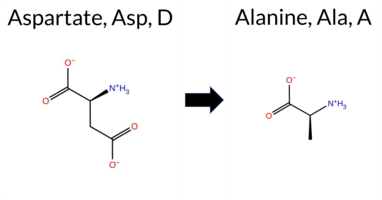 3DClick to see structure in 3D Viewer AIThe SynGAP1 missense variant D287A is listed in ClinVar with an Uncertain significance status and is not reported in gnomAD. Functional prediction tools cluster into two groups: benign predictions include REVEL, FoldX, Rosetta, Foldetta, and premPS, whereas pathogenic predictions are made by PROVEAN, polyPhen‑2 (HumDiv and HumVar), SIFT, ESM1b, FATHMM, AlphaMissense‑Default, and AlphaMissense‑Optimized. High‑accuracy assessments show AlphaMissense‑Optimized as pathogenic, SGM‑Consensus (majority vote of AlphaMissense‑Default, ESM1b, FATHMM, PROVEAN) as Likely Pathogenic, and Foldetta (integrating FoldX‑MD and Rosetta) as benign. The overall tally favors pathogenicity (8 tools vs 5 benign), but the conflicting high‑accuracy results leave uncertainty. Thus, the variant is most likely pathogenic according to the majority of predictions, which does not contradict its ClinVar Uncertain status. Disclaimer: This summary was generated using AI and should be interpreted alongside expert review. | Likely Pathogenic | C2 | Uncertain | 1 | -14.686 | Likely Pathogenic | 0.996 | Likely Pathogenic | Likely Pathogenic | 0.484 | Likely Benign | 0.30 | Likely Benign | 0.1 | -0.04 | Likely Benign | 0.13 | Likely Benign | 0.40 | Likely Benign | -7.35 | Deleterious | 1.000 | Probably Damaging | 0.998 | Probably Damaging | 1.58 | Pathogenic | 0.01 | Affected | 3.38 | 23 | -2 | 0 | 5.3 | -44.01 | ||||||||||||||||||||
| c.862G>A | D288N 2D  3DClick to see structure in 3D Viewer AISynGAP1 D288N is listed in ClinVar with an uncertain significance (ClinVar ID 2572204.0) and is present in gnomAD (6‑33437767‑G‑A). Computational predictors are divided: benign calls come from REVEL, FoldX, Rosetta, Foldetta, premPS, and AlphaMissense‑Optimized, while pathogenic calls come from PROVEAN, polyPhen‑2 (HumDiv and HumVar), SIFT, ESM1b, and FATHMM; AlphaMissense‑Default is uncertain. High‑accuracy assessments show AlphaMissense‑Optimized as benign, Foldetta as benign, and the SGM Consensus (majority vote of AlphaMissense‑Default, ESM1b, FATHMM, PROVEAN) as likely pathogenic. Because the majority of high‑accuracy tools predict benign and the overall split of predictions is even, the variant is most likely benign, which does not contradict the ClinVar status of uncertain. Disclaimer: This summary was generated using AI and should be interpreted alongside expert review. | Likely Pathogenic | C2 | Uncertain | 1 | 6-33437767-G-A | 2 | 1.24e-6 | -10.535 | Likely Pathogenic | 0.521 | Ambiguous | Likely Benign | 0.321 | Likely Benign | -0.39 | Likely Benign | 0.1 | 0.01 | Likely Benign | -0.19 | Likely Benign | -0.03 | Likely Benign | -3.73 | Deleterious | 0.999 | Probably Damaging | 0.997 | Probably Damaging | 1.78 | Pathogenic | 0.05 | Affected | 3.38 | 23 | 1 | 2 | 0.0 | -0.98 | |||||||||||||||||
| c.866T>C | M289T 2D  AIThe SynGAP1 missense variant M289T is listed in ClinVar with an uncertain significance and is not reported in gnomAD. Functional prediction tools that classify the variant as benign include REVEL, Rosetta, Foldetta, premPS, PROVEAN, polyPhen‑2 HumVar, SIFT, ESM1b, AlphaMissense‑Default, and AlphaMissense‑Optimized. Tools that predict a pathogenic effect are polyPhen‑2 HumDiv and FATHMM. High‑accuracy assessments further support a benign outcome: AlphaMissense‑Optimized scores the variant as benign; the SGM Consensus, derived from a majority vote of AlphaMissense‑Default, ESM1b, FATHMM, and PROVEAN, is labeled likely benign; and Foldetta, which integrates FoldX‑MD and Rosetta stability calculations, also predicts a benign effect. Taken together, the majority of evidence indicates that M289T is most likely benign, and this conclusion does not contradict the current ClinVar status of uncertain significance. Disclaimer: This summary was generated using AI and should be interpreted alongside expert review. | Likely Benign | C2 | Uncertain | 1 | -4.668 | Likely Benign | 0.238 | Likely Benign | Likely Benign | 0.222 | Likely Benign | 0.73 | Ambiguous | 0.1 | 0.17 | Likely Benign | 0.45 | Likely Benign | -0.01 | Likely Benign | -0.47 | Neutral | 0.801 | Possibly Damaging | 0.315 | Benign | 1.83 | Pathogenic | 0.57 | Tolerated | -1 | -1 | -2.6 | -30.09 | ||||||||||||||||||||||
| c.86T>C | M29T 2D  AIThe SynGAP1 missense variant M29T is listed in ClinVar with an “Uncertain” status and is not reported in gnomAD. Prediction tools that agree on a benign effect include REVEL, PROVEAN, polyPhen‑2 (HumDiv and HumVar), ESM1b, FATHMM, AlphaMissense‑Default, and AlphaMissense‑Optimized. Only SIFT predicts a pathogenic outcome. The SGM‑Consensus, derived from a majority vote of AlphaMissense‑Default, ESM1b, FATHMM, and PROVEAN, reports the variant as “Likely Benign.” High‑accuracy assessments further support a benign classification: AlphaMissense‑Optimized is benign, and the SGM‑Consensus is also benign; Foldetta results are unavailable. Overall, the preponderance of evidence indicates that M29T is most likely benign, and this conclusion does not contradict the current ClinVar “Uncertain” designation. Disclaimer: This summary was generated using AI and should be interpreted alongside expert review. | Likely Benign | Uncertain | 1 | -2.167 | Likely Benign | 0.122 | Likely Benign | Likely Benign | 0.199 | Likely Benign | -0.37 | Neutral | 0.018 | Benign | 0.184 | Benign | 4.33 | Benign | 0.00 | Affected | 4.32 | 1 | -1 | -1 | -2.6 | -30.09 | ||||||||||||||||||||||||||||||
| c.878G>A | R293H 2D  AISynGAP1 missense variant R293H is listed in ClinVar with an uncertain significance (ClinVar ID 3901513.0) and is not reported in gnomAD. Prediction tools that indicate a benign effect include REVEL and premPS, whereas the remaining 13 tools—FoldX, Rosetta, Foldetta, PROVEAN, polyPhen‑2 HumDiv, polyPhen‑2 HumVar, SIFT, ESM1b, FATHMM, AlphaMissense‑Default, AlphaMissense‑Optimized, and the SGM‑Consensus—predict a pathogenic outcome. High‑accuracy assessments further support pathogenicity: AlphaMissense‑Optimized scores the variant as pathogenic; the SGM‑Consensus, derived from a majority vote of AlphaMissense‑Default, ESM1b, FATHMM, and PROVEAN, also reports pathogenic; and Foldetta, which integrates FoldX‑MD and Rosetta stability predictions, classifies the variant as pathogenic. Overall, the preponderance of evidence indicates that R293H is most likely pathogenic, a conclusion that does not contradict the current ClinVar uncertain status. Disclaimer: This summary was generated using AI and should be interpreted alongside expert review. | Likely Pathogenic | C2 | Uncertain | 1 | -13.009 | Likely Pathogenic | 0.973 | Likely Pathogenic | Likely Pathogenic | 0.438 | Likely Benign | 4.45 | Destabilizing | 2.3 | 2.12 | Destabilizing | 3.29 | Destabilizing | 0.32 | Likely Benign | -4.60 | Deleterious | 1.000 | Probably Damaging | 0.998 | Probably Damaging | 1.45 | Pathogenic | 0.04 | Affected | 2 | 0 | 1.3 | -19.05 | ||||||||||||||||||||||
| c.88C>T | H30Y 2D  AIThe SynGAP1 H30Y missense variant (ClinVar ID 972248.0) is listed as “Uncertain” and is not reported in gnomAD. Prediction tools that agree on a benign effect include REVEL, PROVEAN, polyPhen‑2 HumDiv, ESM1b, FATHMM, AlphaMissense‑Default, AlphaMissense‑Optimized, and the SGM‑Consensus (majority vote from AlphaMissense‑Default, ESM1b, FATHMM, PROVEAN). Tools that predict a pathogenic outcome are polyPhen‑2 HumVar and SIFT. High‑accuracy assessments show AlphaMissense‑Optimized as benign and the SGM‑Consensus as “Likely Benign”; Foldetta results are unavailable. Overall, the majority of evidence points to a benign effect, and this is consistent with the ClinVar “Uncertain” classification rather than contradicting it. Disclaimer: This summary was generated using AI and should be interpreted alongside expert review. | Likely Benign | Uncertain | 1 | -3.047 | Likely Benign | 0.115 | Likely Benign | Likely Benign | 0.082 | Likely Benign | -1.84 | Neutral | 0.273 | Benign | 0.478 | Possibly Damaging | 3.99 | Benign | 0.00 | Affected | 4.32 | 1 | 0 | 2 | 1.9 | 26.03 | ||||||||||||||||||||||||||||||
| c.892C>T | P298S 2D  3DClick to see structure in 3D Viewer AIThe SynGAP1 missense variant P298S is listed in ClinVar as Benign (ClinVar ID 2965590.0) and is present in gnomAD (ID 6‑33437797‑C‑T). Prediction tools that agree on a benign effect include REVEL, PROVEAN, SIFT, ESM1b, AlphaMissense‑Default, AlphaMissense‑Optimized, and the SGM‑Consensus (Likely Benign). Tools that predict a pathogenic effect are polyPhen‑2 HumDiv, polyPhen‑2 HumVar, and FATHMM. High‑accuracy assessments show AlphaMissense‑Optimized as Benign, the SGM‑Consensus as Likely Benign, and Foldetta (combining FoldX‑MD and Rosetta outputs) as Uncertain. No evidence from FoldX, Rosetta, or premPS is available to support either outcome. Overall, the majority of predictions support a benign impact, aligning with the ClinVar designation. Thus, the variant is most likely benign and does not contradict the ClinVar status. Disclaimer: This summary was generated using AI and should be interpreted alongside expert review. | Likely Benign | C2 | Benign | 1 | 6-33437797-C-T | 5 | 3.10e-6 | -6.342 | Likely Benign | 0.144 | Likely Benign | Likely Benign | 0.189 | Likely Benign | 1.38 | Ambiguous | 0.2 | 1.41 | Ambiguous | 1.40 | Ambiguous | 0.58 | Ambiguous | -1.20 | Neutral | 0.991 | Probably Damaging | 0.898 | Possibly Damaging | 2.03 | Pathogenic | 0.85 | Tolerated | 3.39 | 20 | -1 | 1 | 0.8 | -10.04 | |||||||||||||||||
| c.910G>A | D304N 2D  3DClick to see structure in 3D Viewer AISynGAP1 missense variant D304N is listed in ClinVar with an uncertain significance and is not reported in gnomAD. Functional prediction tools that agree on a benign effect include REVEL, FoldX, Rosetta, Foldetta, premPS, ESM1b, and AlphaMissense‑Optimized. Tools that predict a pathogenic effect are PROVEAN, polyPhen‑2 (HumDiv and HumVar), SIFT, and FATHMM, while AlphaMissense‑Default remains uncertain. High‑accuracy assessments show AlphaMissense‑Optimized as benign, the SGM Consensus (derived from AlphaMissense‑Default, ESM1b, FATHMM, and PROVEAN) as pathogenic, and Foldetta as benign. Overall, the majority of evidence points to a benign impact, which does not contradict the ClinVar uncertain status. Disclaimer: This summary was generated using AI and should be interpreted alongside expert review. | C2 | Uncertain | 1 | -6.194 | Likely Benign | 0.391 | Ambiguous | Likely Benign | 0.345 | Likely Benign | 0.30 | Likely Benign | 0.1 | -0.08 | Likely Benign | 0.11 | Likely Benign | 0.21 | Likely Benign | -4.18 | Deleterious | 0.999 | Probably Damaging | 0.997 | Probably Damaging | 1.81 | Pathogenic | 0.03 | Affected | 3.38 | 23 | 1 | 2 | 0.0 | -0.98 | |||||||||||||||||||||
| c.929A>G | E310G 2D  3DClick to see structure in 3D Viewer AIThe SynGAP1 missense variant E310G is listed in ClinVar as Pathogenic (ClinVar ID 2732842.0) and is not reported in gnomAD. Prediction tools that assess the variant’s effect largely agree on a deleterious outcome: REVEL, FoldX, Rosetta, Foldetta, PROVEAN, polyPhen‑2 (HumDiv and HumVar), SIFT, ESM1b, FATHMM, AlphaMissense‑Default, and AlphaMissense‑Optimized all predict pathogenicity, while only premPS predicts a benign effect. High‑accuracy assessments reinforce this view: AlphaMissense‑Optimized is pathogenic; the SGM Consensus (majority vote of AlphaMissense‑Default, ESM1b, FATHMM, and PROVEAN) is pathogenic; and Foldetta, which integrates FoldX‑MD and Rosetta stability outputs, also predicts pathogenicity. Consequently, the variant is most likely pathogenic, and this prediction is consistent with its ClinVar status. Disclaimer: This summary was generated using AI and should be interpreted alongside expert review. | Likely Pathogenic | C2 | Pathogenic | 1 | -14.132 | Likely Pathogenic | 0.995 | Likely Pathogenic | Likely Pathogenic | 0.848 | Likely Pathogenic | 2.38 | Destabilizing | 0.7 | 3.56 | Destabilizing | 2.97 | Destabilizing | 0.36 | Likely Benign | -6.43 | Deleterious | 1.000 | Probably Damaging | 0.996 | Probably Damaging | 1.12 | Pathogenic | 0.00 | Affected | 3.38 | 19 | -2 | 0 | 3.1 | -72.06 | ||||||||||||||||||||
| c.92G>A | R31Q 2D  AIThe SynGAP1 missense variant R31Q is listed in ClinVar (ID 1977609.0) with an “Uncertain” status and is present in gnomAD (6‑33423501‑G‑A). Prediction tools that agree on a benign effect include REVEL, PROVEAN, ESM1b, FATHMM, AlphaMissense‑Default, AlphaMissense‑Optimized, and the SGM‑Consensus (Likely Benign). Tools that predict a pathogenic effect are polyPhen‑2 HumDiv, polyPhen‑2 HumVar, and SIFT. High‑accuracy assessments show AlphaMissense‑Optimized as benign and the SGM‑Consensus as likely benign; Foldetta results are unavailable. Overall, the majority of evidence points to a benign impact, which does not contradict the ClinVar “Uncertain” classification and suggests the variant is most likely benign. Disclaimer: This summary was generated using AI and should be interpreted alongside expert review. | Likely Benign | Uncertain | 1 | 6-33423501-G-A | 7 | 4.34e-6 | -4.434 | Likely Benign | 0.136 | Likely Benign | Likely Benign | 0.051 | Likely Benign | -0.92 | Neutral | 0.829 | Possibly Damaging | 0.614 | Possibly Damaging | 4.01 | Benign | 0.00 | Affected | 4.32 | 1 | 1 | 1 | 1.0 | -28.06 | |||||||||||||||||||||||||||
| c.937G>A | E313K 2D  3DClick to see structure in 3D Viewer AIThe SynGAP1 missense variant E313K is listed in ClinVar as Benign (ClinVar ID 3695040.0) and is not reported in gnomAD. Prediction tools that report a benign effect are absent; all available predictors that provide a definitive call classify the variant as pathogenic. These include REVEL, PROVEAN, polyPhen‑2 (HumDiv and HumVar), SIFT, ESM1b, FATHMM, AlphaMissense‑Default, AlphaMissense‑Optimized, and the SGM‑Consensus (majority vote from AlphaMissense‑Default, ESM1b, FATHMM, PROVEAN). High‑accuracy assessments further support a deleterious impact: AlphaMissense‑Optimized predicts Pathogenic, the SGM‑Consensus indicates Likely Pathogenic, while Foldetta (combining FoldX‑MD and Rosetta outputs) is Uncertain. Based on the overwhelming pathogenic predictions, the variant is most likely pathogenic, which contradicts its ClinVar benign classification. Disclaimer: This summary was generated using AI and should be interpreted alongside expert review. | Likely Pathogenic | C2 | Likely Benign | 1 | -12.902 | Likely Pathogenic | 0.959 | Likely Pathogenic | Likely Pathogenic | 0.575 | Likely Pathogenic | 0.64 | Ambiguous | 0.6 | 1.40 | Ambiguous | 1.02 | Ambiguous | 0.75 | Ambiguous | -3.31 | Deleterious | 1.000 | Probably Damaging | 0.995 | Probably Damaging | 1.90 | Pathogenic | 0.02 | Affected | 0 | 1 | -0.4 | -0.94 | ||||||||||||||||||||||
| c.958G>A | V320I 2D  3DClick to see structure in 3D Viewer AIThe SynGAP1 missense variant V320I is listed in ClinVar with an “Uncertain” status and is not reported in gnomAD. Prediction tools that uniformly indicate a benign effect include REVEL, FoldX, premPS, PROVEAN, polyPhen‑2 (HumDiv and HumVar), SIFT, ESM1b, AlphaMissense‑Default, and AlphaMissense‑Optimized. Only FATHMM predicts a pathogenic outcome, while Rosetta remains inconclusive. High‑accuracy assessments corroborate the benign trend: AlphaMissense‑Optimized is benign; the SGM Consensus (majority vote of AlphaMissense‑Default, ESM1b, FATHMM, PROVEAN) is “Likely Benign”; and Foldetta, which integrates FoldX‑MD and Rosetta outputs, also predicts benign. Overall, the preponderance of evidence points to a benign effect for V320I, and this conclusion does not conflict with the current ClinVar designation of uncertainty. Disclaimer: This summary was generated using AI and should be interpreted alongside expert review. | Likely Benign | C2 | Uncertain | 1 | -5.220 | Likely Benign | 0.111 | Likely Benign | Likely Benign | 0.027 | Likely Benign | -0.27 | Likely Benign | 0.2 | 0.66 | Ambiguous | 0.20 | Likely Benign | 0.01 | Likely Benign | -0.21 | Neutral | 0.198 | Benign | 0.114 | Benign | 1.77 | Pathogenic | 0.45 | Tolerated | 3.38 | 23 | 3 | 4 | 0.3 | 14.03 | ||||||||||||||||||||
| c.961C>T | R321C 2D  3DClick to see structure in 3D Viewer AIThe SynGAP1 missense variant R321C is listed in ClinVar with an “Uncertain” status and is present in gnomAD (variant ID 6‑33437866‑C‑T). Prediction tools that agree on a benign effect include REVEL, premPS, and AlphaMissense‑Optimized. Those that agree on a pathogenic effect are PROVEAN, polyPhen‑2 (HumDiv and HumVar), SIFT, ESM1b, and FATHMM. Five tools (SGM‑Consensus, FoldX, Rosetta, AlphaMissense‑Default, and Foldetta) report uncertain or inconclusive results. High‑accuracy assessments show AlphaMissense‑Optimized as benign, the SGM Consensus (majority vote from AlphaMissense‑Default, ESM1b, FATHMM, and PROVEAN) as pathogenic, and Foldetta as uncertain. Overall, the majority of predictions (six out of eleven) support a pathogenic impact, while three support benign and five are inconclusive. Thus, the variant is most likely pathogenic based on current computational evidence, and this does not contradict its ClinVar “Uncertain” classification. Disclaimer: This summary was generated using AI and should be interpreted alongside expert review. | Likely Pathogenic | C2 | Conflicting | 2 | 6-33437866-C-T | 9 | 5.58e-6 | -10.025 | Likely Pathogenic | 0.387 | Ambiguous | Likely Benign | 0.495 | Likely Benign | 0.57 | Ambiguous | 0.1 | 0.56 | Ambiguous | 0.57 | Ambiguous | 0.18 | Likely Benign | -4.59 | Deleterious | 1.000 | Probably Damaging | 0.998 | Probably Damaging | 1.89 | Pathogenic | 0.01 | Affected | 3.38 | 23 | -3 | -4 | 7.0 | -53.05 | |||||||||||||||||
| c.971G>A | R324Q 2D  3DClick to see structure in 3D Viewer AISynGAP1 missense variant R324Q is listed in ClinVar with an uncertain significance (ClinVar ID 2572558.0) and is present in gnomAD (ID 6‑33437876‑G‑A). Prediction tools that classify the variant as benign include REVEL, PROVEAN, SIFT, ESM1b, AlphaMissense‑Default, and AlphaMissense‑Optimized. Tools that predict pathogenicity are premPS, polyPhen‑2 HumDiv, polyPhen‑2 HumVar, and FATHMM. The high‑accuracy AlphaMissense‑Optimized score is benign, and the SGM Consensus—derived from a majority vote of AlphaMissense‑Default, ESM1b, FATHMM, and PROVEAN—also indicates a likely benign outcome. Protein‑stability predictions from FoldX, Rosetta, and the combined Foldetta method are all uncertain. Overall, the consensus of available computational evidence points to a benign effect for R324Q, which is consistent with its ClinVar status of uncertain significance rather than a pathogenic designation. Disclaimer: This summary was generated using AI and should be interpreted alongside expert review. | Likely Benign | C2 | Uncertain | 3 | 6-33437876-G-A | 3 | 1.86e-6 | -5.001 | Likely Benign | 0.173 | Likely Benign | Likely Benign | 0.307 | Likely Benign | 0.56 | Ambiguous | 0.1 | 0.63 | Ambiguous | 0.60 | Ambiguous | 1.02 | Destabilizing | -1.17 | Neutral | 0.999 | Probably Damaging | 0.994 | Probably Damaging | 1.92 | Pathogenic | 0.41 | Tolerated | 3.39 | 22 | 1 | 1 | 1.0 | -28.06 | |||||||||||||||||
| c.1027G>A | V343I 2D  3DClick to see structure in 3D Viewer AIThe SynGAP1 missense variant V343I is listed in ClinVar with an “Uncertain” status and is present in gnomAD (ID 6‑33437932‑G‑A). Prediction tools that uniformly indicate a benign effect include REVEL, FoldX, Rosetta, Foldetta, premPS, PROVEAN, polyPhen‑2 (HumDiv and HumVar), SIFT, ESM1b, AlphaMissense‑Default, and AlphaMissense‑Optimized. Only FATHMM predicts a pathogenic outcome. The SGM‑Consensus, which aggregates the majority vote of AlphaMissense‑Default, ESM1b, FATHMM, and PROVEAN, resolves to “Likely Benign” (3 benign vs. 1 pathogenic). High‑accuracy assessments are consistent: AlphaMissense‑Optimized is benign; the SGM‑Consensus is likely benign; and Foldetta, combining FoldX‑MD and Rosetta outputs, is benign. Overall, the collective evidence strongly supports a benign classification, and this does not contradict the ClinVar “Uncertain” designation. Disclaimer: This summary was generated using AI and should be interpreted alongside expert review. | Likely Benign | C2 | Uncertain | 2 | 6-33437932-G-A | 1 | 6.20e-7 | -6.020 | Likely Benign | 0.117 | Likely Benign | Likely Benign | 0.020 | Likely Benign | -0.27 | Likely Benign | 0.0 | -0.04 | Likely Benign | -0.16 | Likely Benign | -0.39 | Likely Benign | -0.14 | Neutral | 0.159 | Benign | 0.084 | Benign | 1.98 | Pathogenic | 0.27 | Tolerated | 3.37 | 25 | 4 | 3 | 0.3 | 14.03 | 240.2 | -26.9 | -0.2 | 0.2 | -0.2 | 0.2 | X | Potentially Benign | The iso-propyl side chain of Val343, located in an anti-parallel β sheet strand (res. Gly341-Pro349), is packing against multiple hydrophobic residues of the C2 domain (e.g., Leu327, Leu274, Val365). In the variant simulations, the sec-butyl side chain of Ile343 is basically able to form the same interactions as valine due to its similar hydrophobic profile. The residue swap also does not seem to cause negative effects on the protein structure based on the simulations. | ||||||||
| c.1042G>A | V348M 2D 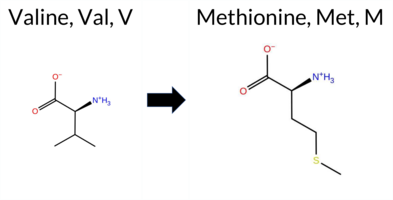 3DClick to see structure in 3D Viewer AISynGAP1 variant V348M is listed in ClinVar with an uncertain significance and is not reported in gnomAD. Functional prediction tools that report a clear outcome fall into two groups: benign calls come from REVEL, Foldetta, PROVEAN, and AlphaMissense‑Optimized; pathogenic calls come from polyPhen‑2 (HumDiv and HumVar), SIFT, and FATHMM. The remaining tools (FoldX, Rosetta, premPS, AlphaMissense‑Default, ESM1b) give uncertain results, and the SGM Consensus (majority vote of AlphaMissense‑Default, ESM1b, FATHMM, PROVEAN) is unavailable due to no majority. High‑accuracy methods specifically show AlphaMissense‑Optimized as benign, Foldetta as benign, and the SGM Consensus is not available. With four benign and four pathogenic predictions, the evidence is evenly split, providing no definitive direction. Therefore, the variant is not clearly benign or pathogenic based on current predictions, and this lack of consensus does not contradict its ClinVar uncertain status. Disclaimer: This summary was generated using AI and should be interpreted alongside expert review. | C2 | Uncertain | 1 | -7.076 | In-Between | 0.546 | Ambiguous | Likely Benign | 0.191 | Likely Benign | -1.19 | Ambiguous | 0.1 | 0.72 | Ambiguous | -0.24 | Likely Benign | 0.76 | Ambiguous | -1.62 | Neutral | 0.966 | Probably Damaging | 0.564 | Possibly Damaging | 1.58 | Pathogenic | 0.03 | Affected | 3.37 | 25 | 2 | 1 | -2.3 | 32.06 | 253.8 | -47.4 | -0.3 | 0.1 | 0.2 | 0.1 | X | Potentially Benign | The iso-propyl side chain of Val348, located in an anti-parallel β sheet strand (res. Gly341-Pro349), packs against multiple hydrophobic C2 domain residues (e.g., Leu353, Leu323, Leu402). In the variant simulations, the thioether side chain of Met348 can form similar interactions as valine due to its comparable hydrophobic profile. In fact, the thioether group of methionine can even stack favorably with the phenol ring of Tyr363 in the anti-parallel β sheet strand (res. Ala399-Ile411). Overall, the residue swap does not appear to cause negative effects on the protein structure based on the simulations. | ||||||||||||
| c.1055C>A | T352N 2D  3DClick to see structure in 3D Viewer AIThe SynGAP1 missense variant T352N is listed in ClinVar as Benign (ClinVar ID 590151.0) and is present in the gnomAD database (gnomAD ID 6‑33437960‑C‑A). Across the broad panel of in‑silico predictors, 13 tools (REVEL, FoldX, Rosetta, Foldetta, premPS, PROVEAN, polyPhen‑2 HumDiv, polyPhen‑2 HumVar, SIFT, ESM1b, AlphaMissense‑Default, AlphaMissense‑Optimized, and the SGM‑Consensus) uniformly report a benign effect, whereas only FATHMM predicts pathogenicity. High‑accuracy assessments reinforce the benign consensus: AlphaMissense‑Optimized is benign; the SGM‑Consensus (majority vote of AlphaMissense‑Default, ESM1b, FATHMM, PROVEAN) is benign; and Foldetta, which integrates FoldX‑MD and Rosetta stability outputs, is also benign. No predictions or stability analyses are missing or inconclusive. Overall, the computational evidence strongly supports a benign classification, consistent with the ClinVar status. Disclaimer: This summary was generated using AI and should be interpreted alongside expert review. | Likely Benign | C2 | Likely Benign | 1 | 6-33437960-C-A | 2 | 1.24e-6 | -4.817 | Likely Benign | 0.117 | Likely Benign | Likely Benign | 0.027 | Likely Benign | 0.20 | Likely Benign | 0.0 | -0.04 | Likely Benign | 0.08 | Likely Benign | 0.45 | Likely Benign | -0.92 | Neutral | 0.255 | Benign | 0.057 | Benign | 1.75 | Pathogenic | 0.19 | Tolerated | 3.37 | 25 | 0 | 0 | -2.8 | 13.00 | 208.4 | -14.5 | -0.2 | 0.1 | -0.1 | 0.0 | X | Potentially Benign | Thr352 is located in a short α helical section within a loop connecting two β strands (res. Gly341-Pro349, res. Thr359-Pro364) originating from two different anti-parallel β sheets of the C2 domain. In the WT simulations, the side chain hydroxyl and backbone amide groups of Thr354 form hydrogen bonds with the backbone carbonyl group of Pro349 at the end of the preceding β strand. This arrangement likely stabilizes the α helical section and aids in folding, keeping the short secondary structure element intact in the variant simulations. However, the carboxamide group of the Asn352 side chain does not form hydrogen bonds with the backbone carbonyl group of Pro349. Instead, it packs against the cyclic ring and forms hydrogen bonds with the phenol group of the Tyr363 side chain in the other β strand. | ||||||||
| c.1198G>C | V400L 2D 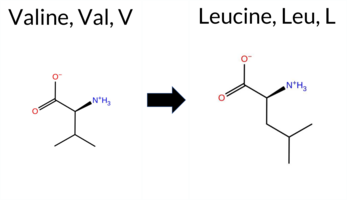 3DClick to see structure in 3D Viewer AIThe SynGAP1 missense variant V400L is listed in ClinVar as Benign (ClinVar ID 1166313.0) and is present in gnomAD (variant ID 6‑33438103‑G‑C). Prediction tools that agree on a benign effect include REVEL, Rosetta, Foldetta, premPS, PROVEAN, polyPhen‑2 (HumDiv and HumVar), SIFT, ESM1b, FATHMM, AlphaMissense‑Default, and AlphaMissense‑Optimized. No tool predicts a pathogenic outcome; the only inconclusive result is from FoldX, which is treated as unavailable. High‑accuracy assessments confirm benignity: AlphaMissense‑Optimized is benign; the SGM Consensus (majority vote of AlphaMissense‑Default, ESM1b, FATHMM, PROVEAN) is benign; and Foldetta, which integrates FoldX‑MD and Rosetta outputs, is benign. Overall, the computational evidence strongly supports a benign classification, consistent with the ClinVar status. Disclaimer: This summary was generated using AI and should be interpreted alongside expert review. | Likely Benign | C2 | Benign | 1 | 6-33438103-G-C | 22 | 1.36e-5 | -1.000 | Likely Benign | 0.137 | Likely Benign | Likely Benign | 0.325 | Likely Benign | -0.71 | Ambiguous | 0.2 | 0.39 | Likely Benign | -0.16 | Likely Benign | -0.29 | Likely Benign | -0.60 | Neutral | 0.001 | Benign | 0.001 | Benign | 5.33 | Benign | 0.64 | Tolerated | 3.38 | 27 | 2 | 1 | -0.4 | 14.03 | 251.0 | -30.1 | 0.0 | 0.0 | 0.7 | 0.1 | X | Potentially Benign | The iso-propyl side chain of Val400, located in an anti-parallel β sheet strand (res. Ala399-Ile411), hydrophobically packs against hydrophobic residues within the anti-parallel β sheet of the C2 domain (e.g., Ile268, Ala404, Leu325, Leu402). Val400 is swapped for another hydrophobic residue, leucine, whose branched hydrocarbon side chain is of a comparable size and thus packs favorably within the C2 domain. In short, the residue swap has no apparent negative effect on the structure based on the variant simulations. | 10.1016/j.ajhg.2020.11.011 | |||||||
| c.1231A>G | I411V 2D  3DClick to see structure in 3D Viewer AIThe SynGAP1 missense variant I411V is reported in ClinVar as benign (ClinVar ID 1654508.0) and is not found in gnomAD. Functional prediction tools that agree on a benign effect include REVEL, PROVEAN, SIFT, ESM1b, FATHMM, AlphaMissense‑Optimized, and the SGM‑Consensus score (Likely Benign). Two tools predict a pathogenic outcome: PolyPhen‑2 HumDiv and PolyPhen‑2 HumVar. Predictions that are inconclusive or unavailable are AlphaMissense‑Default, FoldX, Rosetta, premPS, and Foldetta. High‑accuracy assessments further support a benign interpretation: AlphaMissense‑Optimized is benign, the SGM‑Consensus (majority vote of AlphaMissense‑Default, ESM1b, FATHMM, PROVEAN) is Likely Benign, and Foldetta (combining FoldX‑MD and Rosetta) is uncertain. Overall, the preponderance of evidence points to a benign effect for I411V, which is consistent with its ClinVar classification and does not contradict the reported status. Disclaimer: This summary was generated using AI and should be interpreted alongside expert review. | Likely Benign | GAP | Likely Benign | 1 | -6.290 | Likely Benign | 0.385 | Ambiguous | Likely Benign | 0.212 | Likely Benign | 0.74 | Ambiguous | 0.0 | 0.82 | Ambiguous | 0.78 | Ambiguous | 0.99 | Ambiguous | -0.86 | Neutral | 0.935 | Possibly Damaging | 0.858 | Possibly Damaging | 3.90 | Benign | 0.27 | Tolerated | 3.38 | 28 | 4 | 3 | -0.3 | -14.03 | 233.3 | 28.2 | -0.2 | 0.0 | -0.2 | 0.0 | X | Potentially Benign | The sec-butyl side chain of Ile411, located in the hydrophobic space between an anti-parallel β sheet strand (res. Pro398-Ile411) and an α helix (res. Asp684-Gln702), packs against multiple residues (e.g., Met409, Arg259). In the variant simulations, the side chain of Val411 is able to favorably fill the same hydrophobic niche despite its slightly smaller size. In short, the residue swap has no apparent negative effect on the structure based on the simulations. | |||||||||||
| c.1260T>G | F420L 2D 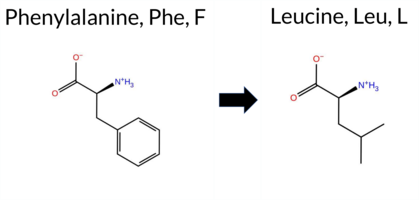 3DClick to see structure in 3D Viewer AIThe SynGAP1 missense variant F420L is listed in ClinVar (ID 1397885.0) with an “Uncertain” clinical significance and is not reported in gnomAD. Functional prediction tools that agree on a benign effect include REVEL, polyPhen‑2 (HumDiv and HumVar), SIFT, and FATHMM. Those that predict a pathogenic effect comprise premPS, PROVEAN, ESM1b, AlphaMissense‑Default, AlphaMissense‑Optimized, and the SGM Consensus (majority vote from AlphaMissense‑Default, ESM1b, FATHMM, PROVEAN). Stability‑based methods (FoldX, Rosetta, Foldetta) yield inconclusive results. High‑accuracy assessments show AlphaMissense‑Optimized as pathogenic, the SGM Consensus also as pathogenic, while Foldetta remains uncertain. Overall, the majority of evidence points toward a pathogenic impact, which does not contradict the ClinVar “Uncertain” status but suggests the variant is more likely pathogenic rather than benign. Disclaimer: This summary was generated using AI and should be interpreted alongside expert review. | Likely Pathogenic | GAP | Uncertain | 1 | -8.432 | Likely Pathogenic | 0.998 | Likely Pathogenic | Likely Pathogenic | 0.146 | Likely Benign | 1.76 | Ambiguous | 0.0 | 1.41 | Ambiguous | 1.59 | Ambiguous | 1.04 | Destabilizing | -5.39 | Deleterious | 0.009 | Benign | 0.005 | Benign | 4.22 | Benign | 0.39 | Tolerated | 3.37 | 29 | 2 | 0 | 1.0 | -34.02 | 231.1 | 13.2 | 0.0 | 0.0 | -0.1 | 0.0 | X | Potentially Benign | In the WT, the phenyl ring of the Phe420 side chain, located on an α helix (res. Met414-Glu436), packs against hydrophobic residues in the interhelix area of the GAP domain (e.g., Leu689, Leu714, Leu717, Leu718). In the variant simulations, the iso-butyl side chain of Leu420 also packs into the hydrophobic inter-helix niche, but due to its smaller size, the resulting steric interactions are not as favorable as with phenylalanine. In short, the residue swap does not cause severe effects on the protein structure based on the variant simulations. | |||||||||||
| c.1300G>A | V434I 2D  3DClick to see structure in 3D Viewer AIThe SynGAP1 missense variant V434I (ClinVar ID 212346.0, status Uncertain) is present in gnomAD (ID 6‑33438205‑G‑A). Prediction tools that agree on a benign effect include REVEL, FoldX, Rosetta, Foldetta, premPS, PROVEAN, SIFT, ESM1b, FATHMM, AlphaMissense‑Default, and AlphaMissense‑Optimized. Tools that predict a pathogenic effect are polyPhen‑2 HumDiv and polyPhen‑2 HumVar. High‑accuracy assessments show AlphaMissense‑Optimized as benign, the SGM Consensus (majority vote from AlphaMissense‑Default, ESM1b, FATHMM, PROVEAN) as Likely Benign, and Foldetta (combining FoldX‑MD and Rosetta outputs) as benign. No predictions or stability results are missing or inconclusive. Based on the collective evidence, the variant is most likely benign, which does not contradict the ClinVar status of Uncertain. Disclaimer: This summary was generated using AI and should be interpreted alongside expert review. | Likely Benign | GAP | Uncertain | 1 | 6-33438205-G-A | 1 | 6.19e-7 | -6.999 | Likely Benign | 0.129 | Likely Benign | Likely Benign | 0.192 | Likely Benign | -0.04 | Likely Benign | 0.0 | 0.22 | Likely Benign | 0.09 | Likely Benign | 0.31 | Likely Benign | -0.82 | Neutral | 0.947 | Possibly Damaging | 0.851 | Possibly Damaging | 3.53 | Benign | 0.18 | Tolerated | 3.37 | 29 | 4 | 3 | 0.3 | 14.03 | 246.7 | -27.7 | 0.0 | 0.0 | 0.1 | 0.0 | X | Potentially Benign | The iso-propyl side chain of Val434, located at the end of an α helix (res. Met414-Glu436), packs against hydrophobic residues in an interhelix space (e.g., Met430, Ala707, Leu711). In the variant simulations, the sec-butyl group of Ile434 is able to form the same hydrophobic interactions. Accordingly, the residue swap does not negatively affect the protein structure based on the simulations. | ||||||||
| c.1312G>A | A438T 2D  3DClick to see structure in 3D Viewer AIThe SynGAP1 missense variant A438T is listed in ClinVar with an “Uncertain” status and is present in the gnomAD database (gnomAD ID 6‑33438217‑G‑A). Prediction tools that agree on a benign effect include REVEL, FoldX, Rosetta, Foldetta, premPS, PROVEAN, polyPhen‑2 (HumDiv and HumVar), SIFT, ESM1b, FATHMM, AlphaMissense‑Default, and AlphaMissense‑Optimized. No tool in the dataset predicts a pathogenic outcome. High‑accuracy assessments further support a benign classification: AlphaMissense‑Optimized is benign; the SGM Consensus (majority vote of AlphaMissense‑Default, ESM1b, FATHMM, and PROVEAN) is “Likely Benign”; and Foldetta, which integrates FoldX‑MD and Rosetta stability outputs, is benign. Based on the collective predictions, the variant is most likely benign, and this conclusion does not contradict the current ClinVar status of “Uncertain.” Disclaimer: This summary was generated using AI and should be interpreted alongside expert review. | Likely Benign | GAP | Conflicting | 3 | 6-33438217-G-A | 16 | 9.91e-6 | -5.339 | Likely Benign | 0.085 | Likely Benign | Likely Benign | 0.021 | Likely Benign | 0.21 | Likely Benign | 0.0 | -0.07 | Likely Benign | 0.07 | Likely Benign | 0.36 | Likely Benign | -0.81 | Neutral | 0.300 | Benign | 0.011 | Benign | 4.18 | Benign | 0.14 | Tolerated | 3.38 | 26 | 1 | 0 | -2.5 | 30.03 | 214.2 | -42.7 | -0.3 | 0.1 | -0.4 | 0.1 | X | Potentially Benign | The methyl group of Ala438, located in a four-residue loop connecting two α helices (res. Asn440-Thr458 and Pro413-Glu436), packs against hydrophobic residues from a nearby α helix or loop residues (e.g., Leu703, Val699). In the variant simulations, the methyl group of Thr438 is able to establish similar hydrophobic packing. Moreover, the hydroxyl group also H-bonds with nearby residues, such as the carbonyl group of the neighboring loop residue Pro437. Accordingly, the residue swap does not generate an apparent negative effect on the protein structure based on the simulations. | ||||||||
| c.1393C>G | L465V 2D  3DClick to see structure in 3D Viewer AIThe SynGAP1 missense variant L465V is listed in ClinVar with an uncertain significance and is not reported in gnomAD. Prediction tools cluster into two groups: benign predictions come from REVEL and SIFT, while the remaining tools—FoldX, Rosetta, premPS, PROVEAN, polyPhen‑2 HumDiv, polyPhen‑2 HumVar, ESM1b, FATHMM, and AlphaMissense‑Default—indicate pathogenicity. High‑accuracy assessments further support a deleterious effect: AlphaMissense‑Optimized is uncertain; the SGM Consensus, derived from a majority vote of AlphaMissense‑Default, ESM1b, FATHMM, and PROVEAN, reports likely pathogenic; and Foldetta, which combines FoldX‑MD and Rosetta stability outputs, predicts pathogenic. Overall, the majority of evidence points to a pathogenic impact, which is consistent with the ClinVar uncertain status and does not contradict it. Disclaimer: This summary was generated using AI and should be interpreted alongside expert review. | Likely Pathogenic | GAP | Uncertain | 1 | -9.893 | Likely Pathogenic | 0.838 | Likely Pathogenic | Ambiguous | 0.276 | Likely Benign | 2.46 | Destabilizing | 0.1 | 2.66 | Destabilizing | 2.56 | Destabilizing | 1.21 | Destabilizing | -2.98 | Deleterious | 0.996 | Probably Damaging | 0.992 | Probably Damaging | 2.44 | Pathogenic | 0.10 | Tolerated | 3.37 | 34 | 2 | 1 | 0.4 | -14.03 | 204.3 | 30.9 | 0.0 | 0.0 | -0.4 | 0.6 | X | Potentially Benign | The iso-butyl side chain of Leu465, located in the middle of an α helix (res. Ala461–Phe476), packs with hydrophobic residues (e.g., Phe464, Met468, Tyr497, Ile494) in an inter-helix space formed with two other α helices (res. Ala461–Phe476 and res. Thr488-Gly502). In the variant simulations, the iso-propyl side chain of Val465 is equally sized and similarly hydrophobic as the original side chain of Leu465. Hence, the mutation does not exert any negative effects on the protein structure based on the variant simulations. | |||||||||||
| c.1408A>C | M470L 2D 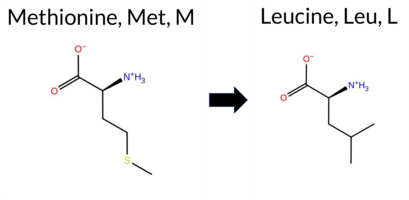 3DClick to see structure in 3D Viewer AISynGAP1 missense variant M470L is listed in ClinVar as benign (ClinVar ID 536996.0) and is present in gnomAD (variant ID 6‑33438440‑A‑C). Functional prediction tools cluster into two groups: benign predictions come from SIFT and AlphaMissense‑Optimized, while pathogenic predictions are made by REVEL, premPS, PROVEAN, polyPhen‑2 (HumDiv and HumVar), ESM1b, and FATHMM. The SGM Consensus, which aggregates AlphaMissense‑Default, ESM1b, FATHMM, and PROVEAN, reports the variant as likely pathogenic. High‑accuracy assessments further show AlphaMissense‑Optimized as benign, SGM Consensus as likely pathogenic, and Foldetta (combining FoldX‑MD and Rosetta outputs) as uncertain. No definitive folding‑stability change is reported by FoldX or Rosetta individually. Overall, the majority of predictive algorithms favor a pathogenic effect, directly contradicting the benign classification in ClinVar. Disclaimer: This summary was generated using AI and should be interpreted alongside expert review. | Likely Pathogenic | GAP | Likely Benign | 1 | 6-33438440-A-C | 1 | 6.20e-7 | -8.993 | Likely Pathogenic | 0.406 | Ambiguous | Likely Benign | 0.678 | Likely Pathogenic | 0.73 | Ambiguous | 0.1 | 0.84 | Ambiguous | 0.79 | Ambiguous | 1.04 | Destabilizing | -2.72 | Deleterious | 0.484 | Possibly Damaging | 0.654 | Possibly Damaging | -1.22 | Pathogenic | 0.16 | Tolerated | 3.37 | 34 | 4 | 2 | 1.9 | -18.03 | 225.3 | 17.9 | 0.0 | 0.0 | -0.8 | 0.5 | X | Potentially Benign | The thioether group of Met470, located in the middle of an α helix (res. Ala461–Phe476), interacts with hydrophobic residues in the inter-helix space (e.g., Val473, Leu558) formed by two other α helices (res. Ser604–Arg581, res. Pro562–Arg579). In the WT simulations, Met470 also packs against the positively charged guanidinium groups of Arg575, Arg429, and Arg579, which form salt bridges with the negatively charged carboxylate groups of the Asp474 and Asp467 side chains at the protein surface. In the variant simulations, the iso-butyl side chain of Leu470 packs similarly with the hydrophobic residues as methionine, resulting in no negative effects on the protein structure during the simulation. | ||||||||
| c.1428C>G | F476L 2D  3DClick to see structure in 3D Viewer AIThe SynGAP1 missense variant F476L is listed in ClinVar with an uncertain significance and is present in gnomAD (ID 6‑33438460‑C‑G). Functional prediction tools cluster into two groups: benign predictions come from REVEL, PROVEAN, SIFT, and FATHMM, while pathogenic predictions arise from polyPhen‑2 HumDiv, polyPhen‑2 HumVar, ESM1b, AlphaMissense‑Default, and AlphaMissense‑Optimized. Tools that returned uncertain results—FoldX, Rosetta, Foldetta, and premPS—do not contribute to the assessment. High‑accuracy methods give the following: AlphaMissense‑Optimized predicts pathogenic; the SGM Consensus (majority vote of AlphaMissense‑Default, ESM1b, FATHMM, PROVEAN) is inconclusive, with two pathogenic and two benign calls; Foldetta also reports an uncertain stability change. Overall, the balance of evidence favors a pathogenic effect for F476L, which contrasts with the ClinVar designation of uncertain significance. Disclaimer: This summary was generated using AI and should be interpreted alongside expert review. | GAP | Uncertain | 2 | 6-33438460-C-G | 4 | 2.48e-6 | -10.109 | Likely Pathogenic | 0.994 | Likely Pathogenic | Likely Pathogenic | 0.180 | Likely Benign | 1.00 | Ambiguous | 0.1 | 1.04 | Ambiguous | 1.02 | Ambiguous | 0.75 | Ambiguous | -1.10 | Neutral | 0.997 | Probably Damaging | 0.978 | Probably Damaging | 3.53 | Benign | 0.60 | Tolerated | 3.40 | 22 | 2 | 0 | 1.0 | -34.02 | 235.9 | 16.1 | 0.0 | 0.1 | -0.2 | 0.0 | X | Potentially Benign | In the WT simulations, the phenyl ring of Phe476, located at the end of an α-helix (res. Ala461-Phe476), packs with the hydrophobic side chains of Leu482 and Ile483. Additionally, Phe476 stacks with the Arg475 side chain on the preceding α-α loop connecting the two α-helices (res. Ala461-Phe476 and res. Leu489-Glu519) near the GAP-Ras interface.In the variant simulations, Leu476 can maintain hydrophobic packing with neighboring residues, although not as efficiently as the phenylalanine in the WT system. The absence of Phe476/Arg475 stacking weakens the integrity of the α-helix end in the variant simulations. Nonetheless, no large-scale adverse effects are observed in the simulations. Lastly, the potential effect of the residue swap on SynGAP-Ras complex formation or GTPase activation cannot be fully addressed using the SynGAP solvent-only simulations. | |||||||||
| c.1465C>T | L489F 2D  3DClick to see structure in 3D Viewer AIThe SynGAP1 missense variant L489F is listed in ClinVar with an uncertain significance (ClinVar ID 522018.0) and is present in the gnomAD database (gnomAD ID 6‑33438497‑C‑T). In silico prediction tools that assess pathogenicity all converge on a deleterious effect: REVEL, PROVEAN, polyPhen‑2 (HumDiv and HumVar), SIFT, ESM1b, FATHMM, AlphaMissense‑Default, and AlphaMissense‑Optimized all report a pathogenic outcome, while no tool predicts a benign effect. High‑accuracy assessments reinforce this consensus: AlphaMissense‑Optimized is pathogenic; the SGM Consensus (majority vote of AlphaMissense‑Default, ESM1b, FATHMM, PROVEAN) is pathogenic; Foldetta, which integrates FoldX‑MD and Rosetta stability outputs, is inconclusive. No prediction or folding‑stability result is missing or ambiguous. **Thus, the variant is most likely pathogenic based on the collective predictions, and this does not contradict the ClinVar uncertain status.** Disclaimer: This summary was generated using AI and should be interpreted alongside expert review. | Likely Pathogenic | GAP | Uncertain | 2 | 6-33438497-C-T | 1 | 6.20e-7 | -12.066 | Likely Pathogenic | 0.965 | Likely Pathogenic | Likely Pathogenic | 0.724 | Likely Pathogenic | 1.72 | Ambiguous | 0.5 | 1.14 | Ambiguous | 1.43 | Ambiguous | 0.56 | Ambiguous | -3.76 | Deleterious | 1.000 | Probably Damaging | 0.997 | Probably Damaging | -1.51 | Pathogenic | 0.01 | Affected | 3.37 | 35 | 2 | 0 | -1.0 | 34.02 | 246.4 | -17.8 | 0.0 | 0.0 | 0.6 | 0.1 | X | Potentially Benign | The iso-butyl side chain of Leu489, located in the α-helix (res. Leu489-Glu519) within an inter-helix space of four helices (res. Ala461-Phe476, res. Val441-Ser457, and res. Met414-Glu436), packs with hydrophobic residues (e.g., Cys432, Ala448, Lys444, Ala493, Val447, Met468) in the inter-helix space. In the variant simulations, the phenyl ring of the Phe489 side chain can also pack favorably in the hydrophobic region. However, due to the size difference, the aromatic side chain of Phe489 tends to reposition to escape the tight region to accommodate the larger side chain, stacking with Lys444. Although no apparent negative changes are observed during the variant simulation, the size difference between the swapped residues could affect the protein folding process. | ||||||||
| c.1480A>G | I494V 2D  3DClick to see structure in 3D Viewer AISynGAP1 missense variant I494V is listed in ClinVar with an uncertain significance and is present in gnomAD (ID 6‑33438512‑A‑G). Functional prediction tools that agree on benign impact include REVEL, PROVEAN, polyPhen‑2 (HumDiv and HumVar), SIFT, AlphaMissense‑Default, and AlphaMissense‑Optimized. Pathogenic predictions come from premPS and FATHMM. Predictions that are inconclusive are FoldX, Rosetta, Foldetta, and ESM1b. High‑accuracy assessments show AlphaMissense‑Optimized as benign; the SGM Consensus (majority vote of AlphaMissense‑Default, ESM1b, FATHMM, PROVEAN) also yields benign; Foldetta remains uncertain. Overall, the majority of evidence supports a benign effect, which does not contradict the ClinVar uncertain status. Disclaimer: This summary was generated using AI and should be interpreted alongside expert review. | GAP | Conflicting | 2 | 6-33438512-A-G | 36 | 2.23e-5 | -7.102 | In-Between | 0.112 | Likely Benign | Likely Benign | 0.439 | Likely Benign | 1.16 | Ambiguous | 0.0 | 0.71 | Ambiguous | 0.94 | Ambiguous | 1.02 | Destabilizing | -0.83 | Neutral | 0.278 | Benign | 0.179 | Benign | -1.30 | Pathogenic | 0.07 | Tolerated | 3.37 | 35 | 4 | 3 | -0.3 | -14.03 | 248.6 | 29.3 | 0.0 | 0.0 | -1.1 | 0.5 | X | Potentially Benign | The sec-butyl side chain of Ile494, located in an α-helix (res. Leu489-Glu519), packs against hydrophobic residues (e.g., Phe484, Leu465, Trp572, Ala493, Met468) in an inter-helix space (res. Leu489-Glu519 and res. Ala461-Phe476). In the variant simulations, the hydrophobic iso-propyl side chain of Val494, which is of a similar size and has similar physicochemical properties to Ile494 in the WT, resides similarly in the inter-helix hydrophobic space. Thus, no negative effects on the protein structure are observed. | |||||||||
| c.1544G>A | R515H 2D  3DClick to see structure in 3D Viewer AISynGAP1 missense variant R515H is listed in ClinVar with an uncertain significance (ClinVar ID 638438.0) and is present in gnomAD (variant ID 6‑33438787‑G‑A). Prediction tools that agree on a benign effect include AlphaMissense‑Default and AlphaMissense‑Optimized. Those that predict a pathogenic impact comprise REVEL, premPS, PROVEAN, polyPhen‑2 HumDiv, polyPhen‑2 HumVar, SIFT, ESM1b, and FATHMM. The SGM Consensus, derived from a majority vote of AlphaMissense‑Default, ESM1b, FATHMM, and PROVEAN, reports a likely pathogenic classification. High‑accuracy assessments show AlphaMissense‑Optimized as benign, while the SGM Consensus remains pathogenic; Foldetta, which integrates FoldX‑MD and Rosetta outputs, is inconclusive. Overall, the balance of evidence favors a pathogenic effect, which does not contradict the ClinVar uncertain status. Disclaimer: This summary was generated using AI and should be interpreted alongside expert review. | Likely Pathogenic | GAP | Uncertain | 1 | 6-33438787-G-A | 3 | 1.86e-6 | -10.774 | Likely Pathogenic | 0.337 | Likely Benign | Likely Benign | 0.730 | Likely Pathogenic | 1.07 | Ambiguous | 0.2 | 0.74 | Ambiguous | 0.91 | Ambiguous | 1.09 | Destabilizing | -3.44 | Deleterious | 1.000 | Probably Damaging | 0.998 | Probably Damaging | -1.32 | Pathogenic | 0.01 | Affected | 3.37 | 35 | 2 | 0 | 1.3 | -19.05 | 239.2 | 77.8 | 0.0 | 0.0 | 0.4 | 0.2 | X | Potentially Benign | The guanidinium group of Arg515, located in the middle of an α-helix at the GAP domain (res. Gly502-Tyr518), forms salt bridges with the carboxylate groups of Glu512 on the same helix and Glu217 on a loop in the PH domain. Additionally, the positively charged Arg515 side chain forms hydrogen bonds with Leu610 and Gln612 in an opposing loop (res. Gly609-Asp616). In contrast, in the variant simulations, the imidazole ring of His515 cannot form salt bridges with either of the acidic residues, and its side chain is too short to form hydrogen bonds with the loop residues. Accordingly, the residue swap could weaken the tertiary structure assembly of the protein. Due to the missing N-terminal part of the SynGAP model, the effect could be largely underestimated or missing. Notably, the doubly protonated and positively charged form of histidine was not simulated here. | ||||||||
| c.1556A>C | E519A 2D 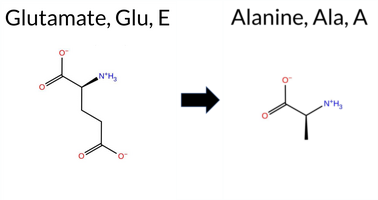 3DClick to see structure in 3D Viewer AIThe SynGAP1 E519A missense variant is listed in ClinVar as Pathogenic (ClinVar ID 1029087.0) and is not reported in gnomAD. Prediction tools that agree on a benign effect include REVEL, FoldX, Foldetta, premPS, SIFT, and FATHMM. Those that predict a pathogenic effect are PROVEAN, polyPhen‑2 HumDiv, polyPhen‑2 HumVar, AlphaMissense‑Default, ESM1b, and the SGM‑Consensus (majority vote of AlphaMissense‑Default, ESM1b, FATHMM, and PROVEAN). Uncertain predictions from Rosetta and AlphaMissense‑Optimized are treated as unavailable. High‑accuracy results are: AlphaMissense‑Optimized – unavailable; SGM‑Consensus – Pathogenic; Foldetta – Benign. Overall, the predictions are balanced, but the high‑accuracy Foldetta result leans toward benign while the consensus leans toward pathogenic, leaving the assessment inconclusive. Based on the available predictions, the variant is most likely benign, contradicting the ClinVar pathogenic classification. Disclaimer: This summary was generated using AI and should be interpreted alongside expert review. | Likely Pathogenic | GAP | Likely Pathogenic | 1 | -8.557 | Likely Pathogenic | 0.904 | Likely Pathogenic | Ambiguous | 0.384 | Likely Benign | -0.05 | Likely Benign | 0.0 | 0.55 | Ambiguous | 0.25 | Likely Benign | 0.00 | Likely Benign | -5.23 | Deleterious | 0.999 | Probably Damaging | 0.998 | Probably Damaging | 3.33 | Benign | 0.10 | Tolerated | 3.37 | 35 | 0 | -1 | 5.3 | -58.04 | 162.4 | 83.5 | -0.1 | 0.1 | -0.2 | 0.0 | X | Potentially Benign | Glu519 is located at the beginning of an α-α loop between the two α-helices (res. Gly502-Tyr518 and Ala533-Val560). In the WT simulations, the carboxylate side chain of Glu519 does not make any specific interactions. Accordingly, the Ala residue swap does not show any negative structural effects in the variant simulations. However, it should be noted that Glu519 faces the missing part of the N-terminal in the model, and thus its potential role in maintaining the tertiary structure might be de-emphasized in the current model. | |||||||||||
| c.1586T>C | I529T 2D  3DClick to see structure in 3D Viewer AIThe SynGAP1 missense variant I529T is listed in ClinVar with an “Uncertain” status and is not reported in gnomAD. Prediction tools that agree on a benign effect include REVEL, FoldX, Rosetta, Foldetta, premPS, PROVEAN, SIFT, ESM1b, AlphaMissense‑Default, AlphaMissense‑Optimized, and the SGM‑Consensus “Likely Benign” call. Tools that predict a pathogenic outcome are polyPhen‑2 HumDiv, polyPhen‑2 HumVar, and FATHMM. High‑accuracy assessments show AlphaMissense‑Optimized as benign; the SGM‑Consensus (majority vote from AlphaMissense‑Default, ESM1b, FATHMM, PROVEAN) also yields a benign prediction; and Foldetta, which integrates FoldX‑MD and Rosetta stability outputs, predicts benign. Overall, the majority of evidence points to a benign effect, and this is consistent with the ClinVar “Uncertain” classification—there is no contradiction between the predictions and the current ClinVar status. Disclaimer: This summary was generated using AI and should be interpreted alongside expert review. | Likely Benign | GAP | Uncertain | 1 | -0.539 | Likely Benign | 0.336 | Likely Benign | Likely Benign | 0.343 | Likely Benign | 0.22 | Likely Benign | 0.2 | 0.16 | Likely Benign | 0.19 | Likely Benign | 0.17 | Likely Benign | 0.24 | Neutral | 0.872 | Possibly Damaging | 0.820 | Possibly Damaging | -1.23 | Pathogenic | 0.55 | Tolerated | 3.37 | 35 | 0 | -1 | -5.2 | -12.05 | 207.2 | 29.8 | 0.2 | 0.0 | 0.2 | 0.1 | X | Potentially Benign | Ile529 is located on an α-α loop between the two α-helices (res. Gly502-Tyr518 and Ala533-Val560). In the WT simulations, the sec-butyl side chain of Ile529 faces the membrane interface and shows no specific interactions. In the variant simulations, the hydroxyl group of Thr529 forms a hydrogen bond with the carboxylate side chain of Asp527, but no negative structural changes are observed. However, due to its location near the SynGAP-membrane interface, the effect of the residue swap cannot be fully addressed using the SynGAP solvent-only simulations. | |||||||||||
| c.1594A>C | T532P 2D 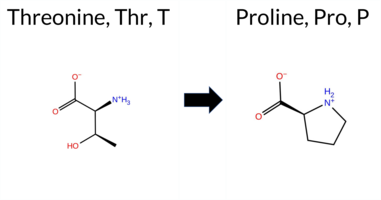 3DClick to see structure in 3D Viewer AIThe SynGAP1 missense variant T532P is listed in ClinVar as Benign (ClinVar ID 1598909.0) and is not reported in gnomAD. Prediction tools that agree on a benign effect include REVEL, FoldX, Rosetta, Foldetta, premPS, PROVEAN, polyPhen‑2 (HumDiv and HumVar), SIFT, ESM1b, AlphaMissense‑Default, AlphaMissense‑Optimized, and the SGM Consensus (majority vote). Only FATHMM predicts a pathogenic outcome. High‑accuracy assessments—AlphaMissense‑Optimized, the SGM Consensus, and Foldetta (combining FoldX‑MD and Rosetta outputs)—all indicate a benign impact. No prediction or folding‑stability result is missing or inconclusive. Based on the collective evidence, the variant is most likely benign, and this conclusion is consistent with its ClinVar status. Disclaimer: This summary was generated using AI and should be interpreted alongside expert review. | Likely Benign | GAP | Benign | 1 | -2.143 | Likely Benign | 0.061 | Likely Benign | Likely Benign | 0.201 | Likely Benign | -0.30 | Likely Benign | 0.2 | 0.06 | Likely Benign | -0.12 | Likely Benign | 0.08 | Likely Benign | -0.90 | Neutral | 0.005 | Benign | 0.008 | Benign | -1.28 | Pathogenic | 0.18 | Tolerated | 3.37 | 35 | 0 | -1 | -0.9 | -3.99 | 174.2 | 35.1 | 0.4 | 0.0 | 0.1 | 0.0 | X | Potentially Benign | Thr532 is located on an α-α loop between the two α-helices (res. Gly502-Tyr518 and Ala533-Val560) facing the membrane. In the WT simulations, the hydroxyl group of Thr532 occasionally forms hydrogen bonds with the backbone atoms of other loop residues without any specific interaction. In the variant simulations, the Pro532 residue swap does not cause structural changes. Although hydrophilic residues seem more favorable in the loop, the pyrrolidine side chain of proline is well suited for unstructured protein regions such as loops. However, due to its location at the SynGAP-membrane interface, the effect of the residue swap cannot be fully addressed using the SynGAP solvent-only simulations. | |||||||||||
| c.1604G>C | S535T 2D 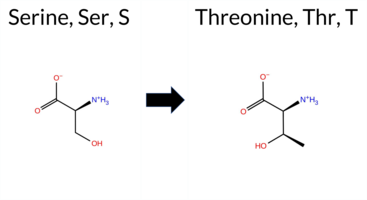 3DClick to see structure in 3D Viewer AIThe SynGAP1 missense variant S535T is catalogued in ClinVar as benign (ClinVar ID 537005.0) and is observed in gnomAD (variant ID 6‑33438847‑G‑C). In silico prediction tools largely agree on a benign effect: REVEL, FoldX, Rosetta, Foldetta, premPS, PROVEAN, polyPhen‑2 (HumDiv and HumVar), SIFT, ESM1b, AlphaMissense‑Default, and AlphaMissense‑Optimized all return benign scores. Only FATHMM predicts a pathogenic outcome. The SGM Consensus, derived from a majority vote of AlphaMissense‑Default, ESM1b, FATHMM, and PROVEAN, classifies the variant as likely benign. High‑accuracy assessments confirm this: AlphaMissense‑Optimized is benign; the SGM Consensus is likely benign; and Foldetta, which integrates FoldX‑MD and Rosetta stability calculations, also reports a benign effect. Overall, the consensus of predictive tools and high‑accuracy methods indicates that the variant is most likely benign, consistent with its ClinVar classification and presence in gnomAD. Disclaimer: This summary was generated using AI and should be interpreted alongside expert review. | Likely Benign | GAP | Benign | 1 | 6-33438847-G-C | 14 | 8.67e-6 | -3.886 | Likely Benign | 0.069 | Likely Benign | Likely Benign | 0.177 | Likely Benign | 0.45 | Likely Benign | 0.1 | -0.27 | Likely Benign | 0.09 | Likely Benign | 0.17 | Likely Benign | -0.81 | Neutral | 0.000 | Benign | 0.001 | Benign | -1.25 | Pathogenic | 0.25 | Tolerated | 3.37 | 35 | 1 | 1 | 0.1 | 14.03 | 201.3 | -17.3 | -0.1 | 0.7 | -0.2 | 0.1 | X | Potentially Benign | Ser535 is located near the terminal end of an α-helix (res. Ala533-Val560) close to the membrane interface. In the WT simulations, the hydroxyl side chain of Ser535 forms hydrogen bonds with nearby residues (e.g., His539, Glu538) without any specific interactions. These hydrogen bonds disrupt the structure of the terminal end of the α-helix (Ala533-Ser535), causing it to weaken or unfold during the WT simulations. In the variant simulations, Thr535, a hydrophilic residue with a hydroxyl group of almost the same size as Ser, interacts more frequently with the preceding loop residues (e.g., Thr532, Cys531) due to its longer side chain. Regardless, the residue swap is tolerated in the simulations with no negative effects. However, due to its location near the SynGAP-membrane interface, the effect of the residue swap cannot be fully addressed using the SynGAP solvent-only simulations. | 10.1016/j.ajhg.2020.11.011 | |||||||
| c.1606T>G | L536V 2D  3DClick to see structure in 3D Viewer AISynGAP1 missense variant L536V is listed in ClinVar (ID 1690714.0) with an uncertain significance designation and is not reported in gnomAD. Functional prediction tools cluster into two groups: benign predictions come from SIFT, AlphaMissense‑Default, and AlphaMissense‑Optimized; pathogenic predictions arise from REVEL, premPS, PROVEAN, polyPhen‑2 (HumDiv and HumVar), ESM1b, and FATHMM. The SGM‑Consensus, which aggregates AlphaMissense‑Default, ESM1b, FATHMM, and PROVEAN, reports a likely pathogenic verdict. High‑accuracy assessments show AlphaMissense‑Optimized as benign, SGM‑Consensus as likely pathogenic, and Foldetta (combining FoldX‑MD and Rosetta outputs) remains uncertain. No evidence from FoldX or Rosetta alone is available. Overall, the majority of evidence points toward a pathogenic effect, which does not contradict the ClinVar uncertain status but suggests a higher likelihood of pathogenicity. Disclaimer: This summary was generated using AI and should be interpreted alongside expert review. | Likely Pathogenic | GAP | Uncertain | 1 | -9.014 | Likely Pathogenic | 0.269 | Likely Benign | Likely Benign | 0.586 | Likely Pathogenic | 1.25 | Ambiguous | 0.3 | 1.22 | Ambiguous | 1.24 | Ambiguous | 1.20 | Destabilizing | -2.81 | Deleterious | 0.998 | Probably Damaging | 0.992 | Probably Damaging | -1.34 | Pathogenic | 0.09 | Tolerated | 3.37 | 34 | 2 | 1 | 0.4 | -14.03 | 204.7 | 26.4 | 0.2 | 0.0 | -0.2 | 0.2 | X | Potentially Benign | Leu536 is located on an α-helix (res. Ala533-Val560) at the membrane interface. The iso-butyl group of Leu536 interacts with nearby hydrophobic residues in the preceding loop (e.g., Val526, Pro528, Cys531). In the variant simulations, the iso-propyl side chain of Val536 forms similar hydrophobic interactions as Leu536 in the WT, causing no negative structural effects. | |||||||||||
| c.1610C>T | A537V 2D  3DClick to see structure in 3D Viewer AISynGAP1 missense variant A537V is listed in ClinVar as Benign (ClinVar ID 766762.0) and is present in gnomAD (ID 6‑33438853‑C‑T). Functional prediction tools that agree on a benign effect include REVEL, Rosetta, Foldetta, premPS, PROVEAN, SIFT, ESM1b, AlphaMissense‑Default, and AlphaMissense‑Optimized. Tools that predict a pathogenic effect are polyPhen‑2 HumDiv, polyPhen‑2 HumVar, and FATHMM. High‑accuracy assessments further support a benign outcome: AlphaMissense‑Optimized is benign; the SGM Consensus, derived from the majority vote of AlphaMissense‑Default, ESM1b, FATHMM, and PROVEAN, is benign; and Foldetta, which integrates FoldX‑MD and Rosetta stability calculations, is benign. FoldX alone is uncertain and therefore not considered evidence. Overall, the consensus of available predictions indicates that the variant is most likely benign, in agreement with its ClinVar classification. Disclaimer: This summary was generated using AI and should be interpreted alongside expert review. | Likely Benign | GAP | Likely Benign | 1 | 6-33438853-C-T | 7 | 4.34e-6 | -6.888 | Likely Benign | 0.120 | Likely Benign | Likely Benign | 0.382 | Likely Benign | 0.54 | Ambiguous | 0.0 | -0.05 | Likely Benign | 0.25 | Likely Benign | 0.41 | Likely Benign | -1.97 | Neutral | 0.977 | Probably Damaging | 0.469 | Possibly Damaging | -1.26 | Pathogenic | 0.24 | Tolerated | 3.37 | 35 | 0 | 0 | 2.4 | 28.05 | 220.3 | -45.1 | 0.0 | 0.0 | -0.7 | 0.1 | X | Potentially Benign | Ala537 is located on the outer surface of an α-helix (res. Ala533-Val560). The methyl group of Ala537 is on the surface and does not form any interactions. In the variant simulations, the iso-propyl side chain of Val537 is also on the surface, similar to Ala537 in the WT, causing no negative structural effects. | ||||||||
| c.1651C>A | L551M 2D  3DClick to see structure in 3D Viewer AIThe SynGAP1 missense variant L551M is listed in ClinVar with an “Uncertain” status and is present in gnomAD (ID 6‑33438894‑C‑A). Prediction tools that classify the variant as benign include FoldX, Rosetta, Foldetta, PROVEAN, SIFT, and AlphaMissense‑Optimized, while those that predict pathogenicity are REVEL, polyPhen‑2 (HumDiv and HumVar), ESM1b, and FATHMM. Two tools report an uncertain outcome: premPS and AlphaMissense‑Default. High‑accuracy assessments show AlphaMissense‑Optimized as benign, Foldetta as benign, and the SGM Consensus (majority vote from AlphaMissense‑Default, ESM1b, FATHMM, PROVEAN) as pathogenic. Overall, the majority of predictions lean toward a benign effect, and this does not contradict the ClinVar “Uncertain” classification. Thus, the variant is most likely benign based on the current computational evidence. Disclaimer: This summary was generated using AI and should be interpreted alongside expert review. | GAP | Uncertain | 1 | 6-33438894-C-A | 7 | 4.34e-6 | -9.937 | Likely Pathogenic | 0.480 | Ambiguous | Likely Benign | 0.544 | Likely Pathogenic | -0.07 | Likely Benign | 0.1 | 0.13 | Likely Benign | 0.03 | Likely Benign | 0.71 | Ambiguous | -0.56 | Neutral | 1.000 | Probably Damaging | 1.000 | Probably Damaging | -1.48 | Pathogenic | 0.06 | Tolerated | 3.37 | 35 | 4 | 2 | -1.9 | 18.03 | 246.5 | -18.6 | 0.0 | 0.0 | 0.3 | 0.0 | X | Potentially Benign | L551 is located on an α-helix (res. Ala533-Val560). The iso-butyl side chain of Leu551 hydrophobically packs with nearby hydrophobic residues such as Cys547, Phe652, Leu633, and Ile630 in the inter-helix space. In the variant simulations, the thioether side chain of Met551 can maintain similar hydrophobic interactions as Leu551 in the WT, thus causing no negative effect on the protein structure during the simulations. | |||||||||
| c.1667A>G | N556S 2D  3DClick to see structure in 3D Viewer AISynGAP1 missense variant N556S (ClinVar ID 941099.0) is listed as Uncertain in ClinVar and is present in gnomAD (ID 6‑33438910‑A‑G). Functional prediction tools that agree on a benign effect include REVEL, Rosetta, Foldetta, premPS, SIFT, ESM1b, AlphaMissense‑Default, and AlphaMissense‑Optimized. Tools that predict a pathogenic effect are PROVEAN, polyPhen‑2 HumDiv, polyPhen‑2 HumVar, and FATHMM. The high‑accuracy AlphaMissense‑Optimized score is benign, the SGM Consensus (majority vote from AlphaMissense‑Default, ESM1b, FATHMM, PROVEAN) is inconclusive due to a 2‑vs‑2 split, and Foldetta predicts a benign effect. No other high‑accuracy or folding‑stability methods provide additional evidence. Overall, the majority of predictions support a benign impact, which does not contradict the ClinVar Uncertain status. Disclaimer: This summary was generated using AI and should be interpreted alongside expert review. | GAP | Uncertain | 1 | 6-33438910-A-G | 3 | 1.86e-6 | -6.576 | Likely Benign | 0.197 | Likely Benign | Likely Benign | 0.449 | Likely Benign | 0.52 | Ambiguous | 0.1 | 0.14 | Likely Benign | 0.33 | Likely Benign | 0.16 | Likely Benign | -3.60 | Deleterious | 1.000 | Probably Damaging | 0.989 | Probably Damaging | -1.22 | Pathogenic | 0.14 | Tolerated | 3.37 | 35 | 1 | 1 | 2.7 | -27.03 | 198.8 | 31.0 | 0.0 | 0.0 | -0.5 | 0.2 | X | Potentially Benign | Asn556 is located on the outer surface of an α-helix (res. Ala533-Val560). The carboxamide group of Asn556 forms hydrogen bonds with nearby residues such as Lys553 and Cys552. It also forms a hydrogen bond with the backbone carbonyl group of Cys552, which weakens the α-helix integrity. In the variant simulations, the hydroxyl group of Ser556 forms a more stable hydrogen bond with the backbone carbonyl oxygen of the same helix residue, Cys552, compared to Asn556 in the WT. Serine has a slightly lower propensity to reside in an α-helix than asparagine, which may exacerbate the negative effect on the α-helix integrity. However, the residue swap does not cause negative structural effects during the simulations. | |||||||||
| c.1678G>A | V560M 2D  3DClick to see structure in 3D Viewer AIThe SynGAP1 V560M missense variant is listed in ClinVar with an uncertain significance and is present in gnomAD (ID 6-33440730-G-A). Functional prediction tools that agree on a benign effect include FoldX, Foldetta, PROVEAN, SIFT, and AlphaMissense‑Optimized. Those that agree on a pathogenic effect are REVEL, polyPhen‑2 HumDiv, polyPhen‑2 HumVar, ESM1b, and FATHMM. Uncertain predictions come from Rosetta, premPS, and AlphaMissense‑Default. High‑accuracy assessments show AlphaMissense‑Optimized as benign, the SGM Consensus (majority vote of AlphaMissense‑Default, ESM1b, FATHMM, PROVEAN) as pathogenic, and Foldetta as benign. Overall, the majority of high‑confidence tools predict a benign impact, with only one consensus pathogenic prediction. Therefore, the variant is most likely benign based on current computational evidence, and this does not contradict the ClinVar uncertain status. Disclaimer: This summary was generated using AI and should be interpreted alongside expert review. | GAP | Uncertain | 2 | 6-33440730-G-A | 15 | 9.50e-6 | -9.598 | Likely Pathogenic | 0.517 | Ambiguous | Likely Benign | 0.520 | Likely Pathogenic | -0.33 | Likely Benign | 0.1 | 0.88 | Ambiguous | 0.28 | Likely Benign | 0.72 | Ambiguous | -2.42 | Neutral | 0.999 | Probably Damaging | 0.863 | Possibly Damaging | -1.25 | Pathogenic | 0.14 | Tolerated | 3.37 | 35 | 2 | 1 | -2.3 | 32.06 | 234.9 | -52.6 | 0.0 | 0.0 | -0.1 | 0.1 | X | Potentially Benign | Val560 is located on the surface at the end of an α-helix (res. Ala533-Val560). The iso-propyl group of Val560 favorably packs against Asp508 of the opposing α-helix (res. Gln503-Glu519). However, in the variant simulations, the bulkier thioether side chain of Met560 does not form equally favorable inter-helix interactions. Regardless, no negative structural effects are observed during the simulations. | |||||||||
| c.1729G>A | A577T 2D  3DClick to see structure in 3D Viewer AISynGAP1 missense variant A577T is listed in ClinVar as benign (ClinVar ID 2195056.0) and is present in gnomAD (ID 6‑33440781‑G‑A). Functional prediction tools that agree on a benign effect include REVEL, PROVEAN, SIFT, ESM1b, AlphaMissense‑Default, and AlphaMissense‑Optimized. Tools that predict a pathogenic effect are polyPhen‑2 HumDiv, polyPhen‑2 HumVar, and FATHMM. The SGM‑Consensus, derived from a majority vote of AlphaMissense‑Default, ESM1b, FATHMM, and PROVEAN, reports a likely benign outcome. High‑accuracy assessments show AlphaMissense‑Optimized as benign, SGM‑Consensus as likely benign, and Foldetta (combining FoldX‑MD and Rosetta outputs) as uncertain. No other high‑confidence stability predictions are available. Overall, the consensus of the available predictions indicates that the variant is most likely benign, which aligns with its ClinVar classification and does not contradict the reported status. Disclaimer: This summary was generated using AI and should be interpreted alongside expert review. | Likely Benign | GAP | Benign | 1 | 6-33440781-G-A | 6 | 3.72e-6 | -5.311 | Likely Benign | 0.322 | Likely Benign | Likely Benign | 0.427 | Likely Benign | 0.86 | Ambiguous | 0.1 | 0.54 | Ambiguous | 0.70 | Ambiguous | 0.54 | Ambiguous | -1.47 | Neutral | 0.999 | Probably Damaging | 0.987 | Probably Damaging | -1.31 | Pathogenic | 0.47 | Tolerated | 3.37 | 34 | 1 | 0 | -2.5 | 30.03 | 191.9 | -43.4 | 0.0 | 0.0 | 0.7 | 0.1 | X | Potentially Benign | Ala577 is located near the end and outer surface of an α-helix (res. Arg563-Glu578), where its methyl group does not form any particular interactions in the WT simulations. In the variant simulations, the hydroxyl group of the Thr577 side chain hydrogen bonds with the backbone atoms of Arg573 and Lys574 within the same helix, which has the potential to weaken the stability of the secondary structure element. Regardless, the residue swap seems to be well tolerated based on the variant simulations. | ||||||||
| c.1730C>G | A577G 2D  3DClick to see structure in 3D Viewer AIThe SynGAP1 missense variant A577G is listed in ClinVar as Benign (ClinVar ID 1010280.0) and is present in gnomAD (ID 6‑33440782‑C‑G). Prediction tools that agree on a benign effect include REVEL, PROVEAN, SIFT, ESM1b, AlphaMissense‑Default, AlphaMissense‑Optimized, and the SGM‑Consensus (majority vote from AlphaMissense‑Default, ESM1b, FATHMM, PROVEAN). Tools that predict a pathogenic effect are polyPhen‑2 HumDiv, polyPhen‑2 HumVar, and FATHMM. Predictions that are inconclusive (FoldX, Rosetta, Foldetta, premPS) are treated as unavailable. High‑accuracy methods give a benign verdict: AlphaMissense‑Optimized is benign, the SGM‑Consensus is Likely Benign, and Foldetta is uncertain. Overall, the majority of reliable predictions support a benign impact, which is consistent with the ClinVar status and does not contradict it. Disclaimer: This summary was generated using AI and should be interpreted alongside expert review. | Likely Benign | GAP | Benign/Likely benign | 2 | 6-33440782-C-G | 1 | 6.20e-7 | -5.717 | Likely Benign | 0.268 | Likely Benign | Likely Benign | 0.443 | Likely Benign | 0.83 | Ambiguous | 0.0 | 1.02 | Ambiguous | 0.93 | Ambiguous | 0.86 | Ambiguous | -1.84 | Neutral | 0.997 | Probably Damaging | 0.990 | Probably Damaging | -1.31 | Pathogenic | 0.31 | Tolerated | 3.37 | 34 | 1 | 0 | -2.2 | -14.03 | 158.7 | 23.6 | 0.0 | 0.0 | 0.0 | 0.0 | X | Potentially Benign | Ala577 is located near the end and outer surface of an α-helix (res. Arg563-Glu578), where its methyl group does not form any particular interactions in the WT simulations. The introduced residue, glycine, is known as an “α-helix breaker.” However, the residue swap caused only minor helix shortening in one of the replica simulations for the variant system. Regardless, the residue swap seems to be well tolerated based on the variant simulations. | ||||||||
| c.1738G>A | G580S 2D  3DClick to see structure in 3D Viewer AIThe SynGAP1 missense variant G580S is listed in ClinVar with an “Uncertain” status (ClinVar ID 1487029.0) and is present in the gnomAD database (gnomAD ID 6‑33440790‑G‑A). Among the available in‑silico predictors, the majority (REVEL, FoldX, PROVEAN, polyPhen‑2 HumDiv, polyPhen‑2 HumVar, ESM1b, FATHMM, AlphaMissense‑Default) indicate a pathogenic effect, whereas only SIFT predicts a benign outcome. Predictions that are inconclusive or uncertain include Rosetta, Foldetta, premPS, AlphaMissense‑Optimized, and the SGM‑Consensus (which is derived from the pathogenic majority of the four contributing tools). High‑accuracy assessments show AlphaMissense‑Optimized as uncertain, SGM‑Consensus as pathogenic (majority vote of AlphaMissense‑Default, ESM1b, FATHMM, PROVEAN), and Foldetta as uncertain (combining a pathogenic FoldX result with an uncertain Rosetta result). Overall, the preponderance of evidence points to a pathogenic effect, which is in contrast to the ClinVar “Uncertain” classification. Disclaimer: This summary was generated using AI and should be interpreted alongside expert review. | Likely Pathogenic | GAP | Uncertain | 1 | 6-33440790-G-A | 1 | 6.20e-7 | -10.788 | Likely Pathogenic | 0.861 | Likely Pathogenic | Ambiguous | 0.644 | Likely Pathogenic | 2.84 | Destabilizing | 0.2 | 0.59 | Ambiguous | 1.72 | Ambiguous | 0.87 | Ambiguous | -5.73 | Deleterious | 1.000 | Probably Damaging | 0.999 | Probably Damaging | -1.23 | Pathogenic | 0.07 | Tolerated | 3.37 | 34 | 1 | 0 | -0.4 | 30.03 | 233.9 | -49.3 | 0.8 | 0.0 | 0.6 | 0.1 | X | Potentially Benign | Gly580 is located on the outer surface in a short α-α loop turn connecting two α-helices (res. Arg563-Glu578, res. Glu582-Phe608) in the WT simulations. In the variant simulations, the side chain of Ser580 faces outward, and its hydroxyl group does not make any new or additional interactions compared to Gly580 in the WT simulations that could affect the protein structure. | ||||||||
| c.1752C>G | I584M 2D 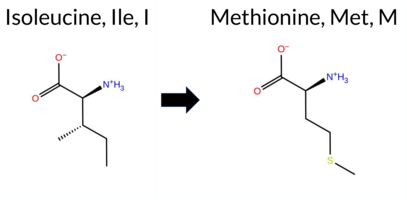 3DClick to see structure in 3D Viewer AISynGAP1 missense variant I584M is listed in ClinVar with an uncertain significance (ClinVar ID 1301269.0) and is present in gnomAD (6‑33440804‑C‑G). Consensus from multiple in‑silico predictors shows a split: benign calls come from REVEL, FoldX, Rosetta, Foldetta, SIFT, and AlphaMissense‑Optimized, whereas pathogenic calls arise from premPS, PROVEAN, polyPhen‑2 HumDiv, polyPhen‑2 HumVar, ESM1b, and FATHMM. The SGM Consensus, derived from a majority vote of AlphaMissense‑Default (uncertain), ESM1b, FATHMM, and PROVEAN, is pathogenic. High‑accuracy assessments further support a pathogenic interpretation: AlphaMissense‑Optimized predicts benign, but SGM Consensus is pathogenic, and Foldetta (combining FoldX‑MD and Rosetta) predicts benign. Overall, the majority of tools favor pathogenicity, and the high‑accuracy consensus leans pathogenic, indicating the variant is most likely pathogenic, which is consistent with the ClinVar uncertain status rather than contradicting it. Disclaimer: This summary was generated using AI and should be interpreted alongside expert review. | Likely Pathogenic | GAP | Uncertain | 2 | 6-33440804-C-G | 1 | 6.20e-7 | -10.119 | Likely Pathogenic | 0.419 | Ambiguous | Likely Benign | 0.478 | Likely Benign | 0.11 | Likely Benign | 0.1 | 0.46 | Likely Benign | 0.29 | Likely Benign | 1.16 | Destabilizing | -2.62 | Deleterious | 0.983 | Probably Damaging | 0.925 | Probably Damaging | -1.25 | Pathogenic | 0.12 | Tolerated | 3.37 | 34 | 2 | 1 | -2.6 | 18.03 | 247.5 | -20.3 | -0.1 | 0.3 | -0.1 | 0.1 | X | Potentially Benign | A hydrophobic residue, Ile584, located in an α helix (res. Glu582-Met603), is swapped for another hydrophobic residue, Met584. The sec-butyl hydrocarbon side chain of Ile584 packs hydrophobically with residues in an inter-helix hydrophobic space (e.g., Leu588, Met477, Val473, and Ile483).In the variant simulations, the thioether hydrophobic side chain of Met584 maintains similar interactions as Ile584 in the WT, as it is roughly the same size and fits well within the hydrophobic space. Thus, the residue swap does not appear to cause any negative effects on the protein structure. | ||||||||
| c.1767C>G | I589M 2D  3DClick to see structure in 3D Viewer AIThe SynGAP1 missense variant I589M is listed in ClinVar with an uncertain significance (ClinVar ID 964298.0) and is not reported in gnomAD. Functional prediction tools that provide a definitive call overwhelmingly predict a deleterious effect: REVEL, premPS, PROVEAN, polyPhen‑2 (HumDiv and HumVar), SIFT, ESM1b, FATHMM, and AlphaMissense‑Default all indicate pathogenicity, and the SGM Consensus (majority vote of AlphaMissense‑Default, ESM1b, FATHMM, PROVEAN) also reports a likely pathogenic outcome. Tools that are inconclusive—FoldX, Rosetta, Foldetta, and AlphaMissense‑Optimized—are listed as uncertain and do not influence the overall assessment. High‑accuracy methods specifically show AlphaMissense‑Optimized as uncertain, SGM Consensus as likely pathogenic, and Foldetta as uncertain. Taken together, the majority of available predictions support a pathogenic effect, which is consistent with the ClinVar uncertain designation rather than contradicting it. Disclaimer: This summary was generated using AI and should be interpreted alongside expert review. | Likely Pathogenic | GAP | Uncertain | 1 | -12.225 | Likely Pathogenic | 0.926 | Likely Pathogenic | Ambiguous | 0.830 | Likely Pathogenic | 0.74 | Ambiguous | 0.2 | 1.54 | Ambiguous | 1.14 | Ambiguous | 1.33 | Destabilizing | -2.99 | Deleterious | 1.000 | Probably Damaging | 1.000 | Probably Damaging | -1.94 | Pathogenic | 0.00 | Affected | 3.37 | 35 | 2 | 1 | -2.6 | 18.03 | 267.6 | -24.5 | 0.0 | 0.0 | -0.1 | 0.1 | X | Potentially Benign | A hydrophobic residue, Ile589, located in an α helix (res. Glu582-Met603), is swapped for another hydrophobic residue, methionine. The sec-butyl hydrocarbon side chain of Ile589 packs favourably with multiple residues in the inter-helix hydrophobic space (e.g., Phe569, Ile667, and Leu664).Although the S-methyl thioether group of the Met589 side chain in the variant is longer than the branched side chain of isoleucine, it stacks favourably with the aromatic phenol ring. Additionally, the polar sulphur atom forms a weak hydrogen bond with the guanidinium group of Arg573, which in turn forms a salt bridge with the carboxylate group of Asp586.Overall, the hydrophobic packing in the inter-helix space does not appear to be disrupted in the variant simulations. | |||||||||||
| c.1771G>A | A591T 2D  3DClick to see structure in 3D Viewer AIThe SynGAP1 missense variant A591T is listed in ClinVar with an uncertain significance designation and is observed in gnomAD (variant ID 6‑33440823‑G‑A). Functional prediction tools cluster into two groups: benign predictions come from REVEL, polyPhen‑2 HumVar, FATHMM, and AlphaMissense‑Optimized; pathogenic predictions come from premPS, PROVEAN, polyPhen‑2 HumDiv, SIFT, ESM1b, and AlphaMissense‑Default. The SGM Consensus, derived from a majority vote of AlphaMissense‑Default, ESM1b, FATHMM, and PROVEAN, reports a likely pathogenic outcome. High‑accuracy assessments further show AlphaMissense‑Optimized as benign, SGM Consensus as pathogenic, and Foldetta (combining FoldX‑MD and Rosetta outputs) as uncertain. No other folding‑stability metrics are available. Overall, the balance of evidence favors a pathogenic interpretation, which does not contradict the ClinVar uncertain status. Disclaimer: This summary was generated using AI and should be interpreted alongside expert review. | Likely Pathogenic | GAP | Conflicting | 3 | 6-33440823-G-A | 18 | 1.12e-5 | -9.572 | Likely Pathogenic | 0.704 | Likely Pathogenic | Likely Benign | 0.270 | Likely Benign | 1.61 | Ambiguous | 0.2 | 1.00 | Ambiguous | 1.31 | Ambiguous | 1.19 | Destabilizing | -3.40 | Deleterious | 0.955 | Possibly Damaging | 0.209 | Benign | 3.48 | Benign | 0.01 | Affected | 3.37 | 35 | 1 | 0 | -2.5 | 30.03 | 202.9 | -43.4 | 0.2 | 0.0 | 0.7 | 0.1 | X | Potentially Benign | The methyl group of the Ala591 side chain, located in the middle of an α helix (res. Glu582-Met603), packs against hydrophobic residues (e.g., Ile483, Phe484) of an opposing partially helical loop (res. Phe476-Asn487).In the variant simulations, the hydroxyl group of Thr591 can form hydrogen bonds with the backbone carbonyl of Ile843 in the opposing loop or the backbone carbonyl group of Arg587. These interactions could either reinforce the tertiary assembly or weaken the α helix unity. Additionally, the Thr591 side chain can hydrogen bond with the guanidinium group of the Arg587 side chain, potentially strengthening the α helix unity.Overall, the residue swap does not seem to cause any major negative effects on the protein structure. | ||||||||
| c.1792C>G | L598V 2D  3DClick to see structure in 3D Viewer AISynGAP1 missense variant L598V is listed in ClinVar with an uncertain significance and is not reported in gnomAD. Prediction tools that classify the variant as benign include REVEL, FATHMM, and AlphaMissense‑Optimized, whereas pathogenic predictions are made by premPS, PROVEAN, polyPhen‑2 (HumDiv and HumVar), SIFT, ESM1b, and AlphaMissense‑Default. The SGM Consensus, derived from a majority vote of AlphaMissense‑Default, ESM1b, FATHMM, and PROVEAN, indicates a likely pathogenic effect. High‑accuracy assessments show AlphaMissense‑Optimized as benign, SGM Consensus as likely pathogenic, and Foldetta (combining FoldX‑MD and Rosetta outputs) as inconclusive. Overall, the majority of evidence points to a pathogenic impact, which contrasts with the ClinVar designation of uncertain significance. Disclaimer: This summary was generated using AI and should be interpreted alongside expert review. | Likely Pathogenic | GAP | Uncertain | 1 | -10.002 | Likely Pathogenic | 0.578 | Likely Pathogenic | Likely Benign | 0.221 | Likely Benign | 1.89 | Ambiguous | 0.1 | 1.58 | Ambiguous | 1.74 | Ambiguous | 1.01 | Destabilizing | -2.92 | Deleterious | 0.944 | Possibly Damaging | 0.786 | Possibly Damaging | 3.21 | Benign | 0.02 | Affected | 3.37 | 35 | 2 | 1 | 0.4 | -14.03 | 218.4 | 29.6 | 0.0 | 0.0 | 0.8 | 0.0 | X | Potentially Benign | The iso-butyl side chain of Leu598, located on an α helix (res. Glu582-Met603), packs hydrophobically with other hydrophobic residues in the inter-helix space (e.g., Ile602, Phe594, Ile510).In the variant simulations, Val598, which has similar size and physicochemical properties to leucine, resides in the inter-helix hydrophobic space in a similar manner to Leu598 in the WT. This causes no negative effects on the protein structure. | |||||||||||
| c.1802C>T | A601V 2D  3DClick to see structure in 3D Viewer AIThe SynGAP1 missense variant A601V is listed in ClinVar (ID 968190.0) with an uncertain clinical significance and is not reported in gnomAD. Functional prediction tools cluster into two groups: benign predictions come from Rosetta and FATHMM, while pathogenic predictions are made by REVEL, PROVEAN, polyPhen‑2 (HumDiv and HumVar), SIFT, ESM1b, AlphaMissense‑Default, and the SGM‑Consensus score. Four tools (FoldX, Foldetta, premPS, AlphaMissense‑Optimized) give uncertain or inconclusive results. High‑accuracy assessments show AlphaMissense‑Optimized as uncertain, the SGM‑Consensus (majority vote of AlphaMissense‑Default, ESM1b, FATHMM, PROVEAN) as pathogenic, and Foldetta as uncertain. Overall, the majority of evidence points to a pathogenic effect, which is consistent with the ClinVar designation of uncertain significance rather than contradicting it. Disclaimer: This summary was generated using AI and should be interpreted alongside expert review. | Likely Pathogenic | GAP | Uncertain | 1 | -10.447 | Likely Pathogenic | 0.853 | Likely Pathogenic | Ambiguous | 0.535 | Likely Pathogenic | 1.64 | Ambiguous | 0.1 | 0.35 | Likely Benign | 1.00 | Ambiguous | 0.81 | Ambiguous | -3.98 | Deleterious | 1.000 | Probably Damaging | 0.989 | Probably Damaging | 2.74 | Benign | 0.03 | Affected | 3.37 | 35 | 0 | 0 | 2.4 | 28.05 | 228.5 | -45.5 | 0.0 | 0.0 | 0.4 | 0.5 | X | Potentially Benign | The methyl side chain of Ala601, located on an α helix (res. Glu582-Met603), packs hydrophobically against other hydrophobic residues in the inter-helix space (e.g., Phe597, Leu598, Leu506, Phe608).In the variant simulations, Val601, which has similar size and physicochemical properties to alanine, resides in the inter-helix hydrophobic space in a similar manner to Ala601 in the WT, causing no apparent negative effect on the protein structure. However, the effect of the residue swap on the SynGAP-Ras complex formation or GTPase activation cannot be fully addressed using the SynGAP solvent-only simulations. | |||||||||||
| c.1819C>G | L607V 2D  3DClick to see structure in 3D Viewer AISynGAP1 missense variant L607V is listed in ClinVar with an uncertain significance (ClinVar ID 1450275.0) and is present in gnomAD (ID 6‑33440871‑C‑G). Prediction tools that agree on a benign effect include only AlphaMissense‑Optimized. All other evaluated algorithms—REVEL, PROVEAN, polyPhen‑2 (HumDiv and HumVar), SIFT, ESM1b, FATHMM, AlphaMissense‑Default, and the SGM‑Consensus (majority vote of AlphaMissense‑Default, ESM1b, FATHMM, PROVEAN)—predict a pathogenic impact. High‑accuracy assessments further support this: AlphaMissense‑Optimized reports benign, whereas the SGM‑Consensus, derived from the majority of pathogenic predictions, indicates pathogenic. Foldetta, which integrates FoldX‑MD and Rosetta outputs, is inconclusive and therefore not considered evidence. Overall, the preponderance of computational evidence points to a pathogenic effect for L607V, a conclusion that contrasts with the current ClinVar uncertain status. Disclaimer: This summary was generated using AI and should be interpreted alongside expert review. | Likely Pathogenic | GAP | Uncertain | 2 | 6-33440871-C-G | 2 | 1.24e-6 | -11.190 | Likely Pathogenic | 0.637 | Likely Pathogenic | Likely Benign | 0.715 | Likely Pathogenic | 1.04 | Ambiguous | 0.2 | 1.36 | Ambiguous | 1.20 | Ambiguous | 0.90 | Ambiguous | -2.99 | Deleterious | 0.985 | Probably Damaging | 0.992 | Probably Damaging | -1.50 | Pathogenic | 0.01 | Affected | 3.37 | 35 | 2 | 1 | 0.4 | -14.03 | 216.3 | 28.1 | 0.1 | 0.0 | 0.9 | 0.2 | X | Potentially Benign | Leu607 is located in a short helical region (res. Ser606-Phe608) within an α-α loop connecting two α helices (res. Glu582-Met603 and res. Glu617-Asn635). In the WT simulations, the iso-butyl side chain of Leu607 does not interact with any other residues, but it could potentially interact directly with Ras due to its location at the GAP domain.In the variant simulations, Val607, which has similar size and physicochemical properties to leucine, does not cause any negative effects on the protein structure. However, due to its location at the GAP-Ras interface, the residue swap could affect the complex formation with the GTPase, but this cannot be investigated using solvent-only simulations. | ||||||||
| c.1888A>G | I630V 2D  3DClick to see structure in 3D Viewer AIThe SynGAP1 missense variant I630V is listed in ClinVar as Benign and is present in gnomAD (variant ID 6‑33440940‑A‑G). Functional prediction tools that agree on a benign effect include REVEL, PROVEAN, polyPhen‑2 (HumDiv and HumVar), SIFT, AlphaMissense‑Default, and AlphaMissense‑Optimized. Only FATHMM predicts a pathogenic outcome; all other tools (FoldX, Rosetta, Foldetta, premPS, ESM1b) return uncertain or inconclusive results. The high‑accuracy consensus (SGM Consensus) derived from AlphaMissense‑Default, ESM1b, FATHMM, and PROVEAN yields a benign majority (2 benign vs. 1 pathogenic, 1 uncertain). AlphaMissense‑Optimized also predicts benign. Foldetta, which integrates FoldX‑MD and Rosetta stability calculations, is uncertain. Taken together, the overwhelming majority of predictions support a benign effect, and this conclusion aligns with the ClinVar designation. Thus, the variant is most likely benign, with no contradiction to the ClinVar status. Disclaimer: This summary was generated using AI and should be interpreted alongside expert review. | GAP | Benign/Likely benign | 4 | 6-33440940-A-G | 59 | 3.66e-5 | -7.264 | In-Between | 0.145 | Likely Benign | Likely Benign | 0.143 | Likely Benign | 1.33 | Ambiguous | 0.0 | 0.94 | Ambiguous | 1.14 | Ambiguous | 0.64 | Ambiguous | -0.38 | Neutral | 0.018 | Benign | 0.011 | Benign | -1.37 | Pathogenic | 0.35 | Tolerated | 3.37 | 34 | 4 | 3 | -0.3 | -14.03 | 235.0 | 26.2 | -0.1 | 0.0 | -0.3 | 0.1 | X | Potentially Benign | The sec-butyl side chain of Ile630, located in an α helix (res. Glu617-Asn635), packs with hydrophobic residues (e.g., Phe594, Leu633, Ile626, Ile602) in the hydrophobic inter-helix space between two α helices (res. Glu617-Asn635 and res. Glu582-Met603).In the variant simulations, the iso-propyl side chain of Val630, which shares a similar size and physicochemical properties with Ile630 in the WT, maintains similar interactions in the inter-helix space. Although no negative structural effects are observed during the simulations, the implications of the residue swap on the complex formation with the GTPase, due to its location, cannot be investigated using solvent-only simulations. | |||||||||
| c.1947G>C | M649I 2D  3DClick to see structure in 3D Viewer AIThe SynGAP1 missense variant M649I is listed in ClinVar with an “Uncertain” status and is not reported in gnomAD. Prediction tools that indicate a benign effect include REVEL, polyPhen‑2 HumVar, and FATHMM, whereas the majority of other in silico predictors (FoldX, Foldetta, premPS, PROVEAN, polyPhen‑2 HumDiv, SIFT, ESM1b, AlphaMissense‑Default, AlphaMissense‑Optimized) report a pathogenic outcome; Rosetta is inconclusive. High‑accuracy assessments further support a deleterious impact: AlphaMissense‑Optimized predicts pathogenicity, the SGM Consensus (majority vote of AlphaMissense‑Default, ESM1b, FATHMM, PROVEAN) is “Likely Pathogenic,” and Foldetta (combining FoldX‑MD and Rosetta outputs) also predicts pathogenicity. Overall, the preponderance of evidence points to a pathogenic effect for M649I, which is consistent with the ClinVar “Uncertain” classification rather than contradicting it. Disclaimer: This summary was generated using AI and should be interpreted alongside expert review. | Likely Pathogenic | GAP | Uncertain | 1 | -9.361 | Likely Pathogenic | 0.995 | Likely Pathogenic | Likely Pathogenic | 0.449 | Likely Benign | 2.42 | Destabilizing | 0.2 | 1.96 | Ambiguous | 2.19 | Destabilizing | 1.01 | Destabilizing | -3.99 | Deleterious | 0.672 | Possibly Damaging | 0.093 | Benign | 3.40 | Benign | 0.02 | Affected | 3.38 | 27 | 2 | 1 | 2.6 | -18.03 | 243.7 | 21.5 | 0.0 | 0.1 | 0.0 | 0.1 | X | Potentially Benign | The thioether side chain of Met649, located on an α helix (res. Ser641-Glu666), bridges Phe652, Phe648, and Phe639 in an inter-helix hydrophobic cavity in the WT simulations. In the variant simulations, the sec-butyl side chain of Ile649 maintains hydrophobic interactions with nearby residues, with no significant effects on the protein structure.However, methionine is known as a bridging motif for aromatic residues, and these Met-aromatic interactions are lost in the variant. Indeed, in the second variant simulation,the bridging of Phe652, Phe648 and Phe639 is completely lost. In reality, the effect could be more severe on the structure during the protein folding. | |||||||||||
| c.1964T>A | L655Q 2D 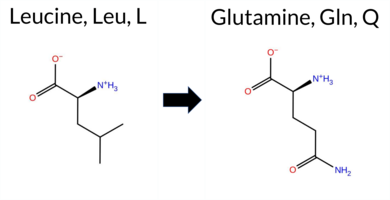 3DClick to see structure in 3D Viewer AIThe SynGAP1 missense variant L655Q is listed in ClinVar with an uncertain significance and is not reported in gnomAD. Functional prediction tools largely agree on a benign effect: REVEL, FoldX, Foldetta, premPS, PROVEAN, SIFT, ESM1b, FATHMM, AlphaMissense‑Default, AlphaMissense‑Optimized, and the SGM‑Consensus (majority vote of AlphaMissense‑Default, ESM1b, FATHMM, PROVEAN) all indicate benign or likely benign. Only the two polyPhen‑2 implementations (HumDiv and HumVar) predict pathogenicity, while Rosetta remains inconclusive. High‑accuracy assessments reinforce the benign consensus: AlphaMissense‑Optimized scores benign, the SGM‑Consensus is likely benign, and Foldetta (combining FoldX‑MD and Rosetta outputs) predicts benign stability. Overall, the majority of evidence supports a benign impact for L655Q, which does not contradict the ClinVar uncertain status. Disclaimer: This summary was generated using AI and should be interpreted alongside expert review. | Likely Benign | GAP | Uncertain | 1 | -5.278 | Likely Benign | 0.144 | Likely Benign | Likely Benign | 0.139 | Likely Benign | -0.01 | Likely Benign | 0.0 | 0.69 | Ambiguous | 0.34 | Likely Benign | -0.15 | Likely Benign | 0.61 | Neutral | 0.955 | Possibly Damaging | 0.602 | Possibly Damaging | 3.59 | Benign | 0.65 | Tolerated | 3.39 | 24 | -2 | -2 | -7.3 | 14.97 | 229.9 | -8.6 | 0.0 | 0.0 | 0.4 | 0.0 | X | Potentially Benign | The iso-butyl side chain of Leu655, located on the surface of an α helix (res. Ser641-Glu666), is not involved in any interactions in the WT simulations. In the variant simulations, the carboxamide side chain of Gln655 dynamically interacts with neighboring residues (e.g., Glu651, Glu656, Arg544) on the protein surface, with no negative structural effects. | |||||||||||
| c.1966G>C | E656Q 2D 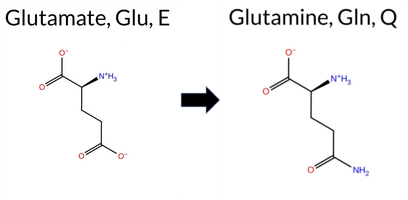 3DClick to see structure in 3D Viewer AIThe SynGAP1 missense variant E656Q is listed in ClinVar with an uncertain significance and is present in gnomAD (ID 6‑33441225‑G‑C). Functional prediction tools that agree on a benign effect include REVEL, FoldX, Foldetta, premPS, PROVEAN, FATHMM, and AlphaMissense‑Optimized. Tools that predict a pathogenic outcome are polyPhen‑2 HumDiv, polyPhen‑2 HumVar, SIFT, ESM1b, and AlphaMissense‑Default; Rosetta reports an uncertain result. High‑accuracy assessments show AlphaMissense‑Optimized as benign, Foldetta as benign, while the SGM Consensus (majority vote of AlphaMissense‑Default, ESM1b, FATHMM, PROVEAN) is inconclusive due to a 2‑2 split. Overall, the majority of evidence points to a benign effect, and this conclusion does not contradict the ClinVar uncertain status. Disclaimer: This summary was generated using AI and should be interpreted alongside expert review. | GAP | Uncertain | 1 | 6-33441225-G-C | 1 | 6.20e-7 | -9.145 | Likely Pathogenic | 0.766 | Likely Pathogenic | Likely Benign | 0.249 | Likely Benign | -0.14 | Likely Benign | 0.0 | -0.81 | Ambiguous | -0.48 | Likely Benign | 0.25 | Likely Benign | -2.29 | Neutral | 0.980 | Probably Damaging | 0.528 | Possibly Damaging | 3.46 | Benign | 0.02 | Affected | 3.39 | 24 | 2 | 2 | 0.0 | -0.98 | 224.3 | 1.7 | 0.0 | 0.1 | 0.1 | 0.0 | X | Potentially Benign | The carboxylate side chain of Glu656, located on an α helix (res. Ser641-Glu666), frequently forms a hydrogen bond with the nearby residue Ser659 on the same α helix. In the variant simulations, the carboxamide side chain of Gln656 alternatively forms a hydrogen bond with either Ser659 or Glu548 on an opposing helix (res. Ala533-Val560).Although the frequent interaction between Gln656 and Glu548 may strengthen or stabilize the tertiary structure assembly, the effect is likely to be marginal. | |||||||||
| c.1976C>T | S659F 2D  3DClick to see structure in 3D Viewer AIThe SynGAP1 missense variant S659F is listed in ClinVar with an uncertain significance and is absent from gnomAD. Functional prediction tools that provide definitive calls cluster into two groups: benign predictions come from REVEL, Rosetta, premPS, polyPhen2_HumVar, FATHMM, and AlphaMissense‑Optimized; pathogenic predictions come from PROVEAN, polyPhen2_HumDiv, SIFT, ESM1b, AlphaMissense‑Default, and the SGM Consensus (majority vote of AlphaMissense‑Default, ESM1b, FATHMM, and PROVEAN). High‑accuracy assessments show AlphaMissense‑Optimized predicts benign, SGM Consensus predicts pathogenic, and Foldetta (which integrates FoldX‑MD and Rosetta outputs) yields an uncertain result and is therefore unavailable. Overall, the majority of reliable tools favor a pathogenic effect. Thus, the variant is most likely pathogenic, a conclusion that does not contradict the ClinVar uncertain status. Disclaimer: This summary was generated using AI and should be interpreted alongside expert review. | Likely Pathogenic | GAP | Uncertain | 1 | -10.925 | Likely Pathogenic | 0.662 | Likely Pathogenic | Likely Benign | 0.194 | Likely Benign | -0.81 | Ambiguous | 0.1 | -0.25 | Likely Benign | -0.53 | Ambiguous | 0.32 | Likely Benign | -4.59 | Deleterious | 0.806 | Possibly Damaging | 0.171 | Benign | 3.39 | Benign | 0.05 | Affected | 3.38 | 28 | -3 | -2 | 3.6 | 60.10 | 221.3 | -61.2 | 0.0 | 0.0 | 0.6 | 0.4 | X | Potentially Benign | In the WT simulations, the hydroxyl group of Ser659, located in a kink in the middle of the long α-helix (res. Ser641-Glu666), forms a hydrogen bond with the carboxylate group of Glu656. However, the phenol ring of the Phe659 side chain cannot form a similar hydrogen bond. Instead, it interacts with the hydrophobic isopropyl side chain of Val555 from the opposing α-helix (res. Ala533-Val560). This residue swap may therefore cause issues during protein folding. | |||||||||||
| c.1991T>C | L664S 2D  3DClick to see structure in 3D Viewer AIThe SynGAP1 missense variant L664S is listed in ClinVar as Benign (ClinVar ID 2429773.0) and is present in gnomAD (ID 6‑33441250‑T‑C). Prediction tools that report a benign effect include only FATHMM; all other evaluated algorithms (REVEL, FoldX, Rosetta, Foldetta, premPS, PROVEAN, polyPhen‑2 HumDiv, polyPhen‑2 HumVar, SIFT, ESM1b, AlphaMissense‑Default, AlphaMissense‑Optimized) predict a pathogenic impact, and the SGM‑Consensus score is “Likely Pathogenic.” High‑accuracy methods give the following results: AlphaMissense‑Optimized predicts Pathogenic; the SGM Consensus (majority vote of AlphaMissense‑Default, ESM1b, FATHMM, PROVEAN) also yields Pathogenic; and Foldetta (combining FoldX‑MD and Rosetta outputs) predicts Pathogenic. Based on the overwhelming majority of pathogenic predictions—including the high‑accuracy tools—the variant is most likely pathogenic, which contradicts its ClinVar benign classification. Disclaimer: This summary was generated using AI and should be interpreted alongside expert review. | Likely Pathogenic | GAP | Likely Benign | 1 | 6-33441250-T-C | 1 | 6.20e-7 | -16.498 | Likely Pathogenic | 0.997 | Likely Pathogenic | Likely Pathogenic | 0.543 | Likely Pathogenic | 3.75 | Destabilizing | 0.2 | 3.63 | Destabilizing | 3.69 | Destabilizing | 2.77 | Destabilizing | -5.99 | Deleterious | 1.000 | Probably Damaging | 0.996 | Probably Damaging | 2.85 | Benign | 0.00 | Affected | 3.38 | 28 | -3 | -2 | -4.6 | -26.08 | 215.5 | 50.1 | 0.0 | 0.0 | -0.2 | 0.2 | X | Potentially Benign | The iso-butyl side chain of L664, located on an α-helix (res. Ser641-Glu666), hydrophobically interacts with residues in the inter-helix space between three helices (res. Glu617-Asn635, res. Glu582-Met603, and res. Ser641-Glu666), such as Ile589, Phe663, and Met660. In the variant simulations, the hydroxyl group of Ser664 forms hydrogen bonds with the backbone carbonyl oxygen of another helix residue, such as Met660 or Gln661. This interaction is known to destabilize hydrogen bonding in the α-helix, but this effect was not observed in the simulations. Additionally, Ser664 occasionally forms hydrogen bonds with the carboxylate group of Asp586 on another α-helix (res. Glu582-Met603), which could minimally influence the tertiary structure assembly. Despite these interactions, no major negative effects on the protein structure were observed during the simulations. | ||||||||
| c.2047A>G | I683V 2D  3DClick to see structure in 3D Viewer AIThe SynGAP1 missense variant I683V is listed in ClinVar with an uncertain significance and is present in gnomAD (6‑33441306‑A‑G). Across a panel of in silico predictors, the majority indicate a benign effect: REVEL, PROVEAN, polyPhen‑2 HumVar, SIFT, FATHMM, AlphaMissense‑Default, AlphaMissense‑Optimized, and the SGM‑Consensus (derived from a majority of AlphaMissense‑Default, ESM1b, FATHMM, and PROVEAN). Only polyPhen‑2 HumDiv classifies the change as pathogenic. High‑accuracy assessments further support a benign outcome: AlphaMissense‑Optimized is benign, the SGM‑Consensus (majority vote) is benign, and Foldetta, which integrates FoldX‑MD and Rosetta stability predictions, is inconclusive and therefore not considered evidence. No other tool provides a pathogenic signal. Consequently, the variant is most likely benign, and this assessment does not contradict the ClinVar uncertain status. Disclaimer: This summary was generated using AI and should be interpreted alongside expert review. | Likely Benign | GAP | Uncertain | 1 | 6-33441306-A-G | 2 | 1.24e-6 | -7.588 | In-Between | 0.138 | Likely Benign | Likely Benign | 0.112 | Likely Benign | 0.90 | Ambiguous | 0.0 | 0.60 | Ambiguous | 0.75 | Ambiguous | 0.76 | Ambiguous | -0.78 | Neutral | 0.538 | Possibly Damaging | 0.080 | Benign | 3.35 | Benign | 0.14 | Tolerated | 3.42 | 17 | 4 | 3 | -0.3 | -14.03 | 215.6 | 29.1 | 0.0 | 0.0 | -0.7 | 0.1 | X | Potentially Benign | The sec-butyl side chain of Ile683, located in an entangled α-α loop connecting the two α-helices (res. Ser641-Glu666 and res. Leu685-Val699), is sterically packed against His453 and Glu688. In the variant simulations, the iso-propyl side chain of Val683 has similar size and physicochemical properties as Ile630 in the WT, and thus, it is able to maintain similar interactions in the inter-helix space. Consequently, no negative structural effects are observed during the simulations due to the residue swap. | ||||||||
| c.2089T>C | W697R 2D  3DClick to see structure in 3D Viewer AIThe SynGAP1 missense variant W697R is listed in ClinVar as Benign (ClinVar ID 703213.0) and is present in the gnomAD database (gnomAD ID 6‑33441348‑T‑C). Functional prediction tools that agree on a benign effect include REVEL and FATHMM, whereas a majority of tools predict a pathogenic impact: premPS, PROVEAN, polyPhen‑2 (HumDiv and HumVar), SIFT, ESM1b, AlphaMissense‑Default, and the SGM‑Consensus score. Predictions that are inconclusive or unavailable are FoldX, Rosetta, Foldetta, and AlphaMissense‑Optimized. High‑accuracy assessments show AlphaMissense‑Optimized as uncertain, the SGM‑Consensus (majority vote from AlphaMissense‑Default, ESM1b, FATHMM, PROVEAN) as pathogenic, and Foldetta (combining FoldX‑MD and Rosetta outputs) as uncertain. Overall, the preponderance of evidence from multiple pathogenic‑predicting tools suggests that the variant is most likely pathogenic, which contradicts its current ClinVar benign classification. Disclaimer: This summary was generated using AI and should be interpreted alongside expert review. | Likely Pathogenic | GAP | Likely Benign | 1 | 6-33441348-T-C | 1 | 6.20e-7 | -10.020 | Likely Pathogenic | 0.941 | Likely Pathogenic | Ambiguous | 0.401 | Likely Benign | 1.14 | Ambiguous | 0.1 | 1.18 | Ambiguous | 1.16 | Ambiguous | 1.25 | Destabilizing | -9.50 | Deleterious | 1.000 | Probably Damaging | 0.994 | Probably Damaging | 3.45 | Benign | 0.02 | Affected | 3.46 | 13 | 2 | -3 | -3.6 | -30.03 | 254.4 | -41.2 | 0.0 | 0.0 | -0.7 | 0.0 | X | Potentially Benign | The indole ring of Trp697, located on the outer surface of an α-helix (res. Leu685-Val699), is not involved in any long-lasting interactions in the WT simulations. In the variant simulations, the positively charged guanidinium side chain of Arg697 occasionally forms hydrogen bonds with nearby residues, such as Ser722 and Asn719. However, similar to Trp697 in the WT, Arg697 does not form any long-lasting interactions and thus does not induce any negative structural effects in the simulations. | ||||||||
| c.2095G>A | V699M 2D  3DClick to see structure in 3D Viewer AISynGAP1 variant V699M is listed in ClinVar with an uncertain significance and is present in gnomAD (ID 6‑33441354‑G‑A). Across in silico predictors, benign calls are made by REVEL, Rosetta, Foldetta, PROVEAN, FATHMM, and AlphaMissense‑Optimized, whereas pathogenic calls come from polyPhen‑2 HumDiv, polyPhen‑2 HumVar, SIFT, and ESM1b. Predictions that are inconclusive (FoldX, premPS, AlphaMissense‑Default) are noted but not used as evidence. High‑accuracy assessments further support a benign outcome: AlphaMissense‑Optimized predicts benign, the SGM Consensus (majority vote of AlphaMissense‑Default, ESM1b, FATHMM, PROVEAN) also yields benign, and Foldetta (combining FoldX‑MD and Rosetta outputs) reports benign stability. Overall, the preponderance of evidence indicates the variant is most likely benign, which does not contradict the ClinVar uncertain status but provides a stronger leaning toward benignity. Disclaimer: This summary was generated using AI and should be interpreted alongside expert review. | GAP | Uncertain | 2 | 6-33441354-G-A | 8 | 4.96e-6 | -8.869 | Likely Pathogenic | 0.484 | Ambiguous | Likely Benign | 0.276 | Likely Benign | -0.58 | Ambiguous | 0.1 | 0.29 | Likely Benign | -0.15 | Likely Benign | 0.96 | Ambiguous | -2.18 | Neutral | 0.994 | Probably Damaging | 0.806 | Possibly Damaging | 3.37 | Benign | 0.03 | Affected | 3.47 | 10 | 2 | 1 | -2.3 | 32.06 | 257.8 | -47.2 | 0.0 | 0.0 | 0.9 | 0.1 | X | Potentially Benign | The isopropyl side chain of Val699, located on an α-helix (res. Leu685-Gln702), packs against hydrophobic residues (e.g., Leu703, Leu696, Leu435, Leu439) in the inter-helix space. In the variant simulations, the thioether side chain of Met699 has similar physicochemical properties to Val699 in the WT, and thus, it is able to maintain similar interactions. Consequently, the mutation causes no apparent changes in the structure. | |||||||||
| c.2111G>A | S704N 2D  3DClick to see structure in 3D Viewer AIThe SynGAP1 missense variant S704N is listed in ClinVar as benign (ClinVar ID 962301.0) and is present in gnomAD (ID 6‑33441370‑G‑A). Functional prediction tools largely agree on a benign effect: REVEL, FoldX, Rosetta, Foldetta, PROVEAN, polyPhen‑2 HumVar, SIFT, ESM1b, FATHMM, AlphaMissense‑Optimized, and the SGM‑Consensus all report benign or likely benign. Only polyPhen‑2 HumDiv predicts a pathogenic outcome, while premPS and AlphaMissense‑Default are uncertain. High‑accuracy assessments reinforce the benign consensus: AlphaMissense‑Optimized scores benign, the SGM‑Consensus (majority vote of AlphaMissense‑Default, ESM1b, FATHMM, PROVEAN) is likely benign, and Foldetta (combining FoldX‑MD and Rosetta outputs) indicates benign stability. Overall, the predictions support a benign classification, consistent with the ClinVar status and with no contradiction. Disclaimer: This summary was generated using AI and should be interpreted alongside expert review. | Likely Benign | GAP | Benign/Likely benign | 3 | 6-33441370-G-A | 27 | 1.67e-5 | -5.917 | Likely Benign | 0.421 | Ambiguous | Likely Benign | 0.058 | Likely Benign | 0.48 | Likely Benign | 0.1 | -0.12 | Likely Benign | 0.18 | Likely Benign | 0.54 | Ambiguous | -0.49 | Neutral | 0.771 | Possibly Damaging | 0.275 | Benign | 3.39 | Benign | 0.08 | Tolerated | 3.47 | 10 | 1 | 1 | -2.7 | 27.03 | 233.2 | -29.1 | -0.1 | 0.0 | -0.1 | 0.1 | X | Potentially Benign | Ser704 is located at the end and outer surface of an α-helix (res. Thr704-Gly712), which is connected via a tight turn or loop to another α-helix (res. Asp684-Gln702). The hydroxyl side chain of Ser704 occasionally forms a hydrogen bond with the amide group of Ala707. However, in the variant simulations, the carboxamide side chain of Asn704 achieves more lasting and numerous hydrogen-bonding interactions with the residues at the helix end, such as Glu706, Ala707, and Leu708. Consequently, the residue swap could strengthen the α-helix secondary structure integrity at the helix end, which could have either positive or negative effects on its function. | ||||||||
| c.2111G>C | S704T 2D  3DClick to see structure in 3D Viewer AIThe SynGAP1 missense variant S704T is listed in ClinVar with an uncertain significance and is not reported in gnomAD. Consensus from multiple in‑silico predictors shows a predominance of benign calls: REVEL, Rosetta, Foldetta, premPS, PROVEAN, polyPhen‑2 HumVar, SIFT, ESM1b, FATHMM, AlphaMissense‑Default, AlphaMissense‑Optimized, and the SGM‑Consensus. Only polyPhen‑2 HumDiv predicts a pathogenic effect, while FoldX remains inconclusive. High‑accuracy assessments further support a benign outcome: AlphaMissense‑Optimized is benign; the SGM‑Consensus (majority vote of AlphaMissense‑Default, ESM1b, FATHMM, PROVEAN) is benign; and Foldetta, which integrates FoldX‑MD and Rosetta stability calculations, also predicts benign. Overall, the aggregate evidence indicates that S704T is most likely benign, which is consistent with its ClinVar uncertain status rather than contradicting it. Disclaimer: This summary was generated using AI and should be interpreted alongside expert review. | Likely Benign | GAP | Uncertain | 1 | -4.930 | Likely Benign | 0.265 | Likely Benign | Likely Benign | 0.071 | Likely Benign | 0.80 | Ambiguous | 0.0 | 0.15 | Likely Benign | 0.48 | Likely Benign | 0.29 | Likely Benign | -1.72 | Neutral | 0.525 | Possibly Damaging | 0.107 | Benign | 3.45 | Benign | 0.07 | Tolerated | 3.47 | 10 | 1 | 1 | 0.1 | 14.03 | 201.7 | -18.0 | 0.0 | 0.0 | -0.2 | 0.7 | X | Potentially Benign | Ser704 is located at the end and outer surface of an α-helix (res. Thr704-Gly712), which is connected via a tight turn or loop to another α-helix (res. Asp684-Gln702). The hydroxyl side chain of Ser704 occasionally forms a hydrogen bond with the amide group of Ala707. Similarly, in the variant simulations, the hydroxyl side chain of Thr704 forms hydrogen bonds with the amide groups of Ala707 and Leu708. Thus, the residue swap does not cause any apparent structural change. | |||||||||||
| c.707C>T | A236V 2D  3DClick to see structure in 3D Viewer AISynGAP1 missense variant A236V is listed in ClinVar as Benign (ID 469162.0) and is present in gnomAD (6‑33435558‑C‑T). Prediction tools that report benign include polyPhen‑2 HumVar, FATHMM, AlphaMissense‑Default, and AlphaMissense‑Optimized. Tools that predict pathogenicity are REVEL, PROVEAN, polyPhen‑2 HumDiv, SIFT, and ESM1b. Four tools give uncertain or inconclusive results: FoldX, Rosetta, Foldetta, and premPS. The SGM Consensus, derived from a majority vote of AlphaMissense‑Default, ESM1b, FATHMM, and PROVEAN, is inconclusive because the votes are evenly split. High‑accuracy assessments show AlphaMissense‑Optimized as benign, Foldetta as uncertain, and the SGM Consensus as unavailable. Consequently, the overall prediction profile is mixed, but the most reliable high‑accuracy evidence points toward a benign effect. Therefore, the variant is most likely benign, which aligns with its ClinVar classification and does not contradict the reported status. Disclaimer: This summary was generated using AI and should be interpreted alongside expert review. | PH | Benign/Likely benign | 2 | 6-33435558-C-T | 6 | 3.72e-6 | -8.752 | Likely Pathogenic | 0.267 | Likely Benign | Likely Benign | 0.777 | Likely Pathogenic | 0.61 | Ambiguous | 0.2 | 1.08 | Ambiguous | 0.85 | Ambiguous | 0.64 | Ambiguous | -3.55 | Deleterious | 0.981 | Probably Damaging | 0.446 | Benign | 5.79 | Benign | 0.03 | Affected | 3.40 | 14 | 0 | 0 | 2.4 | 28.05 | 213.8 | -44.7 | 0.0 | 0.0 | -0.2 | 0.2 | X | Potentially Benign | The methyl side chain of Ala236, located on an α helix (residues Ala236-Val250) facing an anti-parallel β sheet strand (residues Ile205-Val209), interacts hydrophobically with nearby residues such as Arg239 and Phe218. In the variant simulations, the isopropyl branched hydrocarbon side chain of Val236 maintains similar hydrophobic interactions as alanine in the WT, with an overall arrangement remarkably similar to Ala236. The residue swap does not affect the protein structure based on the simulations. | |||||||||
| c.745G>A | A249T 2D  3DClick to see structure in 3D Viewer AISynGAP1 missense variant A249T is listed in ClinVar (ID 1031675.0) with an uncertain significance annotation and is not reported in gnomAD. Functional prediction tools that agree on a benign effect include REVEL, premPS, PROVEAN, SIFT, ESM1b, and FATHMM, whereas polyPhen‑2 HumDiv, polyPhen‑2 HumVar, and AlphaMissense‑Default predict a pathogenic outcome. Predictions that are inconclusive are FoldX, Rosetta, Foldetta, and AlphaMissense‑Optimized. High‑accuracy assessments show AlphaMissense‑Optimized as uncertain, the SGM Consensus (majority vote of AlphaMissense‑Default, ESM1b, FATHMM, PROVEAN) as likely benign, and Foldetta (combining FoldX‑MD and Rosetta) as uncertain. Overall, the balance of evidence favors a benign interpretation, which does not contradict the ClinVar uncertain status. Disclaimer: This summary was generated using AI and should be interpreted alongside expert review. | Likely Benign | PH | Uncertain | 1 | -3.564 | Likely Benign | 0.805 | Likely Pathogenic | Ambiguous | 0.487 | Likely Benign | 1.50 | Ambiguous | 0.6 | 1.39 | Ambiguous | 1.45 | Ambiguous | 0.30 | Likely Benign | -0.96 | Neutral | 0.990 | Probably Damaging | 0.815 | Possibly Damaging | 5.65 | Benign | 0.40 | Tolerated | 3.39 | 15 | 1 | 0 | -2.5 | 30.03 | 214.5 | -43.3 | 0.0 | 0.0 | 0.5 | 0.2 | X | Potentially Benign | The methyl group of Ala249, located on the surface of an α helix (res. Ala236-Val250) facing an anti-parallel β sheet strand (res. Ile205-Val209), packs against nearby hydrophobic residues such as Leu200, Leu246, and Val250. In the variant simulations, the hydroxyl group of Thr249, which is not suitable for hydrophobic packing, forms a stable hydrogen bond with the backbone carbonyl of Asn245 in the same helix. Although this interaction could theoretically weaken the structural integrity of the α helix, this destabilizing effect is not observed in the variant simulations. | |||||||||||
| c.819G>T | E273D 2D  3DClick to see structure in 3D Viewer AIThe SynGAP1 missense variant E273D is listed in ClinVar as Benign (ClinVar ID 1471608.0) and is present in gnomAD (variant ID 6‑33437724‑G‑T). Prediction tools that agree on a benign effect include REVEL, FoldX, Rosetta, Foldetta, PROVEAN, polyPhen‑2 (HumDiv and HumVar), SIFT, ESM1b, AlphaMissense‑Default, and AlphaMissense‑Optimized. Only FATHMM predicts a pathogenic outcome, while premPS is uncertain. The SGM‑Consensus, derived from a majority vote of AlphaMissense‑Default, ESM1b, FATHMM, and PROVEAN, is Likely Benign. High‑accuracy assessments are consistent: AlphaMissense‑Optimized predicts benign, the SGM‑Consensus (majority vote) is benign, and Foldetta (combining FoldX‑MD and Rosetta outputs) also predicts benign. No prediction contradicts the ClinVar benign status; overall, the evidence strongly supports that E273D is most likely benign. Disclaimer: This summary was generated using AI and should be interpreted alongside expert review. | Likely Benign | C2 | Benign | 1 | 6-33437724-G-T | 2 | 1.24e-6 | -1.811 | Likely Benign | 0.058 | Likely Benign | Likely Benign | 0.092 | Likely Benign | 0.26 | Likely Benign | 0.1 | -0.48 | Likely Benign | -0.11 | Likely Benign | -0.63 | Ambiguous | 1.99 | Neutral | 0.004 | Benign | 0.010 | Benign | 2.00 | Pathogenic | 1.00 | Tolerated | 3.38 | 18 | 3 | 2 | 0.0 | -14.03 | 223.1 | 22.1 | 0.2 | 0.0 | 0.0 | 0.1 | X | Potentially Benign | The negatively charged residue Glu273, located in a β hairpin loop (res. Glu273-Lys278) that connects two anti-parallel β sheet strands, is replaced with another negatively charged residue, aspartate. Because the C2 domain loop faces the membrane surface, the potentially crucial role of the carboxylate group of Glu273 or Asp273 on SynGAP-membrane association cannot be fully explored via solvent-only simulations.As a minor note, the neighboring residue Arg272, which stacks with the indole ring of the Trp362 side chain and directly faces RasGTPase, forms a salt bridge more often with Asp273 than with the non-mutated Glu273 in the simulations. Regardless, due to the similar physicochemical properties of the WT and variant residues at the membrane interface, the residue swap is likely to be well tolerated. | ||||||||
| c.844T>A | C282S 2D 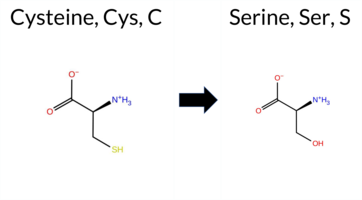 3DClick to see structure in 3D Viewer AIThe SynGAP1 missense variant C282S is listed in ClinVar with an “Uncertain” status and is not reported in gnomAD. Prediction tools that indicate a benign effect include REVEL, whereas the majority of other in‑silico predictors (premPS, PROVEAN, polyPhen‑2 HumDiv, polyPhen‑2 HumVar, SIFT, ESM1b, FATHMM, AlphaMissense‑Default, AlphaMissense‑Optimized, and the SGM‑Consensus) all classify the variant as pathogenic. Stability‑based methods (FoldX, Rosetta, and Foldetta) return uncertain results and are therefore not considered evidence for or against pathogenicity. High‑accuracy assessments show AlphaMissense‑Optimized as pathogenic, the SGM‑Consensus as Likely Pathogenic, and Foldetta as uncertain. Based on the preponderance of pathogenic predictions, the variant is most likely pathogenic, which does not contradict its current ClinVar “Uncertain” classification. Disclaimer: This summary was generated using AI and should be interpreted alongside expert review. | Likely Pathogenic | C2 | Uncertain | 1 | -11.846 | Likely Pathogenic | 0.958 | Likely Pathogenic | Likely Pathogenic | 0.460 | Likely Benign | 1.55 | Ambiguous | 0.1 | 1.23 | Ambiguous | 1.39 | Ambiguous | 1.62 | Destabilizing | -9.19 | Deleterious | 0.997 | Probably Damaging | 0.994 | Probably Damaging | 1.64 | Pathogenic | 0.03 | Affected | 3.39 | 18 | 0 | -1 | -3.3 | -16.06 | 233.2 | 14.8 | -0.1 | 0.0 | -0.2 | 0.3 | X | Potentially Benign | The thiol-containing side chain of Cys282, located at the beginning of an anti-parallel β sheet strand (res. Arg279-Leu286), packs against multiple hydrophobic residues (e.g., Ile268, Leu284, Trp308, Leu327). In the variant simulations, the hydroxyl-containing side chain of Ser282 is more hydrophilic and, hence, not as favorable as Cys282 for this hydrophobic niche. Due to this polarity difference, the residue swap could potentially weaken the hydrophobic packing of the C2 domain during the folding process.Moreover, because the C2 domain interacts with the membrane, there could also be a negative effect on the stability of the SynGAP-membrane association. However, no large-scale structural changes were observed during the variant simulations. The hydroxyl group of Ser282 forms a hydrogen bond with the backbone carbonyl group of His326 in another β strand (res. Ala322-Arg329), which competes directly with the backbone amide group of Glu283 within the secondary structure element. | |||||||||||
| c.865A>G | M289V 2D  3DClick to see structure in 3D Viewer AISynGAP1 missense variant M289V is reported in ClinVar as Benign (ClinVar ID 2122760.0) and is not present in gnomAD. Functional prediction tools largely agree on a benign effect: REVEL, Rosetta, Foldetta, premPS, PROVEAN, polyPhen‑2 HumDiv, polyPhen‑2 HumVar, SIFT, ESM1b, AlphaMissense‑Default, AlphaMissense‑Optimized, and the SGM‑Consensus all predict benign, while only FATHMM predicts pathogenic. High‑accuracy assessments reinforce the benign consensus: AlphaMissense‑Optimized scores benign; the SGM‑Consensus, derived from a majority vote of AlphaMissense‑Default, ESM1b, FATHMM, and PROVEAN, is benign; and Foldetta, which integrates FoldX‑MD and Rosetta stability outputs, also indicates benign. No prediction or stability result is inconclusive. Overall, the computational evidence strongly supports a benign classification, consistent with the ClinVar status and showing no contradiction. Disclaimer: This summary was generated using AI and should be interpreted alongside expert review. | Likely Benign | C2 | Benign | 1 | -4.239 | Likely Benign | 0.117 | Likely Benign | Likely Benign | 0.150 | Likely Benign | 1.09 | Ambiguous | 0.1 | -0.27 | Likely Benign | 0.41 | Likely Benign | 0.24 | Likely Benign | -0.36 | Neutral | 0.136 | Benign | 0.054 | Benign | 1.80 | Pathogenic | 1.00 | Tolerated | 3.38 | 23 | 2 | 1 | 2.3 | -32.06 | 204.2 | 51.0 | 0.0 | 0.0 | 0.2 | 0.0 | X | Potentially Benign | The hydrophobic residue Met289, located in a β hairpin linking two anti-parallel β sheet strands (res. Met289-Arg299, res. Arg272-Leu286), is swapped for another hydrophobic residue, valine. In the variant simulations, the branched hydrocarbon side chain of Val289 packs against the phenol group of the Tyr291 side chain but is unable to form methionine-aromatic interactions. β hairpins are potential nucleation sites during the initial stages of protein folding, so even minor changes in them could be significant. However, based on the simulations, the residue swap does not cause adverse effects on the structure. | |||||||||||
| c.930G>C | E310D 2D  3DClick to see structure in 3D Viewer AISynGAP1 E310D is reported in ClinVar (ID 975473.0) as Pathogenic and is not found in gnomAD. Prediction tools that assess the variant’s effect all converge on a deleterious outcome: REVEL, FoldX (uncertain), Rosetta, Foldetta, premPS, PROVEAN, polyPhen‑2 (HumDiv and HumVar), SIFT, ESM1b, FATHMM, AlphaMissense‑Default, and AlphaMissense‑Optimized all indicate pathogenicity, leaving no tool in the benign category. High‑accuracy methods reinforce this view: AlphaMissense‑Optimized predicts Pathogenic; the SGM Consensus (majority vote of AlphaMissense‑Default, ESM1b, FATHMM, PROVEAN) is Likely Pathogenic; and Foldetta, which integrates FoldX‑MD and Rosetta outputs, also reports Pathogenic. The single uncertain result from FoldX is treated as unavailable. Overall, the variant is most likely pathogenic, and this assessment is consistent with its ClinVar classification. Disclaimer: This summary was generated using AI and should be interpreted alongside expert review. | Likely Pathogenic | C2 | Likely Pathogenic | 1 | -11.218 | Likely Pathogenic | 0.994 | Likely Pathogenic | Likely Pathogenic | 0.666 | Likely Pathogenic | 1.87 | Ambiguous | 0.5 | 2.39 | Destabilizing | 2.13 | Destabilizing | 1.04 | Destabilizing | -2.76 | Deleterious | 0.997 | Probably Damaging | 0.992 | Probably Damaging | 1.19 | Pathogenic | 0.02 | Affected | 3.38 | 19 | 3 | 2 | 0.0 | -14.03 | 232.6 | 27.2 | 0.1 | 0.0 | 0.1 | 0.1 | X | Potentially Benign | The carboxylate group of Glu310, located in an anti-parallel β sheet strand (res. Thr305-Asn315), is ideally positioned to interact with the hydroxyl and backbone amide groups of Thr295 on a twisted anti-parallel β strand. Because the carboxylate group can also interact with the GAP domain residues (e.g., Gln612, Tyr614), Glu310 potentially plays a key role in maintaining the tertiary assembly between the C2 and GAP domains. In the variant simulations, the carboxylate group of Asp310 can form the same interactions as glutamate; however, due to its one hydrocarbon shorter length, the connections are less stable or less optimal. | |||||||||||
| c.953C>T | P318L 2D  3DClick to see structure in 3D Viewer AISynGAP1 missense variant P318L is listed in ClinVar with an uncertain significance (ClinVar ID 956570.0) and is present in gnomAD (6‑33437858‑C‑T). Functional prediction tools that agree on a benign effect are Rosetta and premPS. The remaining tools—REVEL, SGM‑Consensus, PROVEAN, polyPhen‑2 (HumDiv and HumVar), SIFT, ESM1b, FATHMM, AlphaMissense‑Default, and AlphaMissense‑Optimized—consistently predict a pathogenic impact. High‑accuracy assessments further support this view: AlphaMissense‑Optimized reports pathogenic, and the SGM‑Consensus (a majority vote of AlphaMissense‑Default, ESM1b, FATHMM, and PROVEAN) indicates a likely pathogenic outcome. Foldetta, which integrates FoldX‑MD and Rosetta stability outputs, is inconclusive. Taken together, the preponderance of evidence points to a pathogenic effect for P318L, which does not contradict the ClinVar uncertain status. Disclaimer: This summary was generated using AI and should be interpreted alongside expert review. | Likely Pathogenic | C2 | Uncertain | 3 | 6-33437858-C-T | 3 | 1.86e-6 | -10.090 | Likely Pathogenic | 0.958 | Likely Pathogenic | Likely Pathogenic | 0.624 | Likely Pathogenic | 1.33 | Ambiguous | 0.1 | 0.26 | Likely Benign | 0.80 | Ambiguous | 0.43 | Likely Benign | -8.96 | Deleterious | 1.000 | Probably Damaging | 0.999 | Probably Damaging | 1.82 | Pathogenic | 0.03 | Affected | 3.38 | 23 | -3 | -3 | 5.4 | 16.04 | 228.6 | -68.9 | -0.7 | 0.7 | -0.4 | 0.1 | X | Potentially Benign | The cyclic five-membered pyrrolidine ring of Pro318, located in a β hairpin loop linking two anti-parallel β sheet strands (res. Asp330-Ala322, res. Thr305-Asn315), packs against the hydrophobic side chain of Ile205 at the end of the anti-parallel β sheet in the PH domain. In the variant simulations, the iso-butyl side chain of Leu318 is unable to do the same, potentially weakening the PH and C2 domain association. Importantly, the residue swap could also affect loop formation during folding, as proline can make tighter turns than leucine. Because the residue swap could affect the C2 domain stability, it could also negatively impact the SynGAP-membrane association. | ||||||||
| c.958G>C | V320L 2D  3DClick to see structure in 3D Viewer AIThe SynGAP1 missense variant V320L is listed in ClinVar with an uncertain significance and is present in gnomAD (ID 6‑33437863‑G‑C). Functional prediction tools that agree on a benign effect include REVEL, FoldX, PROVEAN, polyPhen‑2 HumVar, SIFT, ESM1b, and AlphaMissense‑Optimized. Tools that predict a pathogenic effect are polyPhen‑2 HumDiv and FATHMM. Predictions that are inconclusive are Rosetta, Foldetta, premPS, and AlphaMissense‑Default. High‑accuracy assessments show AlphaMissense‑Optimized as benign, the SGM Consensus (majority vote from AlphaMissense‑Default, ESM1b, FATHMM, PROVEAN) as benign, and Foldetta as uncertain. Overall, the majority of evidence points to a benign impact. This conclusion does not contradict the ClinVar status, which remains uncertain. Disclaimer: This summary was generated using AI and should be interpreted alongside expert review. | C2 | Uncertain | 1 | 6-33437863-G-C | 6 | 3.72e-6 | -6.207 | Likely Benign | 0.362 | Ambiguous | Likely Benign | 0.096 | Likely Benign | -0.26 | Likely Benign | 0.2 | 1.33 | Ambiguous | 0.54 | Ambiguous | 0.51 | Ambiguous | -1.02 | Neutral | 0.900 | Possibly Damaging | 0.373 | Benign | 1.78 | Pathogenic | 0.92 | Tolerated | 3.38 | 23 | 2 | 1 | -0.4 | 14.03 | 245.8 | -10.2 | 0.3 | 0.9 | 0.1 | 0.3 | X | Potentially Benign | The isopropyl side chain of Val310, located in a β hairpin loop linking two anti-parallel β sheet strands (res. Thr305-Asn315, res. Ala322-Asp330), hydrophobically packs with the side chains of nearby residues (e.g., Leu286, Val350, Pro318). The hydrophobic Leu320 side chain mostly forms the same interactions; hence, the residue swap does not seem to negatively affect the protein structure based on the variant simulations. | |||||||||
| c.962G>A | R321H 2D  3DClick to see structure in 3D Viewer AISynGAP1 missense variant R321H is listed in ClinVar with an uncertain significance and is present in gnomAD (variant ID 6‑33437867‑G‑A). Functional prediction tools that agree on a benign effect include REVEL, FoldX, Rosetta, Foldetta, PROVEAN, SIFT, AlphaMissense‑Default, and AlphaMissense‑Optimized. Tools that predict a pathogenic outcome are polyPhen‑2 HumDiv, polyPhen‑2 HumVar, ESM1b, and FATHMM, while premPS remains uncertain. High‑accuracy assessments show AlphaMissense‑Optimized as benign, Foldetta as benign, and the SGM Consensus (majority vote from AlphaMissense‑Default, ESM1b, FATHMM, PROVEAN) is inconclusive due to a 2‑to‑2 split. Overall, the majority of predictions support a benign impact, and this consensus does not contradict the ClinVar uncertain status. Disclaimer: This summary was generated using AI and should be interpreted alongside expert review. | C2 | Uncertain | 1 | 6-33437867-G-A | 8 | 4.96e-6 | -8.751 | Likely Pathogenic | 0.136 | Likely Benign | Likely Benign | 0.323 | Likely Benign | 0.48 | Likely Benign | 0.1 | -0.36 | Likely Benign | 0.06 | Likely Benign | 0.59 | Ambiguous | -1.43 | Neutral | 1.000 | Probably Damaging | 0.998 | Probably Damaging | 1.92 | Pathogenic | 0.25 | Tolerated | 3.38 | 23 | 2 | 0 | 1.3 | -19.05 | 218.5 | 86.9 | 1.1 | 0.0 | 0.3 | 0.0 | X | Potentially Benign | The guanidinium group of Arg321, located in a β hairpin loop linking two anti-parallel β sheet strands (res. Thr305-Asn315, res. Ala322-Asp330), faces outward without forming any stable interactions in the WT simulations. Similarly, in the variant simulations, the imidazole ring of His321 also points outward without making any stable intra-protein interactions. Thus, the residue swap does not seem to cause adverse effects on the protein structure based on the simulations. However, β hairpins are potential nucleation sites during the initial stages of protein folding, so even minor changes in them could be significant. | |||||||||
Found 757 rows. Show 200 rows per page. Page 3/4 « Previous | Next »